Initially this guide displays common flowers of all colors that are blooming right now in our area. Use the selectors to view rare species, to view flowers blooming any time, to restrict the output to a certain color, or to search by name.
The Jemez Mountain Herbarium located at PEEC has a specimen collection of over 1,000 plant species that are found in the Jemez Mountain region. This guide was developed as a subset of this collection to help in the identification of the most prevalent flowering plants in Los Alamos County. Most of the plants shown here are native to the area, though a few were introduced to the region.
Monocot and both simple and composite flowering dicots are covered in this guide. This information is included in each description and potentially makes it easier to identify the different plants.
- monocot – seed has 1 embryonic leaf; flower parts com in multiples of 3; leaves have parallel veins
- dicot – seed has 1 embryonic leaves; flower parts com in multiples of 4 or 5; leaves have scattered veins
- simple flower – single, symmetric flowers; usually 3 to 6 petals that emerge from the flower center
- composite flower – multiple, tiny flowers arranged on a single base, typically rays around a disc; each tiny flower has its own seed
Most of the plants represented here are classified as forb/herb which are plants without significant woody growth. However, some flowering shrubs and trees have been included. Many of the later can also be found in the PEEC Tree Guide. This guide does not include any noxious weeds from the area. These are covered in the PEEC Invasive Plant Guide.
You can get additional information on local blooms by joining PEEC Wild Plants. More detailed descriptions can be found in Plants of the Jemez Mountains Volumes 2 and 3, which are available in the PEEC gift shop.
Flower References
American Southwest Plants
Annotated Checklist and Database for Vascular Plants of the Jemez Mountains
Colorado Rocky Mountain Wildflowers
Flora of North America
Foxx, T., Martin, C., and Hoard, D., 2018 Plants of the Jemez Mountains Volume 2: Wildflowers: Showy Monocots and Common Dicots.
Foxx, T., Martin, C., and Hoard, D., 2019 Plants of the Jemez Mountains Volume 3: Composites.
eNature
Lady Bird Johnson Wildflower Center
National Garden Association
Native Plants Society of New Mexico
New Mexico Flora
Rocky Mountain Flora
Southwest Desert Flora
Wildflowers of the United States
US Department of Agriculture Natural Resources Conservation Services
US Forest Service
Subject Area Experts (all guides)
Steve Cary (butterflies)
Beth Cortright (insects)
Terry Foxx (invasive plants)
Leslie Hansen (mammals)
Richard Hansen (fish, mammals)
Dorothy Hoard (butterflies, trees)
Chick Keller (flowers, herbarium)
Shari Kelley (geology)
Kirt Kempter (geology)
Garth Tietjen (reptiles)
David Yeamans (birds)
Web Development and Content Management
Pat Bacha
Jennifer Macke
Graham Mark
Akkana Peck
Contact
Please contact us for local nature questions and sightings. We welcome comments, corrections, and additions to our guides.
For more information about local nature, please visit our Nature Blog or subscribe to PEEC This Week.
Make Selection
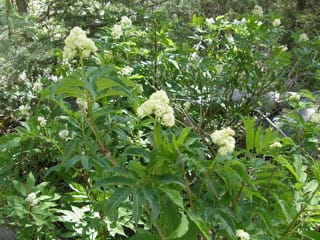 Photo: Chick Keller 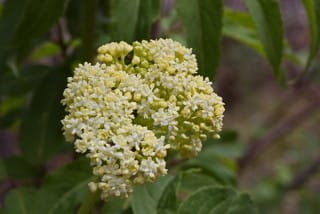 Photo: Craig Martin 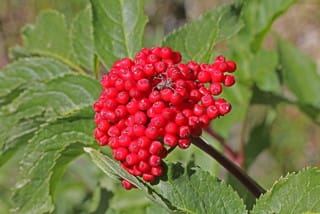 Photo: Jerry Oldenettel | Red Elderberry, Red Elder, Red-berried ElderSARA2 (Sambucus racemosa)Family: Adoxaceae (Moschatel) Size: up to 240 in (610 cm) Growth: shrub, tree; perennial Blooms: May 09 - Jul 22 Flower: simple; white; dome-shaped clusters of many tiny flowers; fragrant Leaf: dicot; opposite, pinnate-compound leaves with 5 to 7 leaflets Fruit: clusters of bright to dark red berries; seeds distributed by birds and mammals Status: native; locally common Habitat: mixed conifer --- woodland, wet meadow, prairie, field Typical location: Pajarito Canyon second crossing This plant is typically seen as a low-growing, shredding shrub. It sprouts from the root crown and/or rhizomes. The berries attract and are readily consumed by wildlife. In contrast, due to their sour taste, they and not usually eaten raw by humans but may used in the preparation of wine, jelly, and pies. Info Photos Distribution Tree Guide |
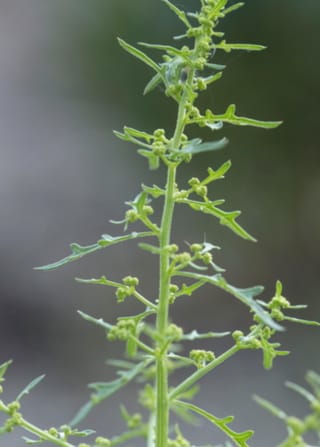 Photo: Craig Martin 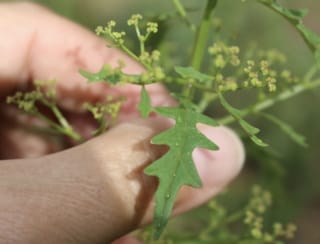 Photo: Lena Zappia 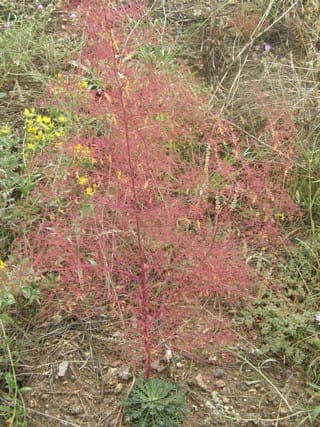 Photo: Chick Keller | Fetid GoosefootDYGR (Dysphania graveolens, Chenopodium graveolens)Family: Amaranthaceae (Amaranths) Size: up to 20 in (51 cm) Growth: forb/herb; annual Blooms: Sep 18 - Oct 31 Flower: simple; greenish-yellow; elongated, inconspicuous terminal clusters; no distinction between petal and sepals (tepals) Leaf: dicot; alternate arrangement with 1 leaf per node; lobed; toothed; aromatic and red in autumn Fruit: dry, spherical capsules that do not split open when ripe Status: native; common Habitat: ponderosa --- in shade of pines and junipers or occasionally in open dry plains and ridge tops Stems of the Fetid Goosefoot are erect with short hairs. The stems and branches turn color to bright red in fall. Calyx and leaves may have yellow dots of a resinous material. The plant is thought to have special powers by many Southwest native peoples. The Zunis carried it for protection again lightening while the Navajos used it to protect them in warfare. Info Photos Distribution Weed Guide |
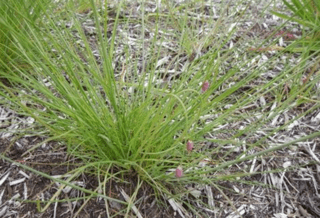 Photo: Kathleen Sayce 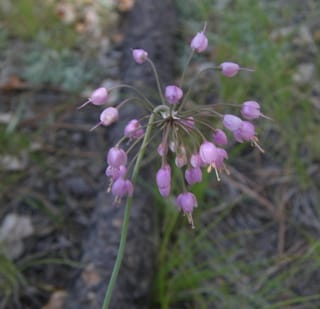 Photo: Chick Keller 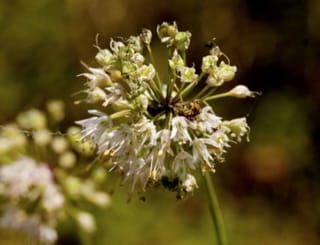 Photo: Patrick Alexander | Nodding OnionALCE2 (Allium cernuum)Family: Amaryllidaceae (Amaryllis) Size: 12 - 18 in (30 - 46 cm) Growth: forb/herb; perennial Blooms: Jun 27 - Oct 20 Flower: simple; pink or occasionally white; tiny bell-shaped blossoms in a loose nodding cluster Leaf: monocot; fragrant; long, narrow, and upright Fruit: spherical crested fruits that open to reveal brown seeds Status: native; common Habitat: ponderosa --- dry woods, rock outcroppings, prairies Typical location: Valle Canyon The plant has slender conical bulbs which taper directly into several grass-like leaves. Each bulb bears a single flower stem which terminates in a number of short flower stalks. Leaves and bulbs were once eaten but currently considered to be of little culinary value. Attracts hairstreak butterflies. Info Photos Distribution |
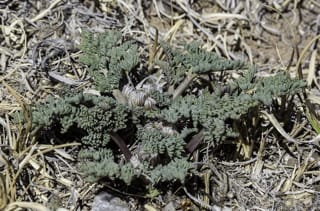 Photo: Craig Martin 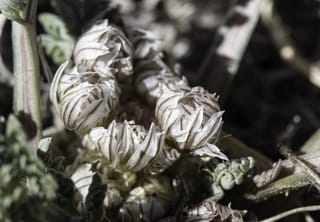 Photo: Craig Martin 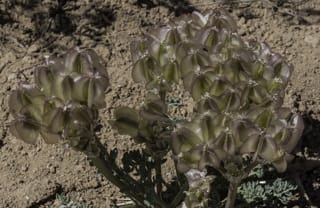 Photo: Craig Martin | Constance's Spring Parsley, Wafer ParsnipCYCO22 (Cymopterus constancei)Family: Apiaceae (Carrots) Size: up to 5 in (13 cm) Growth: forb/herb; perennial Blooms: Mar 15 - Apr 15 Flower: simple; white and pink; branched flower heads surrounded by papery bracts Leaf: dicot; gray-green; 3 to 5 pairs of lobed leaflets Fruit: made up of 5 tan to purplish wings that are clustered close together Status: native; uncommon Habitat: pinyon-juniper --- semi-desert, woodlands, shrublands Typical location: Overlook Park, White Rock Rim Trail Parsley-like leaves are tasty in spring salads. One can find all stages of development on the same plant. Info Photos Distribution |
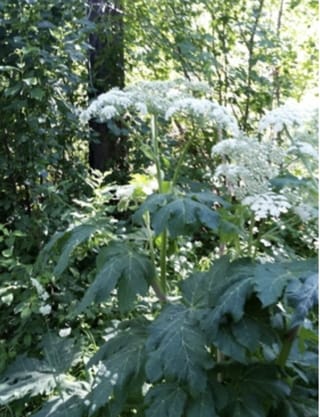 Photo: Craig Martin 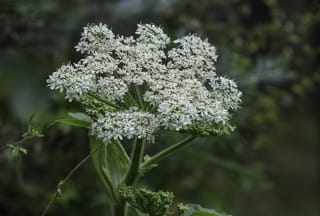 Photo: Craig Martin 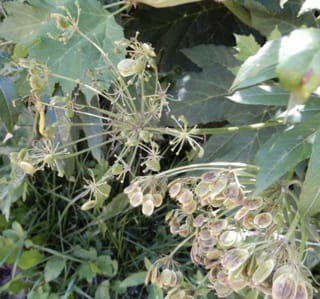 Photo: Ellen Hildebrandt | Common Cowparsnip, Cow Parsnip, American Cow-ParsnipHEMA80 (Heracleum maximum)Family: Apiaceae (Carrots) Size: up to 84 in (213 cm) Growth: forb/herb; perennial Blooms: Jun 21 - Sep 10 Flower: simple; white; large flat-topped clusters of small flowers; outer flowers tending to be larger than this closer to the center Leaf: dicot; very large leaves, often 12 inches (30 cm) across; 3 lobed leaflets; leaves smaller the further up the stem Fruit: oval, flat, wide seeds that smell like parsley Status: native; rare Habitat: riparian --- montane, subalpine, woodlands, meadows, streamsides While there are a large number of Heracleum species worldwide, Heracleum maximum is the only species that is native to North America and can be found from coast to coast. The juice of this aromatic plant contains a chemical that can cause irritation and potential blistering of the skin. Despite this, though, the young plant has been used by Native Americans for food and in a variety of medicinal treatments. Also the hollow plant stems can be made into a deer call. Info Photos Distribution |
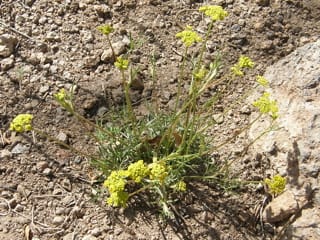 Photo: Chick Keller 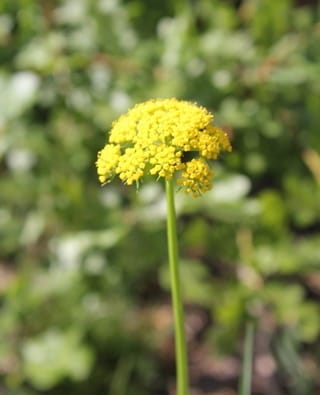 Photo: Terry Foxx | Alpine False Springparsley, Mountain ParsleyPSMO (Pseudocymopterus montanus, Cymopterus lemmonii)Family: Apiaceae (Carrots) Size: 12 - 20 in (30 - 51 cm) Growth: forb/herb; perennial Blooms: Apr 24 - Aug 15 Flower: simple; yellow; fan arrangement, round and flat topped on the tip of a long flowering stalk Leaf: dicot; very variable in leaf shape and size Fruit: oblong capsules with well-developed lateral wings and 2 seeds Status: native; common Habitat: mixed conifer, ponderosa --- foothills, montane, subalpine, woodlands, meadows Typical location: Valle Canyon The size and morphology of this plant depends on the elevation at which it is growing. It was originally classified in the genus Cymopterus or “waved wing” for which it is a close look alike. It is now classified as Pseudocymopterus or “False Cymopterus”. The roots and leaves of this plant have used as a food source by some Native Americans. Info Photos Distribution |
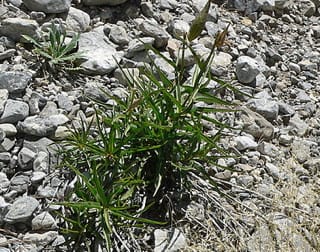 Photo: Stan Shebs 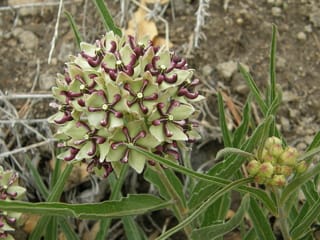 Photo: Chick Keller 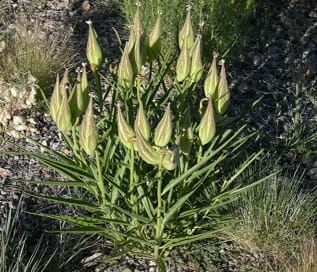 Photo: Jerry Oldenettel | Antelope Horn Milkweed, Spider Milkweed, Green-flowered MilkweedASAS (Asclepias asperula)Family: Apocynoideae (Dogbanes) Size: 12 - 24 in (30 - 61 cm) Growth: forb/herb; perennial Blooms: May 27 - Jul 19 Flower: simple; green and white; spherical flower clusters Leaf: dicot; lanceolate; open, airy network in alternate arrangement Fruit: growing seed follicles resemble antelope horns Status: native; uncommon Habitat: pinyon-juniper, ponderosa --- semi-desert, foothills, woodlands, openings, washes Plant can have either an upright or a sprawling habit. Stems are covered with minute hairs. Info Photos Distribution |
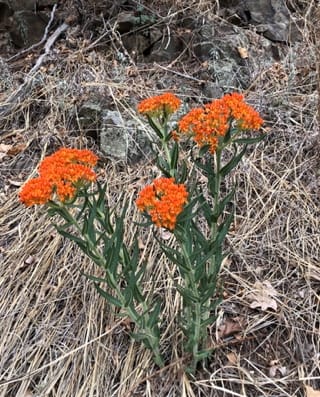 Photo: Christina M. Selby 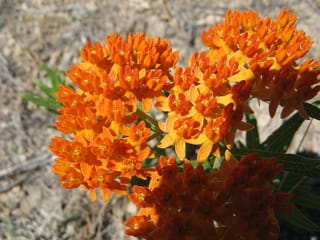 Photo: Janie O'Rourke 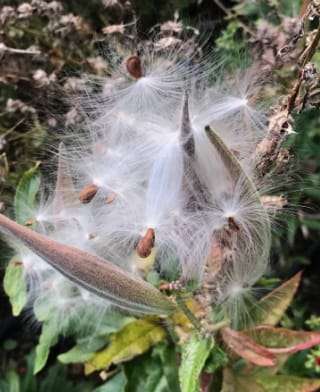 Photo: Sandy Wolkenberg | Butterfly Milkweed, Orange Milkweed, Pleurisy RootASTU (Asclepias tuberosa)Family: Apocynoideae (Dogbanes) Size: 18 - 24 in (46 - 61 cm) Growth: forb/herb; perennial Blooms: Jun 23 - Jul 17 Flower: simple; yellow-orange to bright orange; a showy flowerhead --- large flower cluster at the top of a stem Leaf: dicot; long, pointed, smooth on the edges; mostly alternative spacing Fruit: grayish-green pod covered in short hairs Status: native; rare Habitat: ponderosa --- semi-desert, canyon washes, roadsides Typical location: Upper Crossing Trail into Frijoles Canyon As the name implies, this plant attracts butterflies, in particular, monarchs and queens. Also attracts other pollinators like bumble bees and honey bees. Its tough root was chewed by Native Americans as a remedy for pulmonary ailments. Info Photos Distribution |
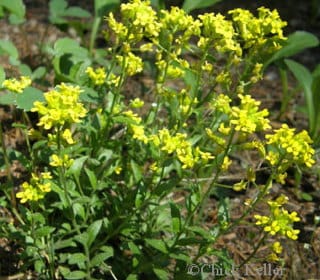 Photo: Chick Keller 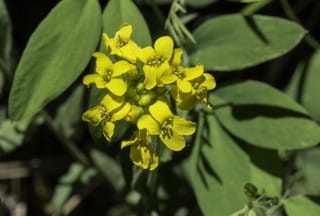 Photo: Craig Martin | Golden Draba, Golden WhitlowgrassDRAU (Draba aurea)Family: Arabideae (Mustards) Size: up to 8 in (20 cm) Growth: forb/herb; perennial Blooms: Jun 11 - Oct 31 Flower: simple; yellow; individual small flowers with 4 oblong petals with 4 sepals; compact flowerhead with up to 50 flowers Leaf: dicot; smooth-edged or toothed; very hairy; grow as a rosette at the base and along the stems Fruit: purplish green, hairy pods that are angled upwards Status: native; uncommon Habitat: mixed conifer --- montane, alpine, subalpine, meadows, woodlands Typical location: Canada Bonita Trail The Golden Draba was named by Martin Vahl in 1806 from a specimen collected in Greenland. The native range of this plant covers Arizona and New Mexico north through all of Canada and includes Alaska and Greenland. Plants in the genus Draba are commonly known as whitlow-grasses. However, they are not related to true grasses. Info Photos Distribution |
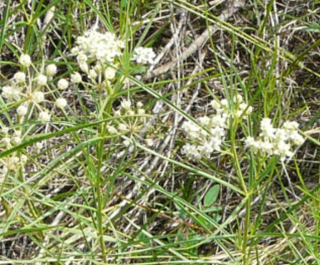 Photo: Becky Shankland 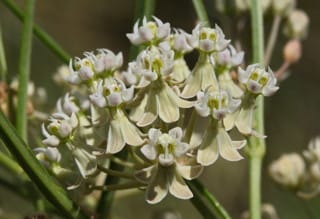 Photo: Craig Martin 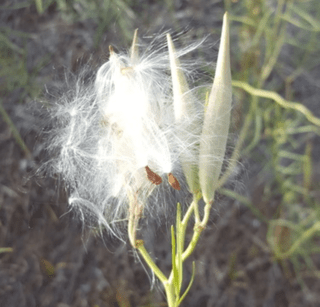 Photo: Alex Abair | Horsetail Milkweed, Poison Milkweed, Whorled MilkweedASSU2 (Asclepias subverticillata)Family: Asclepiadaceae (Milkweeds) Size: up to 40 in (102 cm) Growth: forb/herb; perennial Blooms: Aug 15 - Oct 01 Flower: simple; white and greenish white; small clusters on short stalks; 5 sepals below 5 larger petals Leaf: dicot; long and very narrow; grow in whorls at closely spaced intervals Fruit: long, thin pod-like fruit on a short stem; splits to release fluffy seeds Status: native; common Habitat: disturbed soil --- Seen along road edges. Typical location: White Rock The plant contains a milky sap that is neurotoxic and thus a hazard to livestock. However, it is a host plant for Monarch butterfly larvae and crucial to its survival. The fibers from partially ripe fruit pods have been used for weaving. Info Photos Distribution |
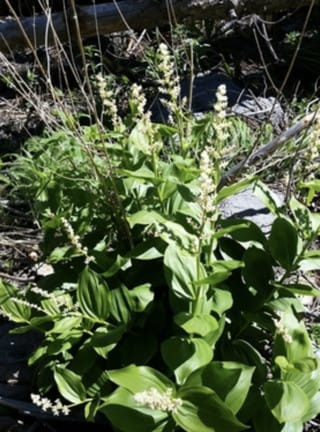 Photo: Chick Keller 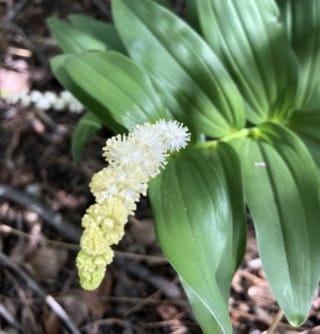 Photo: Christina M. Selby 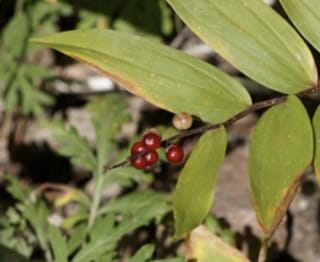 Photo: Ilja Fescenko | Feathery False Lily of the Valley, Feathery False Solomon's SealMARA7 (Maianthemum racemosum)Family: Asparagaceae (Asparagus) Size: up to 5 in (13 cm) Growth: forb/herb; perennial Blooms: May 24 - Jun 30 Flower: simple; white; branched pyramid-shaped cluster at the end of the stem Leaf: monocot; lance-shaped with pointed tips; most are stalkless Fruit: green berries that turn dull red and then bright red Status: native; uncommon Habitat: mixed conifer --- montane, subalpine, woodlands Typical location: Valle Canyon This “False Solomon’s Seal” is distinguished from the “True Solomon’s Seals” by the flowers which are located at the end of the stem for the former and below the leaves along the stem for the latter. It is a shade-loving plant. Info Photos Distribution |
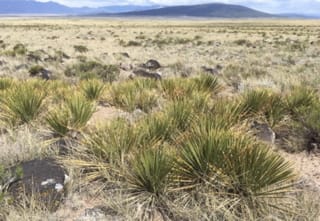 Photo: Patrick Alexander 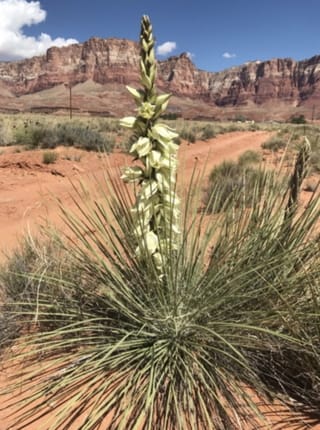 Photo: Mateo Boneo 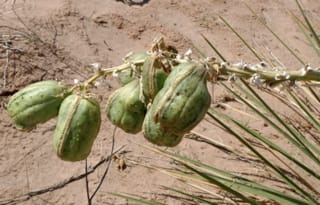 Photo: sea-kangaroo | Narrowleaf Yucca, Narrow-leaf Yucca, Fine-leaf YuccaYUAN2 (Yucca angustissima)Family: Asparagaceae (Asparagus) Size: up to 72 in (183 cm) Growth: forb/herb, shrub; perennial Blooms: Apr 30 - Jun 01 Flower: simple; white, sometimes with green or brown tints; form along an unbranched, 3 to 6 ft (1 to 2 m) tall stalk Leaf: monocot; dark green; long, thin and narrow; topped with a needle-like spine Fruit: erect green capsules turning brown and eventually spitting open large white to brown pod Status: native; uncommon Habitat: pinyon-juniper --- sandy soils and rocky hillsides up to 7,000 ft (2,100 m) These plants may remain as a solitary roster or develop a short stems and form large clusters. There are long, curling, white filaments grow from the edges of the leave. The Narrowleaf Yucca is pollinated by the yucca moth. The larvae of this moth feeds on the seeds of the plant. It has been used by Native Americans to treat snake and insect bites. Info Photos Distribution |
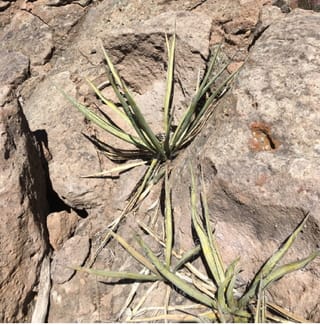 Photo: Parker Hopkins 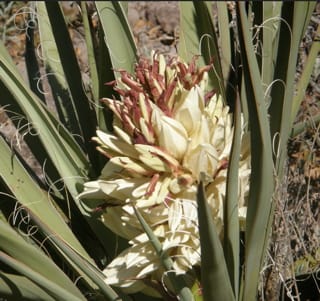 Photo: Yvonne Keller 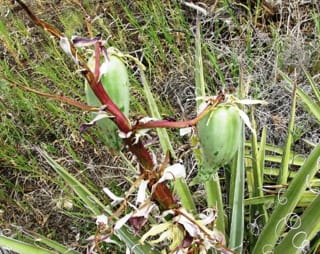 Photo: John Brew | Banana Yucca, Broad Leave YuccaYUBA (Yucca baccata)Family: Asparagaceae (Asparagus) Size: 36 - 60 in (91 - 152 cm) Growth: forb/herb, subshrub; perennial Blooms: Apr 23 - Jun 23 Flower: simple; white tinged with red; large cluster hanging from a single, tall stem Leaf: monocot; sword-shaped; thick and rigid; spine-tipped Fruit: green to dark purple; banana-like in shape Status: native; common Habitat: pinyon-juniper --- semi-desert, foothills, woodlands, canyons, openings Typical location: Deer Trap Mesa This is the New Mexico state flower. The leaves were used for cord, the roots for soap, and the flower and fruit for food. Info Photos Distribution |
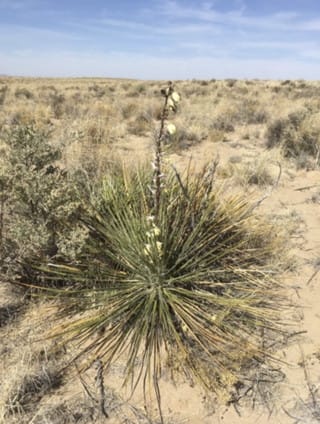 Photo: Patrick Alexander 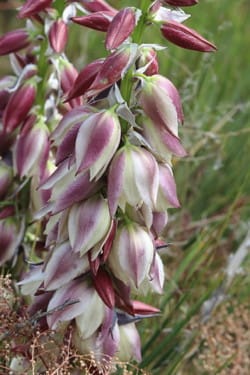 Photo: Craig Martin 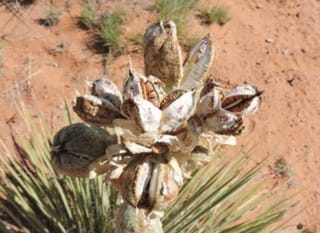 Photo: CW Wood | Navajo YuccaYUBAN (Yucca baileyi, Yucca navajoa)Family: Asparagaceae (Asparagus) Size: up to 72 in (183 cm) Growth: forb/herb, subshrub; perennial Blooms: May 19 - Jun 26 Flower: simple; white with purplish; grown on the end of very tall stalk Leaf: monocot; evergreen; long, thin, pointed leaves Fruit: large white to brown pod Status: native; common Habitat: pinyon-juniper --- mountains, adjacent woodlands and grasslands Typical location: Canyon Rim Trail paved section Yucca baileyi is quite similar to several other species of yucca in the area but can be distinguished by its tendency to grow in tight colonies at higher elevations than other yuccas. Fibers used for making various items. The roots can be used to make soap. Info Photos Distribution |
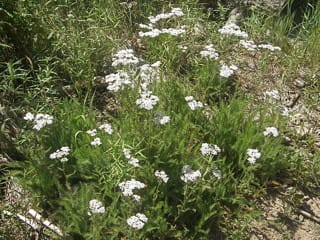 Photo: Chick Keller 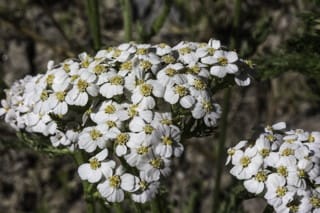 Photo: Craig Martin | Common Yarrow, Western Yarrow, MilfoilACMI2 (Achillea millefolium)Family: Asteraceae (Daisies) Size: up to 20 in (51 cm) Growth: forb/herb; perennial Blooms: Jun 08 - Sep 10 Flower: composite; white with yellow center; flat-topped or dome-shaped flowerhead clusters; long lasting Leaf: dicot; long leaflets in an alternate arrangement; further leaflet divisions give fern-like appearance; strong spicy aroma Fruit: capsules with thick margins and no hairs Status: naturalized plant; common Habitat: ponderosa --- semi-desert, foothills, montane, subalpine, meadows, woodlands, shrublands The Common Yarrow was introduced into North America from Europe and Asia during colonial times. It has since been naturalized throughout the US. It is a common cultivar and can be seen in gardens in a range of colors including reds and yellows. The genus Achillea was named for Achilles who treated soldiers’s wound during the Trojan War. In fact, Common Yarrow has a variety of medicinal uses including the treatment of wounds, burns, colds, fevers, and headaches. It has even been made into a beer. Info Photos Distribution |
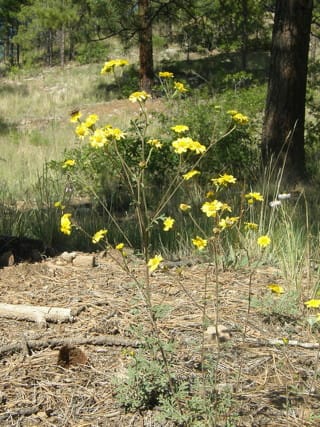 Photo: Chick Keller 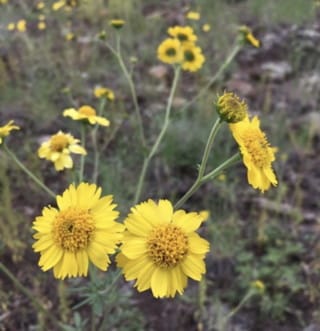 Photo: Patrick Alexander | Ragleaf Bahia, Wirey Bahia, Sunray DaisyBADI (Amauriopsis dissecta, Bahia dissecta)Family: Asteraceae (Daisies) Size: up to 30 in (76 cm) Growth: forb/herb; annual, biennial, perennial Blooms: Aug 18 - Oct 31 Flower: composite; yellow; rounded petals that are slightly notched; ray florets overlap and slightly shorter than the central disc florets Leaf: dicot; small, oblong, and deeply lobed; mostly located near base of stem Fruit: Ragleaf Bahia has an open, airy growth pattern with spindly, branching and erect stems. The upper ends of the stems often curve, pointing downwards. Augustus Fendler was the first to collect this species near the Mora River in New Mexico about 1846. Status: native; common Habitat: disturbed soil, pinyon-juniper, ponderosa --- foothills, montane, disturbed areas, meadows Ragleaf Bahia has an open, airy growth pattern with spindly, branching and erect stems. The upper ends of the stems often curve, pointing downwards. Augustus Fendler was the first to collect this species near the Mora River in New Mexico about 1846. Info Photos Distribution |
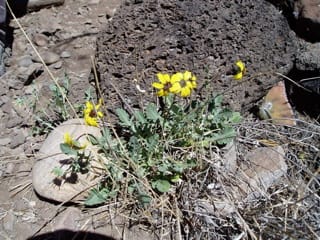 Photo: Kathy Gillespie 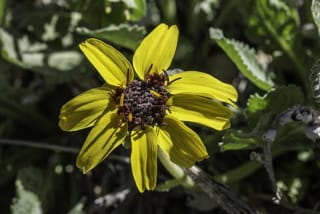 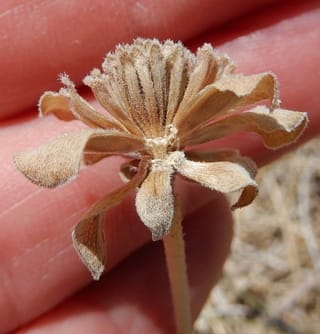 Photo: Ellen Hildebrand | Lyreleaf Greeneyes, Chocolate Flower, Chocolate DaisyBELY (Berlandiera lyrata, Berlandiera incisa)Family: Asteraceae (Daisies) Size: 12 - 24 in (30 - 61 cm) Growth: forb/herb; perennial Blooms: May 03 - Sep 30 Flower: composite; yellow rays with brown centers and green cup-like bracts; rays have red veins on reverse side Leaf: dicot; gray-green; pinnate, deeply-lobed leaves with lyre-shaped curves; velvety Fruit: cup-like seedheads Status: native; uncommon Habitat: pinyon-juniper --- dry, well-drained sites, sandy or rocky soils, roadsides, grasslands with mesquite, oak, and juniper Typical location: Red Dot Trail near bottom The common name of lyreleaf greeneyes comes from the shape of the leaf and the green eye-like disc left after the ray florets drop off. The "chocolate" scent of the flower is responsible for its other common names. In addition, the stamens are edible and have a chocolate flavor. The plant seems to disappear when it freezes but the roots are alive and will remain dormant until spring. Info Photos Distribution |
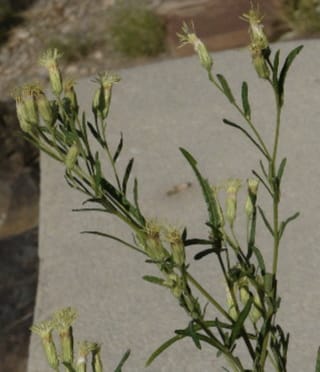 Photo: Becky Shankland 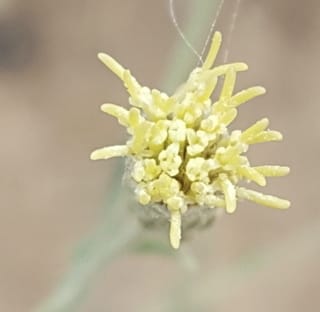 Photo: Alex Abair 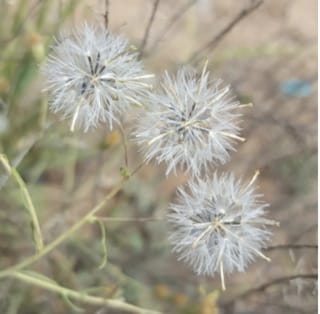 Photo: Alex Abair | False BonesetBREU (Brickellia eupatorioides, Kuhnia chlorolepis)Family: Asteraceae (Daisies) Size: up to 80 in (203 cm) Growth: forb/herb, subshrub; perennial Blooms: Jun 15 - Sep 30 Flower: composite; white to yellow; clusters of flowerheads at branch tips; ray florets absent; 3 - 35 disc florets per head; prominent styles Leaf: dicot; long, linear to lanceolate blades with prominent center vein; alternate arrangement; closely spaced Fruit: dark brown, ribbed achenes with minute hairs Status: native; uncommon Habitat: disturbed soil --- Road edges and trails. Typical location: White Rock False Boneset is actually more showy after the flowers go to seed in little white puffs. Its foliage is bitter and has little nutritional value, so mammalian herbivores, including livestock, only browse on it when there is little else available. Various types of bees and butterflies visit flowerheads for nectar and/or pollen. The caterpillars of some moths feed on flowerheads and developing seeds. Info Photos Distribution |
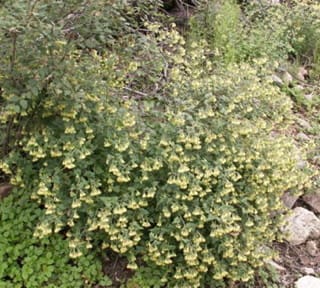 Photo: Chick Keller 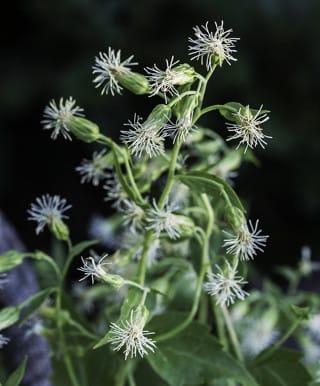 Photo: Craig Martin 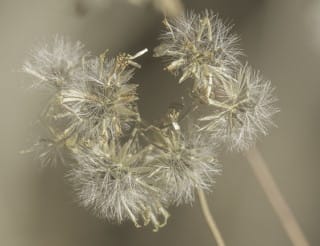 Photo: Craig Martin | Tasselflower Brickellbush, Mountain BrickellbushBRGR (Brickellia grandiflora)Family: Asteraceae (Daisies) Size: 12 - 38 in (30 - 97 cm) Growth: forb/herb, subshrub; perennial Blooms: Aug 25 - Oct 20 Flower: composite; pale yellow to light green; thin, tubular disc florets; stamen and style protrude beyond florets; clusters hanging from short branches Leaf: dicot; slightly hairy with enlarged gland at tip; triangular leaves with pointed tip Fruit: small, dark, bristly capsules Status: native; common Habitat: mixed conifer --- rocky hillsides, shaded forests, dry slopes, canyons, banks, cliffs, roadsides Tasselflower Brickellbush is often overlooked but can be found if one looks in its favorite rocky habitat. The plant takes its name from Dr. John Brickell, an early American physician and naturalist. Brickellia grandiflora is distinguished from others in the same genus but its leaf shape and the the nodding of its flower clusters. It is a host for the rust fungus Puccini’s subdecora. A tea made from this plant has 3 uses: lowering blood sugar, stimulating stomach secretion, and stimulating bile synthesis. Info Photos Distribution |
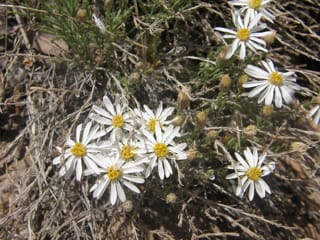 Photo: Chick Keller 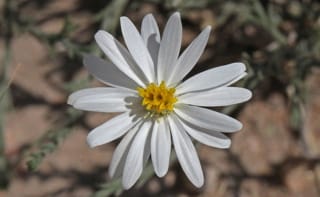 Photo: Jerry Oldenettel Photo: | Rose Heath, Sand Aster, Smallflower AsterCHER2 (Chaetopappa ericoides)Family: Asteraceae (Daisies) Size: 2 - 5 in (5 - 13 cm) Growth: forb/herb, subshrub; perennial Blooms: May 19 - Jun 19 Flower: composite; white; small radiate flowerheads; single head on a stem; immature flowers have pink tinge Leaf: dicot; green; small and sparse; alternative spacing; may have bristles on edges Fruit: numerous small, flattened, hairy fruit is tipped with numerous minute, white, barbed bristles Status: native; locally common Habitat: pinyon-juniper --- semi-desert, shrublands, open areas Typical location: Deer Trap Mesa This plant grows in clumps with many, woody and hairy stems. Flower petals commonly curl downward in the evening and straighten with morning. An infusion made from the whole plant was used for rheumatism. Info Photos Distribution |
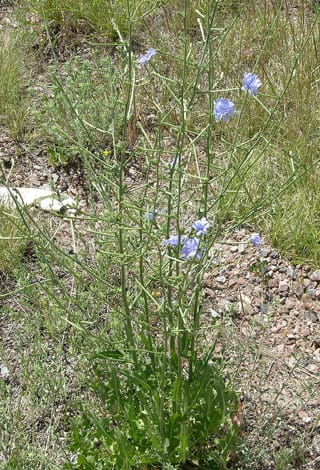 Photo: Jerry Oldenettel 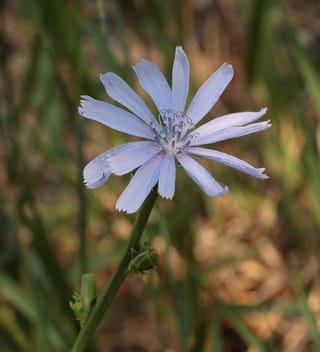 Photo: Craig Martin 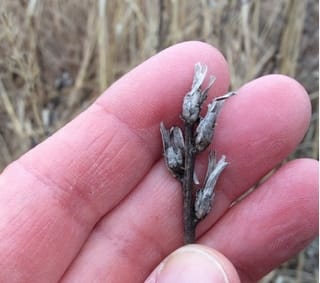 Photo: Sheri | Chicory, Common ChicoryCIIN (Cichorium intybus)Family: Asteraceae (Daisies) Size: 10 - 40 in (25 - 102 cm) Growth: forb/herb; biennial, perennial Blooms: Aug 05 - Aug 31 Flower: composite; blue to purple; petals have toothed squared off ends; form clusters on the upper branches; blooms in the morning and closes later in the day Leaf: dicot; lance-shaped; small, sparse, alternate spacing; margins either smooth or slightly toothed Fruit: long, dark brown and wedge shaped; contains one seed Status: naturalized plant; uncommon Habitat: disturbed soil --- foothills, fields, disturbed areas Typical location: White Rock Introduced from Europe. The leaves of the plant resemble those of dandelion but they are larger and darker green. Primarily found at lower elevations. Cultivated varieties of Chicory are used in cooking. Info Photos Distribution |
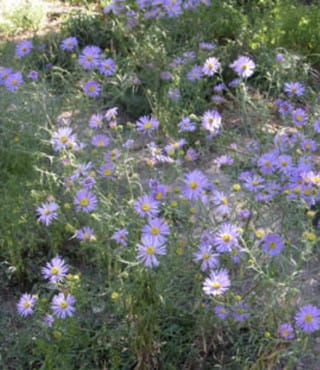 Photo: Jennifer Macke 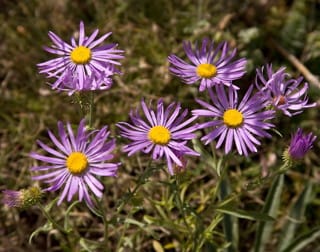 Photo: Mary Carol Williams 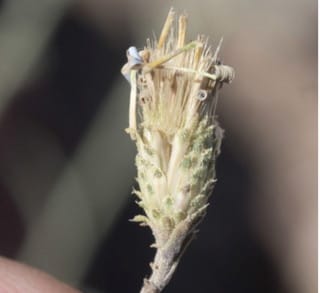 Photo: twr61 | Hoary Tansyaster, Purple Aster, Hoary AsterMACA2 (Dieteria canescens, Machaeranthera canescens)Family: Asteraceae (Daisies) Size: up to 40 in (102 cm) Growth: forb/herb; annual, biennial, perennial Blooms: Sep 10 - Nov 07 Flower: composite; blue/purple and yellow; ray florets appear as if floating; numerous bracts below Leaf: dicot; small and oblong; covered with fine hair; serrated edges Fruit: achene (one-seeded fruit) topped with bristles Status: native; common Habitat: disturbed soil, pinyon-juniper --- foothills, montane, subalpine The stems are slender, green, and erect. The daisy-like flowers are commonly found with numerous insects. The species of canescens is Latin for “becoming gray” and is used to describe the abundance of hairs on many of the plants. This is also reflected in the “hoary” portion of many of the plant’s common names. However, some Dieteria canescens are hairless. Info Photos Distribution Weed Guide |
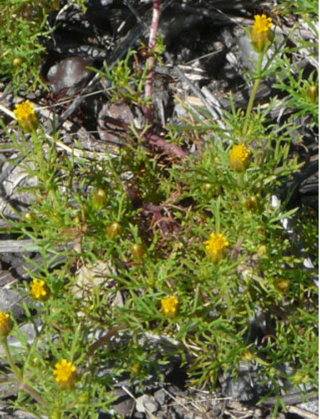 Photo: Becky Shankland 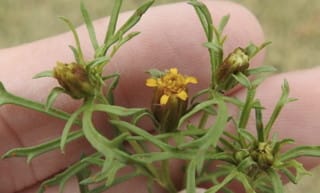 Photo: Sam Kieschnick 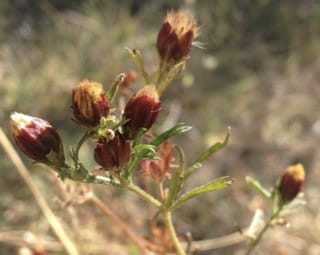 Photo: bodo | Fetid Marigold, DogweedDYPA (Dyssodia papposa)Family: Asteraceae (Daisies) Size: up to 15 in (38 cm) Growth: forb/herb; annual Blooms: Aug 01 - Oct 03 Flower: composite; yellow and bell-shaped; 8 short ray florets and about 5 spreading disc florets; clusters of single heads on flowering stalk Leaf: dicot; deeply divided linear lobes; few teeth on edges; mostly hairless; opposite orientation Fruit: small achene topped with bristles Status: native; locally common Habitat: disturbed soil --- Road and trail edges Typical location: White Rock Fetid Marigold foliage is dotted with orange-brown spots which produce a pungent odor, considered to be unpleasant by many, when the leaves are crushed. For this reason, some consider the plant to be a weed and is the origin of the plant’s scientific genus which means 'ill=smelling'. Despite this, several uses for the plant have been identified including as a food in bread and for relief of gastrointestinal distress. Info Photos Distribution |
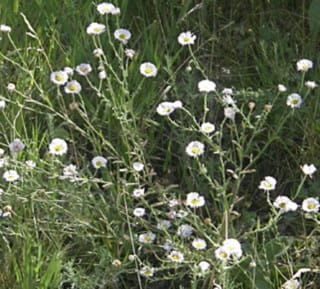 Photo: Chick Keller 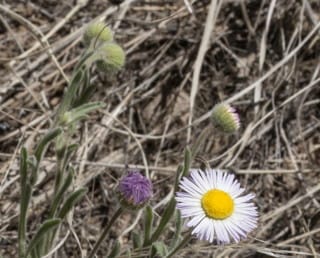 Photo: Craig Martin | Spreading Fleabane, Rough Fleabane, Branching Fleabane, Fleabane DaisyERDI4 (Erigeron divergens)Family: Asteraceae (Daisies) Size: 5 - 30 in (13 - 76 cm) Growth: forb/herb; biennial Blooms: Sep 03 - Oct 31 Flower: composite; varies from white to pale pink up to 150 ray florets; twice that number of yellow disc florets; buds are deep pink Leaf: dicot; covered in short, thin grey-white hairs; leaf color and dimensions can be variable Fruit: capsules with scales and a sparse number of hairs Status: native; common Habitat: mixed conifer, mountain meadow, oak woodland, pinyon-juniper, ponderosa --- foothills, montane, meadows, disturbed areas Spreading Fleabane has many branches with dense hair and tends to grow in open cluster. This species of fleabane can display agamospermy, reproducing asexually via seed. The Navajos had many medical uses for the plant. Whereas, the Kiowa people considered it a good luck charm. Info Photos Distribution |
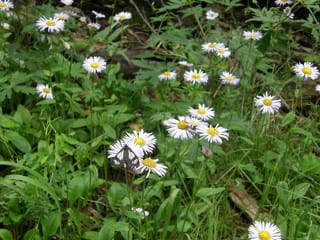 Photo: Chick Keller 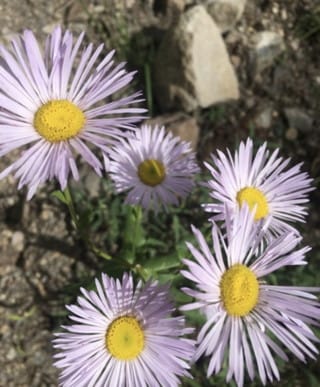 Photo: Holly Giorgio-Dundon | Sprucefir Fleabane, Regal Daisy, Splendid DaisyEREX4 (Erigeron eximius)Family: Asteraceae (Daisies) Size: up to 24 in (61 cm) Growth: forb/herb, subshrub; perennial Blooms: Aug 01 - Oct 31 Flower: composite; purple to white with yellow; flowering stalk has between 1 to 5 heads with numerous disc florets each with 40 to 80 ray florets Leaf: dicot; large number of broad leaves around base; lesser numbers along the stem; edges variable from smooth to small teeth to large teeth Fruit: hairy archenes with long bristles Status: native; common Habitat: mixed conifer --- montane, woodlands Typical location: Canada Bonita Trail The plant spreads by underground roots producing a mass of leaves. However, very few of the leaf clusters produce flowers. It is often overlooked, even though, it can be abundant in an area. Info Photos Distribution |
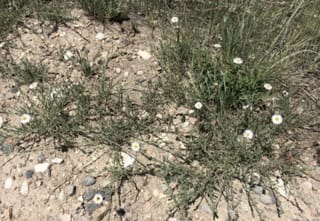 Photo: Susan Punjabi 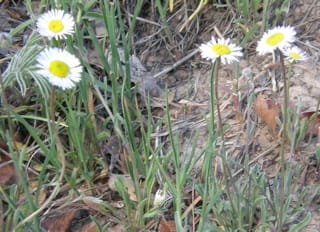 Photo: Chick Keller | Trailing Fleabane, Whiplash DaisyERFL (Erigeron flagellaris)Family: Asteraceae (Daisies) Size: up to 8 in (20 cm) Growth: forb/herb; biennial Blooms: May 30 - Oct 31 Flower: composite; white and yellow with blush of pink; as many as 125 white ray florets; numerous yellow disc florets Leaf: dicot; light green; narrow; numerous arranged in clusters Fruit: tufted single seeds Status: native; common Habitat: mixed conifer, ponderosa --- foothills, montane, subalpine, meadows Typical location: Water Canyon Plant sends out runners along the surface of the ground to colonize large areas., forming extensive mats of clones. Tied bunches of plants used for brooms. Leaves used as a medicine and fumigant. Info Photos Distribution |
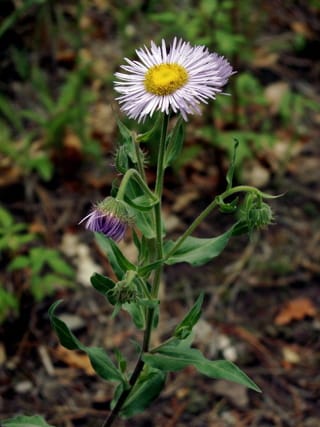 Photo: Chick Keller 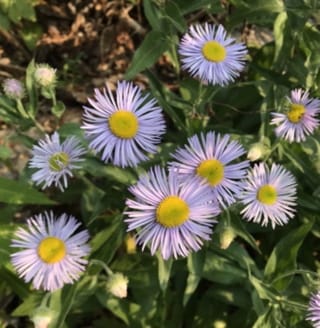 Photo: Nat Warning | Aspen Fleabane, Showy FleabaneERSP4 (Erigeron speciosus)Family: Asteraceae (Daisies) Size: up to 40 in (102 cm) Growth: forb/herb; perennial Blooms: Jul 12 - Oct 31 Flower: composite; ray florets vary from lavender to white with yellow disc florets; ray florets are long and narrow; there may be up to 150 per flowerhead Leaf: dicot; lnceolate leaves with a prominent vein Fruit: 2-veined capsule Status: native; common Habitat: ponderosa --- subalpine, montane, open areas There are six common (and a few more uncommon) Erigeron in the area. This species is one of the most common. It has certainly earned one of its common names (Showy Fleabane) with its abundant display of flowers. The stems are reddish-green and usually hairless. Info Photos Distribution |
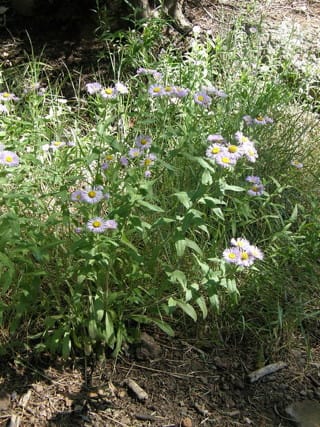 Photo: Chick Keller 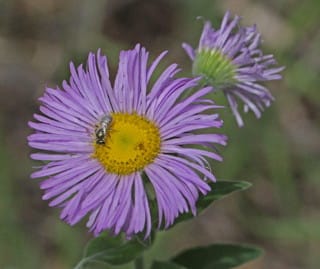 Photo: Jerry Oldenettel | Three-nerve Fleabane, Hairy Showy Daisy, Threenerve FleabaneERSU2 (Erigeron subtrinervis)Family: Asteraceae (Daisies) Size: up to 36 in (91 cm) Growth: forb/herb; perennial Blooms: Aug 01 - Oct 31 Flower: composite; shades of blue/purple with yellow center; 100 to 150 thin ray florets around a large number of disc florets; there may be a single flowerhead or up to 20 in a flat-topped array Leaf: dicot; lance-shaped leaves with fine hairs along the margins and both surfaces; 1 central prominent vein and 2 others Fruit: capsule sparsely covered in bristles Status: native; common Habitat: mixed conifer, ponderosa --- montane, subalpine, meadows Erigeron subtrinervis is distinguished from others of its genus by the fact it is the only species where the surfaces of its leaves have fine hairs. The plant has a short, woody base with a large number of leafy stems. It, like other Fleabanes, derived its common name from the belief that the dried pants would repel fleas. Info Photos Distribution |
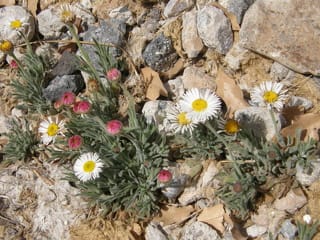 Photo: Chick Keller 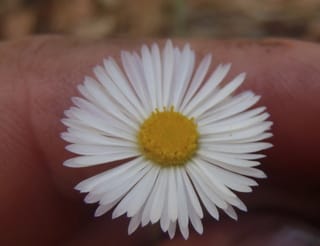 Photo: Dan Beckman | Running Fleabane, Running Daisy, Tracy's FleabaneERCO28 (Erigeron tracyi, Erigeron colomexicanus )Family: Asteraceae (Daisies) Size: 6 - 12 in (15 - 30 cm) Growth: forb/herb; biennial Blooms: Feb 01 - Dec 01 Flower: composite; white with yellow center, may have purple color on edges; a single flowerhead per stem made up of 100 ray florets and over 200 disc florets Leaf: dicot; basal leaves close together and wider toward the tip; stem leaves few and narrow; hairy Fruit: archenes topped with bristles Status: native; common Habitat: pinyon-juniper --- foothills, open areas, and woods Typical location: Red Dot Trail Spreads via runners during summer and fall. Similar in overall appearance to Spreading Fleabane but has runner similar to Whiplash Daisy. Info Photos Distribution |
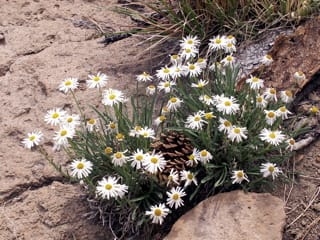 Photo: Chick Keller 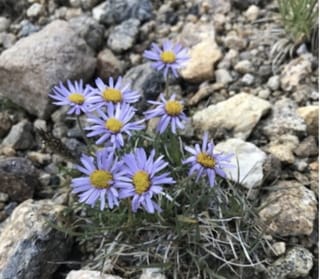 Photo: deeklyn | Early Bluetop Fleabane, Early FleabaneERVE2 (Erigeron vetensis, Erigeron porteri)Family: Asteraceae (Daisies) Size: up to 20 in (51 cm) Growth: forb/herb; perennial Blooms: Apr 24 - May 31 Flower: composite; pale blue to purple, sometimes white; rays surrounding yellow disc florets; 1 flowerhead per stem Leaf: dicot; linear to oblong; smaller as move away from the plant center Fruit: cypsela - single seeded fruit Status: native; uncommon Habitat: ponderosa --- foothills, montane, subalpine Typical location: Kinnikinnick Park This fleabane grows in small clumps in open, dry areas. The plant is covered with sparse hairs. Info Photos Distribution |
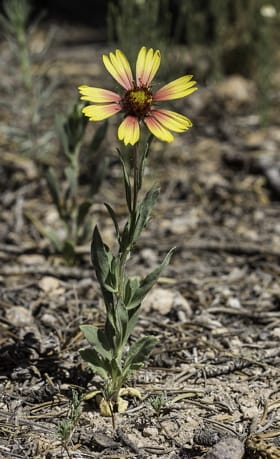 Photo: Craig Martin 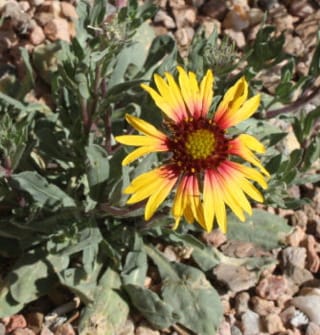 Photo: Akkana Peck 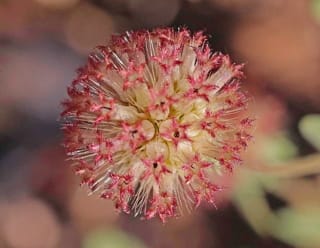 Photo: Jerry Oldenettel | Indian Blanket, Firewheel, Indian Blanketflower, SundanceGAPU (Gaillardia pulchella)Family: Asteraceae (Daisies) Size: 18 - 24 in (46 - 61 cm) Growth: forb/herb, subshrub; annual, biennial, perennial Blooms: May 05 - Oct 15 Flower: composite; ray florets red to orange at base with yellow tips; sometimes all yellow or orange; disc florets are reddish-brown Leaf: dicot; alternate arrangement; long, wide and toothed Fruit: seedhead with pyramid-shaped cypselae and multiple hairs and scales Status: native; common Habitat: disturbed soil, pinyon-juniper --- roadsides, meadows, dry plains, open areas Typical location: White Rock This is a hardy plant, tolerating heat and dryness. Many varieties are popular for cultivation providing a showy splash of color to the garden. The plant is favored by honeybees and produces a dark reddish buttery tasting honey. It also attracts butterflies. The roots can be used to make a tea. Info Photos Distribution |
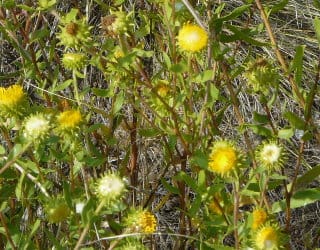 Photo: Becky Shankland 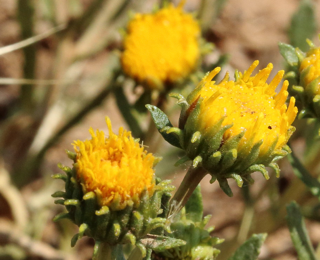 Photo: Craig Martin | Curlycup Gumweed, Curly-cup Gumweed, Rosinweed, TarweedGRSQ (Grindelia squarrosa)Family: Asteraceae (Daisies) Size: 3 - 36 in (8 - 91 cm) Growth: forb/herb; annual, biennial, perennial Blooms: Jun 01 - Oct 10 Flower: composite; yellow; daisy-like, medium sized multiple heads with many disc florets but with or without ray florets; “curlycup” comes from distinctive recurved bracts that enclose the flowerheads Leaf: dicot; green to gray-green linear leaves; margins smooth or toothed Fruit: short whitish to brown or gray capsules Status: native; uncommon Habitat: disturbed soil --- Road edges, especially in White Rock. Typical location: White Rock The plant, including the flower heads, produces a sticky, gummy resin; thus the origin of many of its common names. Curlycup Gumweed concentrates selenium giving it a very bitter taste and making it toxic to mammals. This plant is being studies as a potential source of biofuel to to its high content of several terpene compounds that can be converted to a fuel analogues to kerosene. It is an attractive plant for this use since it would not compete for areas used for traditional food crops. Info Photos Distribution Weed Guide |
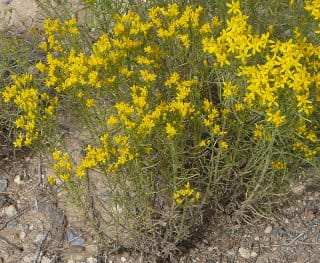 Photo: Becky Shankland 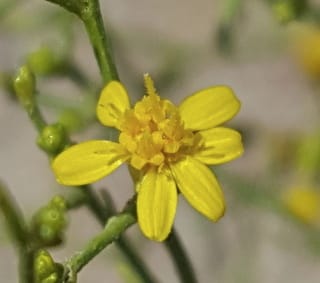 Photo: Alex Abair 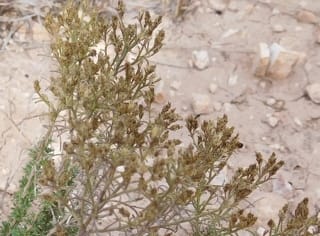 Photo: Ellen Hildebrandt | Broom Snakeweed, Matchbrush, Broomweed, KindlingweedGUSA2 (Gutierrezia sarothrae)Family: Asteraceae (Daisies) Size: 8 - 28 in (20 - 71 cm) Growth: forb/herb, subshrub; perennial Blooms: Sep 01 - Oct 31 Flower: composite; yellow; ray florets that are not symmetrical; tiny tuffs growing at the end of branches; Leaf: dicot; yellow-green; thread-like; lower leaves may have dropped by the time of flowering shed Fruit: oval and covered with chaffy scales; seeds brown and hairy Status: native; common Habitat: pinyon-juniper --- semi-desert, foothills, openings, roadsides Its name is derived by the fact that the dried stems were originally used as a broom. This plant is often confused with Rabbitbrush (genus Chrysothamus), but the two can be distinguished by their flowers (Broom Snakeweed - ray flowers; Rabbitbush - tubular flowers). Info Photos Distribution |
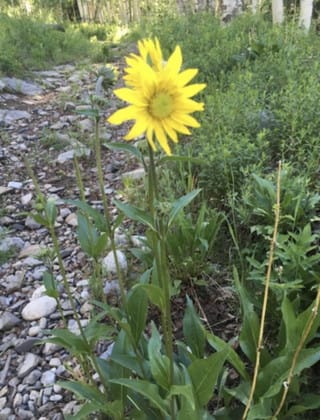 Photo: JA Bain 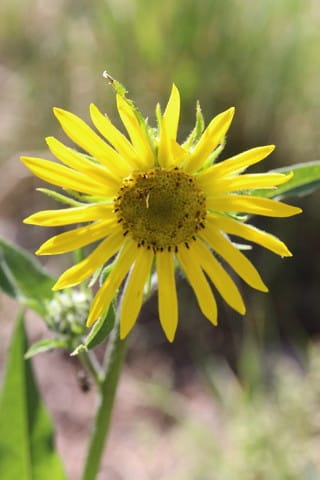 Photo: Craig Martin | Fivenerve Helianthella, Nodding Dwarf Sunflower, Nodding Helianthella, Wood SunflowerHEQU2 (Helianthella quinquenervis)Family: Asteraceae (Daisies) Size: up to 60 in (152 cm) Growth: forb/herb; perennial Blooms: Jul 14 - Aug 18 Flower: composite; yellow; 1 flowerhead per stem, hanging slightly; 8-21 bright yellow rays surrounding numerous darker yellow disc florets Leaf: dicot; pointed, narrow but long; lance-shaped; 3 to 5 prominent veins; numerous basal leaves, few stem leaves Fruit: small dark brown capsules with short hairs Status: native; uncommon Habitat: montane --- subalpine, woodlands, streamsides Typical location: Camp May, Canada Bonita The genus name of Helianthella is a diminutive form of the closely related sunflower genus Helianthus . Helianthella quinquenervis has been known as the “Little Sunflower” despite the fact that it quite tall and its flowers can be up to 4 in (10 cm) across. The plant can be most often seen scattered about the landscape. Info Photos Distribution |
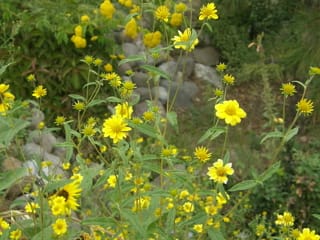 Photo: Chick Keller 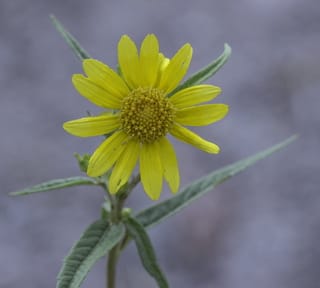 Photo: Craig martin | Showy GoldeneyeHEMU3 (Heliomeris multiflora)Family: Asteraceae (Daisies) Size: 12 - 48 in (30 - 122 cm) Growth: forb/herb, subshrub; perennial Blooms: Jul 19 - Oct 31 Flower: composite; yellow; 5 to 14 ray florets with a small notch at the tip; 50+ disc florets; disc florets dome as mature Leaf: dicot; long, thin, lance-shaped; strong center vein with lesser veins on the edges; may have small teeth Fruit: black or gray capsules Status: native; locally common Habitat: mixed conifer --- foothills, montane, subalpine One plant can produce 25 or more flower heads. The flowers start out greenish, gradually turning yellow. The stems are reddish, with faint markings and short hairs. It grows in bush clumps and can be quite spectacular in the fall. Info Photos Distribution |
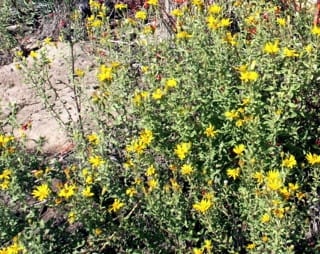 Photo: Chick Keller 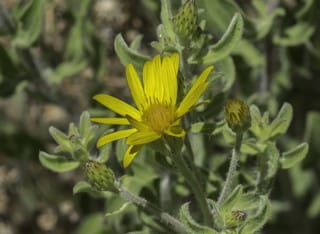 Photo: Craig Martin 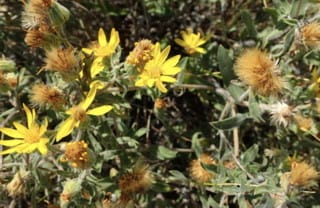 Photo: M Feaver | Hairy False Goldenaster, False Hairy Golden-Aster; Hairy False Golden AsterHEVI4 (Heterotheca villosa)Family: Asteraceae (Daisies) Size: 12 - 36 in (30 - 91 cm) Growth: forb/herb, subshrub; perennial Blooms: Jun 27 - Oct 31 Flower: composite; yellow with orange center; branched cluster of up to 15 flowers; 10 to 20 ray florets; 20 to 50 disc florets; corollas have a 5-lobed lip Leaf: dicot; greyish-green; small, narrow, and lance-shaped; grow densely; often have wavy edge; alternate arrangement Fruit: head of dry seeds with tufts of light brown hairs Status: native; common Habitat: pinyon-juniper, ponderosa --- semi-desert, foothills, montane, openings, disturbed areas Typical location: Quemazon Trail Hairy False Goldenaster blooms throughout the summer until snowfall with the flowers giving a bushy appearance. Its species name of villosa means “covered with soft hairs” flowing from the fact that the stems are covered with rough, grayish hairs. The plant has a spicy-sharp sage aroma. There are two different shaped seeds which is unusual for sunflowers. Info Photos Distribution |
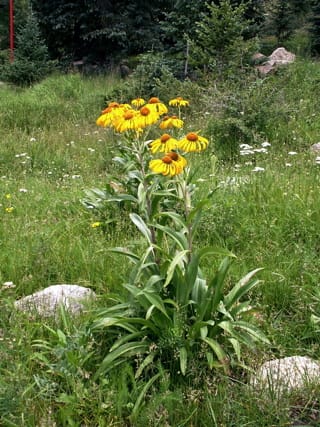 Photo: Chick Keller 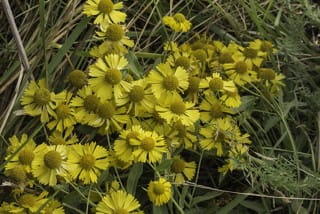 Photo: Craig Martin | Owl's Claws, Owlsclaws, Sneezeweed, Orange Sneezeweed,HYHO (Hymenoxys hoopesii)Family: Asteraceae (Daisies) Size: 12 - 18 in (30 - 46 cm) Growth: forb/herb; perennial Blooms: Jun 26 - Sep 10 Flower: composite; yellow to orange; 14 to 26 long ray florets surrounding a slightly raised disc; clusters with several flowerheads Leaf: dicot; lower leaves oblong; upper leaves lance-shaped; prominent central white vein Fruit: narrow oblong to pyramidal-shaped capsule with sharp scales Status: native; locally common Habitat: montane, mountain meadow --- montane, subalpine, alpine, meadows Typical location: Canada Bonita Found at higher elevations. The stems of this plant are white and woody below the flowers. Despite its name, the plant does not make you sneeze, but rather refers to an allergic irritation caused by the pollen. A preparation made from the plant’s roots can be used to treat rheumatic pains and stomach disorders. Info Photos Distribution |
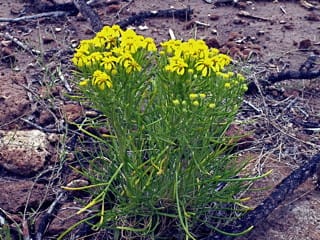 Photo: Chick Keller 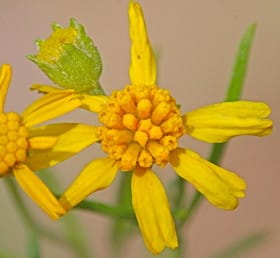 Photo: Jerry Oldenettel | Colorado Rubberweed, Richard's Bitterweed, Pingue RubberweedHYRIF (Hymenoxys richardsonii)Family: Asteraceae (Daisies) Size: up to 14 in (36 cm) Growth: forb/herb, subshrub; perennial Blooms: Jun 26 - Sep 17 Flower: composite; yellow with orange; petals with three-toothed tips that droop when the plant ages; disc florets form a dome Leaf: dicot; 3 linear lobes; concentrated near base with a scattering of small resin glands Fruit: achene topped with white translucent scales Status: native; common Habitat: ponderosa --- dry, open often rocky hillsides and plains Typical location: Anniversary Trail Colorado Rubberweed has long stems and is woolly at the base of the lowest leaves. The roots have a type of latex that can be used as a dressing on sores and rashes. The leaves and stems are poisonous, potentially even being deadly to livestock. Info Photos Distribution |
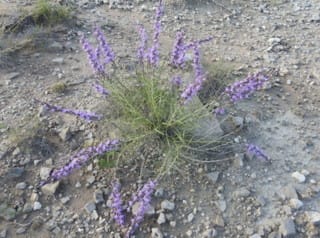 Photo: Barbara Calef 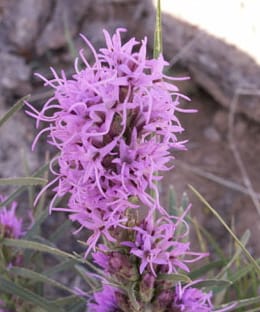 Photo: Chick Keller 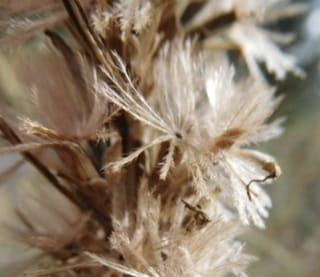 Photo: Ellen Hildebrandt | Dotted Blazing Star, Dotted Gayfeather, Dotted LiatrisLIPU (Liatris punctata)Family: Asteraceae (Daisies) Size: up to 32 in (81 cm) Growth: forb/herb; perennial Blooms: Aug 18 - Oct 31 Flower: composite; pink to purple; long spike-like clusters; 3 to 8 star-like disc florets with long style Leaf: dicot; narrow and grass-like; become thinner as ascend the stem; covered in short white hairs and dots of resin; flowers appear in the top third to half of the stem Fruit: small dark seed with a tuft of light brown hair Status: native; common Habitat: ponderosa --- forests, shrub, woodland, prairie, grassland Typical location: Quemazon Trail This plant is drought-tolerant with deep roots and fire-tolerant being able to respout from its rhizome. It is also considered to be an ornamental plant. It is eaten by livestock and similar wild large mammals. Many butterflies favor its nectar. Info Photos Distribution |
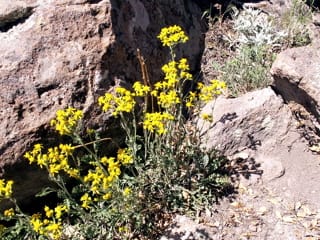 Photo: Chick Keller 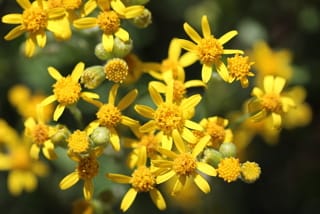 Photo: Craig Martin | Fendler's Ragwort, Fendler's Groundsel, Notchleaf SenecioPAFE4 (Packera fendleri, Senecio fendleri)Family: Asteraceae (Daisies) Size: 4 - 16 in (10 - 41 cm) Growth: forb/herb; perennial Blooms: May 30 - Aug 18 Flower: composite; yellow ray and disc florets; 6 to 8 ray florets Leaf: dicot; deeply notched almost to mid-rib; hairy; grow mostly at the base Fruit: tufted single seeds Status: native; common Habitat: mixed conifer, ponderosa --- slopes, dry rocky or gravelly soils, along streams, open forests, disturbed sites Typical location: Valle Canyon The plant is abundant at a variety of elevations and habitats, so much so that it almost seems like a weed in some areas. It’s hairy stems were used by the Navajo for a variety of medicinal uses. Info Photos Distribution |
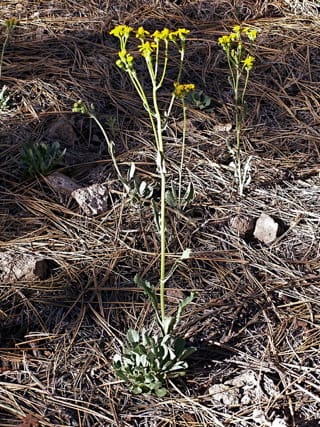 Photo: Chick Keller 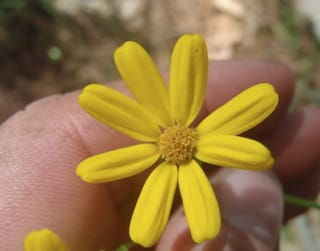 Photo: Dan Beckman | New Mexico GroundselPANEN (Packera neomexicana, Senecio neomexicanus)Family: Asteraceae (Daisies) Size: 12 - 24 in (30 - 61 cm) Growth: forb/herb, subshrub; perennial Blooms: Mar 09 - Jul 10 Flower: composite; yellow; 5 to 14 ray florets around 40 or more disc florets; clusters of between 3 and 20 flowerheads Leaf: dicot; wider at the tip than base; may have teeth and hairs; mostly located around the base Fruit: white puffs of hairs attached to seeds similar to dandelions Status: native; common Habitat: ponderosa --- foothills, montane, subalpine, woodlands, openings Typical location: Perimeter Trail to Water Canyon Plants are often crowded together with an unusual abundance of flowers for each plant. Plants can often be fairly variable. Info Photos Distribution |
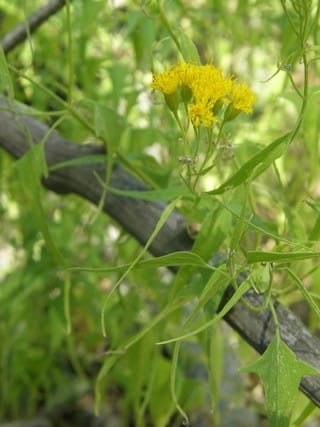 Photo: Chick Keller 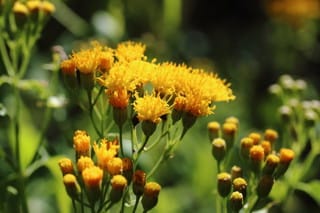 Photo: Craig Martin 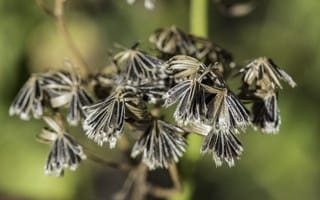 Photo: Craig Martin | Mountain Tail-leaf, Mountain Tailleaf, Mountain TaperleafPECA10 (Pericome caudata, Pericome glandulosa)Family: Asteraceae (Daisies) Size: up to 36 in (91 cm) Growth: forb/herb, subshrub; perennial Blooms: Aug 24 - Oct 20 Flower: composite; yellow — only disc florets; arrayed in leafy-braced, compound clusters Leaf: dicot; simple, often triangular-shaped with a long point; potentially with a few large teeth or sharp lobes Fruit: oblong and flat; black with a fringe of scales Status: native; uncommon Habitat: mixed conifer, ponderosa --- common along mountain road banks Typical location: Pajarito Canyon Mountain Tail-leaf is usually a large rounded bush found in a sunny place. The plant has a pungent, goat-like odor, prompting the early settlers of New Mexico to call it “yerba de chivato” or “herb of the he-goat”. It has be found around archaelogical sites in Norther Arizona. and has long been used by the Navajo for a variety of ceremonial and medicinal purposes such as for headaches and toothaches. Info Photos Distribution |
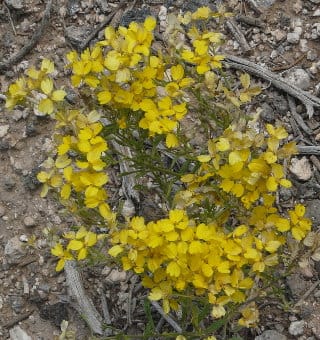 Photo: Becky Shankland 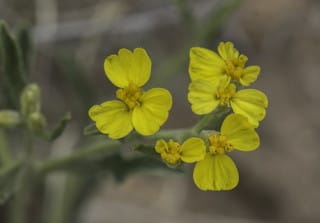 Photo: Craig Martin 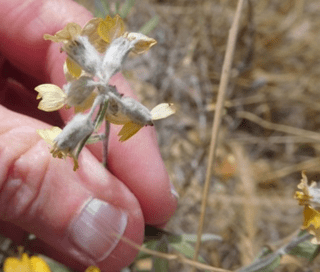 Photo: Ellen Hildebrandt | Woolly Paperflower, Paperflower, Paper DaisyPSTA (Psilostrophe tagetina)Family: Asteraceae (Daisies) Size: 4 - 12 in (10 - 30 cm) Growth: forb/herb, subshrub; biennial, perennial Blooms: Jun 25 - Oct 15 Flower: composite; yellow; compact clusters of flowerheads on short stems; 3 or 4 yellow ray florets, notched at the tip, and 6 to 12 disc florets Leaf: dicot; greyish-green with long, soft hairs; arranged alongs the base and stems Fruit: capsules usually smooth but sometimes with very fine hairs Status: native; common Habitat: pinyon-juniper --- Often seen along road edges. Typical location: White Rock The flowers remain for several months and eventually turn papery given the plant its common name. Different Native American tribes have used the plant in a variety of ways from treating a stomachache and snake bite to making it into a yellow dye. Info Photos Distribution |
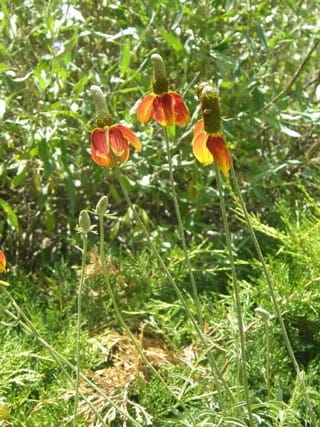 Photo: Chick Keller 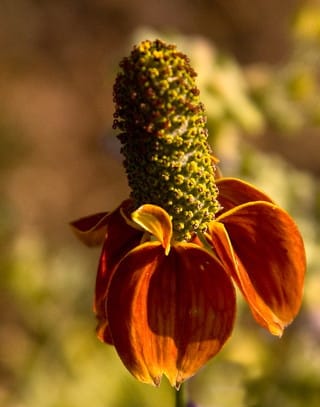 Photo: Mary Carol Williams 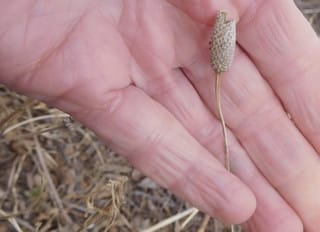 Photo: Ellen Hildebrandt | Mexican Hat, Long-headed Coneflower, Prairie ConeflowerRACO3 (Ratibida columnifera)Family: Asteraceae (Daisies) Size: 18 - 36 in (46 - 91 cm) Growth: forb/herb; perennial Blooms: Jun 30 - Oct 20 Flower: composite; orange, red and yellow; 4 to 12 droopy, streaked ray florets with a notch at the top; long cone covered in dark disc florets; flowerheads are high above the leaves on ribbed stalks Leaf: dicot; long; deeply lobed; toothless with stiff hairs Fruit: cone develops numerous tiny, winged, brown seeds Status: native; locally common Habitat: disturbed soil --- prairie, plains, meadows, pastures, roadsides Typical location: Bypass Road to Ski Hill The Mexican Hat received its common name from the fact that it somewhat resembles the shape of a slender sombrero. It is native to the state but not to Los Alamos. It is smaller than most other coneflowers but has a longer cone and rays that are about the same length as the cone. The Zunis used an infusion of the whole plant as an emetic. Info Photos Distribution |
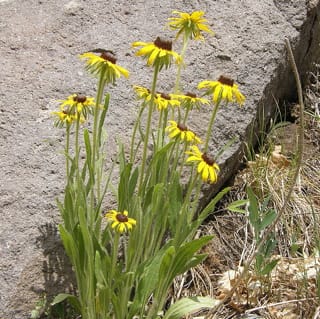 Photo: Yvonne Keller 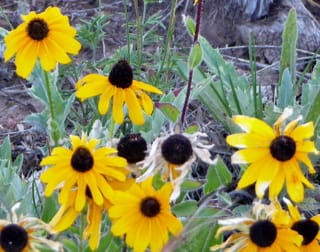 Photo: Mary Carole Williams | Black-eyed Susan, Brown-eyed SusanRUHI2 (Rudbeckia hirta)Family: Asteraceae (Daisies) Size: 12 - 24 in (30 - 61 cm) Growth: forb/herb; annual, biennial, perennial Blooms: Jun 26 - Oct 20 Flower: composite; bright yellow with dark center; 8 to 21 ray florets Leaf: dicot; green, oval and covered with hairs Fruit: brown achene with numerous small black seeds Status: native; uncommon Habitat: mixed conifer --- open areas in forests Typical location: Pajarito Upper Canyon Plant blooms continuously up until a harsh frost. Can be considered a short-lived perennial. Info Photos Distribution |
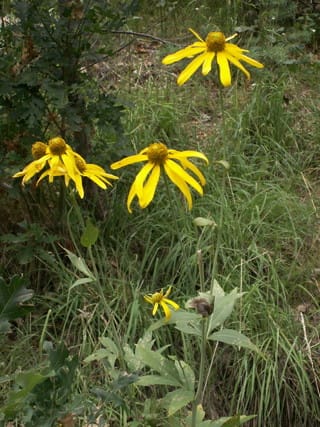 Photo: Chick Keller 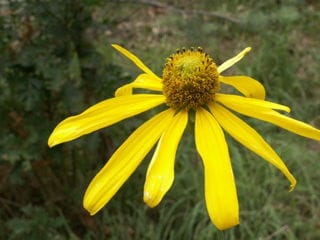 Photo: Chick Keller 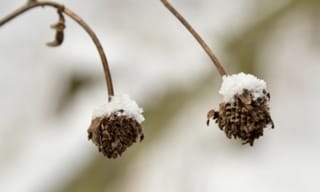 Photo: Mark Kluge | Cutleaf Coneflower, Green-headed Coneflower, Tall Coneflower, Golden GlowRULA3 (Rudbeckia laciniata)Family: Asteraceae (Daisies) Size: 24 - 84 in (61 - 213 cm) Growth: forb/herb, subshrub; perennial Blooms: Jul 12 - Aug 27 Flower: composite; yellow with brown conical center that is green when immature; daisy-like structure with 6 to 12 ray florets that droop slightly; central cone made up of numerous tubular disc florets Leaf: dicot; large leaves up to 12 in by 12 in (30 cm by 30 cm); 3 to 7 large, elliptical lobes with smooth or toothed edges Fruit: each disk floret is replaced by an oblong achene with a crown of tiny blunt teeth at its apex Status: native; common Habitat: riparian --- stream banks, wet meadows, woodland Typical location: Pajarito Canyon The Cutleaf Coneflower has light green stems that taper slightly. One can often find clonal colonies of these plants that form from long rhizomes. The foliage may be slightly poisonous and therefore is not usually eaten by mammalian herbivores but the seeds are consumed by some birds. Cultivars of Rudbeckia laciniata are often grown as ornamentals and are used in many floral bouquets. Info Photos Distribution |
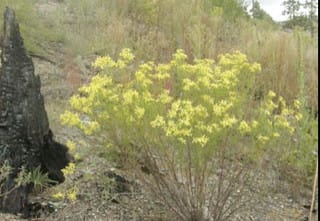 Photo: Chick Keller 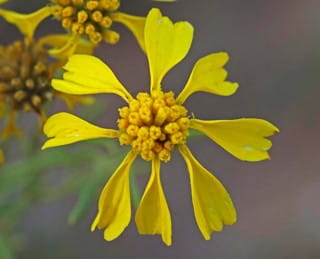 Photo: Jerry Oldenettel 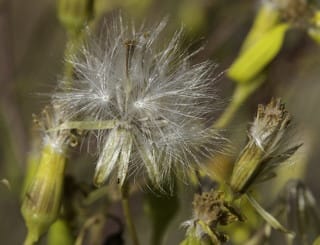 Photo: Craig Martin | Broomlike Ragwort, Many-headed Senecio, Broom Groundsel, Many-headed GroundselSESP3 (Senecio spartioides)Family: Asteraceae (Daisies) Size: 8 - 36 in (20 - 91 cm) Growth: forb/herb, subshrub; perennial Blooms: Aug 25 - Oct 31 Flower: composite; yellow; 5-8 ray florets; initially rounded but later becoming longer; erect, flat-topped clusters of many flowerheads Leaf: dicot; long and narrow; divided with linear segments Fruit: achenes topped with small bristles Status: native; locally common Habitat: mixed conifer --- semi-desert, foothills, shrublands, and sandy, gravelly openings Typical location: Trail across Flats to Red Dot Trail Broomlike Ragwort grows in an open, unbranched manner with many stems. The plant spreads from the base. Individual plants are spaced about 3 ft (1 m) apart. The lower leaves wither by the time the flowers open making the plant look dead on the bottom but full of life on the top. Info Photos Distribution |
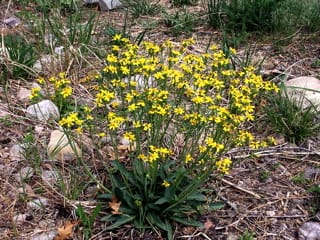 Photo: Chick Keller 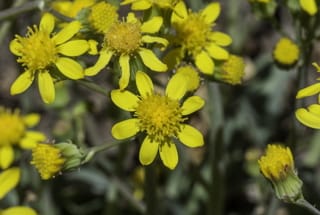 Photo: Craig Martin | Wooton's Ragwort, Wooton's SenecioSEWO (Senecio wootonii)Family: Asteraceae (Daisies) Size: up to 24 in (61 cm) Growth: forb/herb, subshrub; perennial Blooms: Apr 01 - Jun 18 Flower: composite; yellow; on stems with few leaves terminating in a flowerhead; one long petal per flowerhead Leaf: dicot; have small teeth and long stalks with wings Fruit: achenes, ribbed and hairless Status: native; common Habitat: ponderosa --- montane, woodlands, openings Typical location: Quemazon Trail When flower buds first appear they seem to only have disk flowers but the ray flowers appear with time. Plants in full sun bear a large number of flowers. Info Photos Distribution |
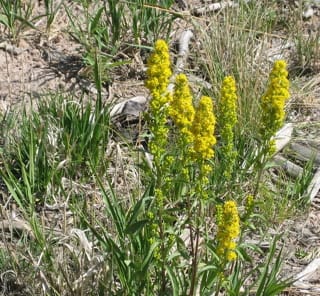 Photo: Carrie Clinton  Photo: Jerry Oldenettel | Mt. Albert Goldenrod, Smooth Goldenrod, Narrow Goldenrod, Sticky GoldenrodSOSI3 (Solidago simplex)Family: Asteraceae (Daisies) Size: up to 32 in (81 cm) Growth: forb/herb, subshrub; perennial Blooms: Aug 02 - Oct 31 Flower: composite; yellow; wide, broad clusters; number of flowerheads vary widely; densely packed on all sides of the stem Leaf: dicot; large, toothed; grow mostly around the base; stem leaves smaller and narrower Fruit: capsules with dark ridges and stiff bristles Status: native; common Habitat: ponderosa --- montane, subalpine, alpine, meadows Typical location: Valle Canyon Flowers are clustered in such a way as to give the plant a soft, fuzzy appearance. There are sticky, yellowish glands at the bottom of the flowers that are not found in similar species. Seeds are eaten by many different songbirds. Deer and rabbits occasionally feed on the foliage. Info Photos Distribution |
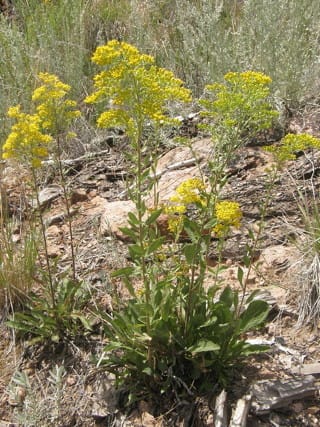 Photo: Chick Keller 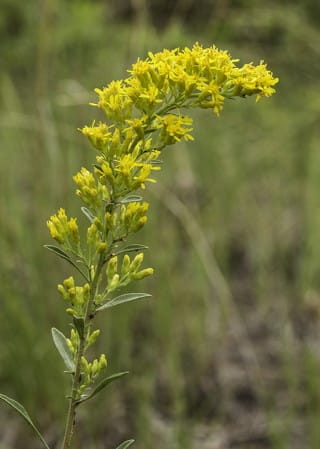 Photo: Craig Martin 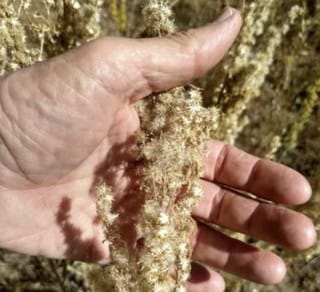 Photo: Don Rideout | Threenerve Goldenrod, Sparse GoldenrodSOVE6 (Solidago velutina)Family: Asteraceae (Daisies) Size: 6 - 30 in (15 - 76 cm) Growth: forb/herb, subshrub; perennial Blooms: Aug 18 - Oct 31 Flower: composite; yellow; 6 to 12 short rays with 5 to 17 disc florets; clusters are “wand-shaped” with up to 500 flowerheads per cluster Leaf: dicot; oval-shaped; pointing upwards with a light covering of hair; 3 prominent veins Fruit: small capsules; covered with short, dense hairs Status: native; uncommon Habitat: ponderosa --- foothills, montane, subalpine, meadows, woodland openings Typical location: Entrance to Pajarito Canyon The Threenerve Goldenrod tends to arch slightly and have flowers that grow on one side of the stem. The plants form groupings of diffuse clones. There are several recognized subspecies of Solidago velutina. The genus Solidago come from the Latin meaning “whole” or “solid” and refers to this group of plant’s supposed ability to heal. Infusions from the plant have been used to treat a variety of illnesses. Info Photos Distribution |
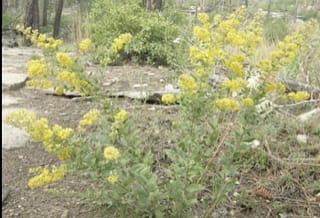 Photo: Chick Keller 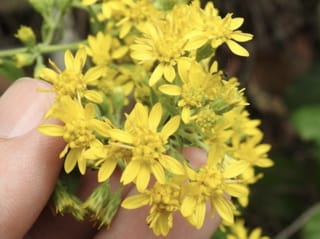 Photo: Sam Kieschnick 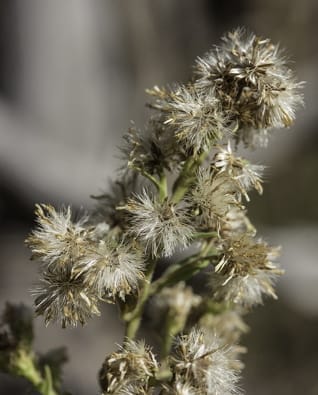 Photo: Craig Martin | Wright's Goldenrod, Bushy GoldenrodSOWR (Solidago wrightii, Solidago bigelovii)Family: Asteraceae (Daisies) Size: 8 - 40 in (20 - 102 cm) Growth: forb/herb; perennial Blooms: Aug 18 - Oct 31 Flower: composite; yellow ray and disc florets; more disc florets than ray; arranged in elongated clusters with up to 140 flowerheads Leaf: dicot; lance-shaped with short stalks; smooth overall; alternative arrangement Fruit: brown capsules with bristles that are minutely barbed Status: native; common Habitat: ponderosa --- foothills, montane, subalpine, meadows, woodland openings Typical location: Bayo Bench Trail Wright’s Goldrod is notable as a tall, erect plant with numerous large sprays of flowers and multiple stems that come up from the base. The leaves of this plant are broader than on other goldenrods and only has a single vein, though it is difficult to see. It grows at an elevation of 3,200 ft (1000 m) to 8,800 ft (2,700 m). Info Photos Distribution |
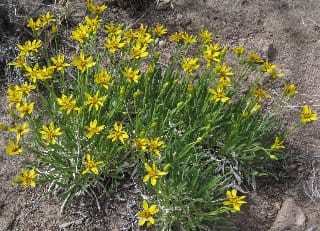 Photo: Akkana Peck 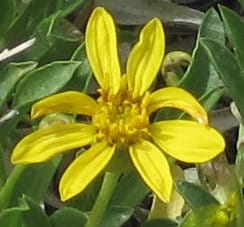 Photo: Akkana Peck | Thrift Mock Goldenweed, Thrifty Goldenweed, Ring Grass SunflowerSTAR10 (Stenotus armerioides)Family: Asteraceae (Daisies) Size: up to 10 in (25 cm) Growth: forb/herb; perennial Blooms: Apr 30 - Jun 30 Flower: composite; yellow; 5 to 15 rays with 20 to 40 disc florets Leaf: dicot; presents as a mixture of old, dried leaves and bright green, thin, vertical leaves Fruit: capsule covered with fine silky hairs Status: native; locally common Habitat: pinyon-juniper --- open wooded areas Typical location: Deer Trap Mesa Look for the shiny, sticky-looking (but not actually sticky) base beneath the flower (the penuncle). The common name of Ring Grass Sunflower comes from the plant’s circular growth pattern. As the plants age, they grow outward in a ring with the inner parts dying off. Info Photos Distribution |
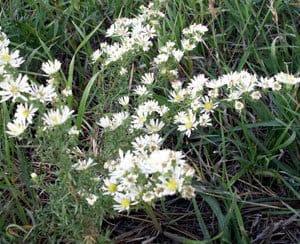 Photo: Chick Keller  Photo: Joe Bartok 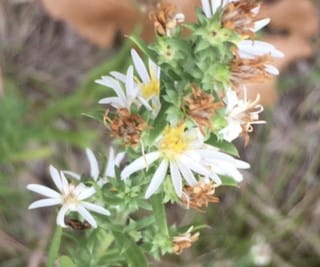 Photo: Mary Krieger | White Heath Aster, White Aster, White Prairie Aster, White Heath American-AsterSYERE (Symphyotrichum ericoides)Family: Asteraceae (Daisies) Size: 12 - 36 in (30 - 91 cm) Growth: forb/herb; perennial Blooms: Sep 10 - Oct 31 Flower: composite; white with yellow center; small, daisy-like flowers; organized into large groups that spread into one-sided dense sprays Leaf: dicot; soft green but darken with age; alternate arrangement; linear with smooth edges Fruit: little seeds with tufts of white hairs Status: native; uncommon Habitat: ponderosa --- foothills, montane, woodland openings, fields, roadsides White Heath Aster spreads by underground runners to form large patches. Its hairy stems are green initially but usually become brown as the plant matures. The lower leaves often fall off before the plant flowers. The plant has an overall “heath-like” appearance due to the needle-like bracts on the flowering stems and its distinctive narrow, linear leaves. It is attractive to butterflies. Info Photos Distribution |
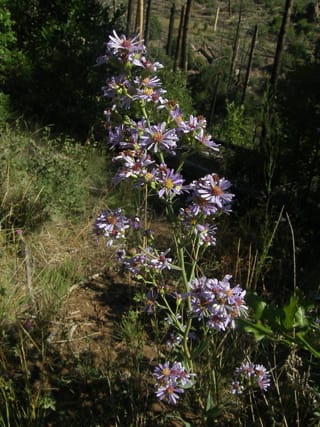 Photo: Chick Keller 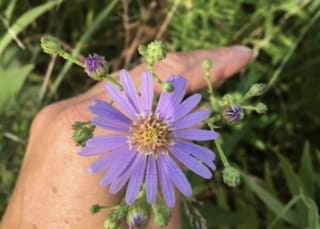 Photo: Kate McConnell | Smooth Blue Aster, Smooth AsterSYLA3 (Symphyotrichum laeve)Family: Asteraceae (Daisies) Size: 12 - 36 in (30 - 91 cm) Growth: forb/herb; perennial Blooms: Aug 26 - Oct 31 Flower: composite; blue to purple with yellow center; blowers arranged in clusters; 13 to 23 ray florets; 19 to 33 disc florets which start out yellow and eventually turn purplish Leaf: dicot; alternate arrangement and usually hairless; vary in shape and may or may not be toothed Fruit: capsules with bristles at the tip; eventually form hairs like dandelion seeds Status: native; uncommon Habitat: ponderosa --- prairies, rocky glades, dry open woods, roadsides The Smooth Blue Aster has hairless, waxy, reddish stems and forms clumps. Its root system is rhizomatous with older plants potentially developing woody caudices. Sometime offsets are procured via rhizomes. The flowers attract bees, wasps, and flies. Other insects are attracted to the leaves. In addition, mammalian herbivores like rabbits, cattle and sheep will eat the foliage. Info Photos Distribution |
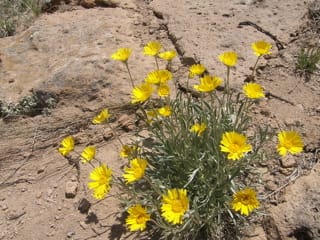 Photo: Chick Keller 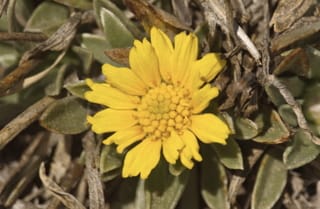 Photo: Craig Martin | Perkysue, Perky SueTEAR4 (Tetraneuris argentea, Hymenoxys argentea )Family: Asteraceae (Daisies) Size: up to 15 in (38 cm) Growth: forb/herb; perennial Blooms: Apr 01 - Aug 15 Flower: composite; yellow; found on the top of long leafless stalks; a dozen or so notched ray florets stick out very straight from the central disc florets Leaf: dicot; fuzzy silver leaves Fruit: achenes topped with scales Status: native; common Habitat: pinyon-juniper, ponderosa --- niches in solid rock areas Typical location: Lower Quemazon Trail Hearty plant that is the earliest blooming yellow daisy. Has been used heartburn and in a lotion for eczema. Info Photos Distribution |
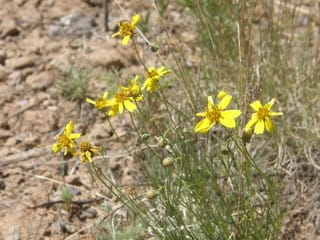 Photo: Chick Keller 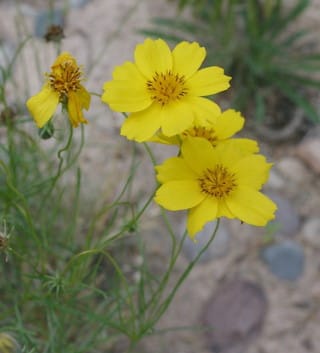 Photo: Terry Foxx | Stiff Greenthread, Hopi TeaTHFI (Thelesperma filifolium)Family: Asteraceae (Daisies) Size: 4 - 16 in (10 - 41 cm) Growth: forb/herb; annual Blooms: May 01 - Oct 30 Flower: composite; yellow ray flowers; reddish disc florets; Leaf: dicot; thin green leaves that are thread-like scattered along the stems Fruit: capsules with tufted hairs Status: native; common Habitat: disturbed soil --- dry hills and plains Typical location: Canyon Rim Trail paved section east end parking When budding, the flower heads droop but stand upright when open. The plant is used to make an herbal tea and is currently cultivated on the Colorado Plateau in New Mexico for this purpose. The seeds are eaten by some birds and the plant is larval food for the sulphur butterfly. Info Photos Distribution |
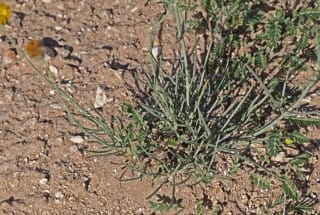 Photo: Jerry Oldenettel 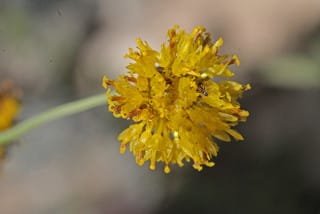 Photo: Jerry Oldenettel | Colorado Greenthread, Rio Grande Greenthread, Hopi Tea Greenthread, Navajo TeaTHMEA (Thelesperma megapotamicum)Family: Asteraceae (Daisies) Size: 6 - 24 in (15 - 61 cm) Growth: forb/herb; annual Blooms: Jul 01 - Sep 15 Flower: composite; yellow or orange; located on tips of branching stems; usually disc florets only; bracts surrounding the flowerhead have yellow or white margins Leaf: dicot; grey-green; alternate orientation; mostly compound with linear segments Fruit: achene topped with bristles Status: native; common Habitat: canyon, disturbed soil, grassland --- open areas in pinyon-juniper Typical location: White Rock Like its taller cousin, Cota, Greenthread can be made into an herbal tea and a yellow dye. You can tell Greenthread from Cota by its grey-green vegetation and bare, taller stems, and its flowers have only disk flowers, no ray flowers. Megapotamicum means "big river" -- i.e. the Rio Grande. Info Photos Distribution |
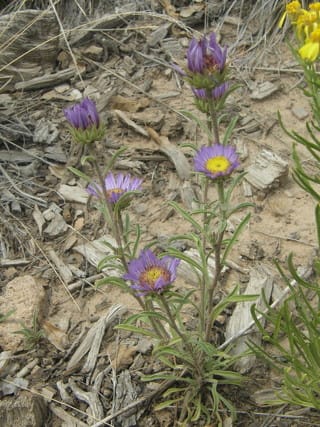 Photo: Chick Keller 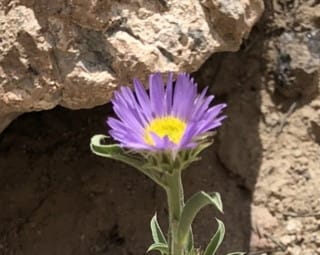 Photo: Craig MartinRaphael Mazor | Townsend's Daisy, Rocky Mountain Townsend Daisy, Tall Townsend DaisyTOEX (Townsendia eximia)Family: Asteraceae (Daisies) Size: 8 - 12 in (20 - 30 cm) Growth: forb/herb; perennial Blooms: Jun 27 - Oct 20 Flower: composite; purple with yellow center; showy flowerhead 50+ ray florets and 100+ disc florets Leaf: dicot; dense clusters of basal leaves; widely-spaced, alternate spatula-shaped narrow stem leaves Fruit: capsules with tufts of forked hair Status: native; locally common Habitat: mixed conifer, ponderosa --- gravely banks, canyon walls, woodlands Typical location: Quemazon Trail Unlike other Townsendia species, Townsendia eximia grows upright and has purple flowers rather than white or pink. Its range is primarily confined to Northern and Central New Mexico and far Southern Colorado. Despite its limited range, it appears to be ecologically secure. Info Photos Distribution |
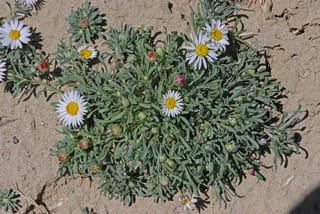 Photo: Jerry Oldenettel 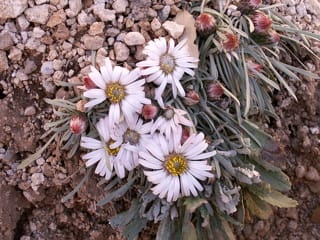 Photo: Chick Keller 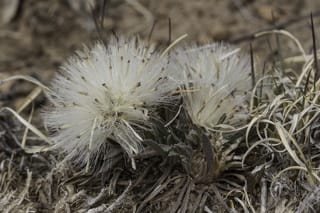 Photo: Craig Martin | Stemless Townsend Daisy, Easter Daisy, Silky Townsend DaisyTOEX2 (Townsendia exscapa)Family: Asteraceae (Daisies) Size: 1 - 7 in (3 - 18 cm) Growth: forb/herb; perennial Blooms: Mar 10 - May 19 Flower: composite; white to pinkish petals surrounding a yellow center Leaf: dicot; gray-green; spatulate in shape; usually hairy Fruit: achene with fine, slender bristles on top Status: native; uncommon Habitat: pinyon-juniper --- grasslands, sage; plains, valleys Typical location: Burnt Mesa Trail Plant grows from a woody taproot from which the leaves and flowers grow directly. Thus, the plant is stemless or nearly so. Info Photos Distribution |
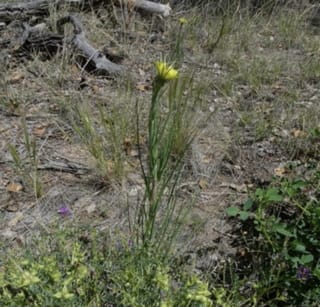 Photo: Brandt Magic 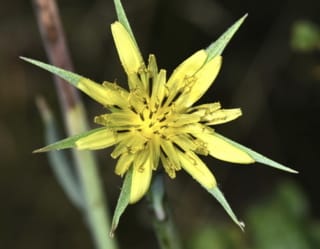 Photo: Don Lorie 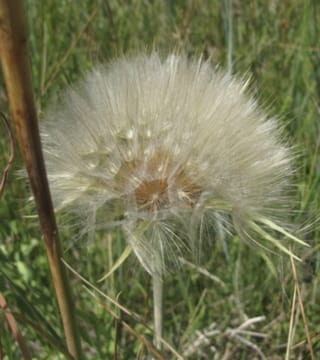 Photo: Chuck Sexton | Yellow Salsify, Western Salsify, Oyster Plant, GoatsbeardTRDU (Tragopogon dubius)Family: Asteraceae (Daisies) Size: 12 - 24 in (30 - 61 cm) Growth: forb/herb; annual, biennial Blooms: May 19 - Sep 10 Flower: composite; yellow; single terminal flowerhead on a long stalk; outer florets have 5 small teeth at tip Leaf: dicot; basal and along the stems; grass-like but wider with pointed tips Fruit: long, thin brown seeds with a whitish beak attached a fluffy tannish-white seed head Status: naturalized plant; common Habitat: disturbed soil --- foothills, montane, openings, woodlands, fields Yellow Salsify was introduced from Europe and is naturalized across most of the United States. It is thought that it was brought into the country because the taproot is edible, tasting a bit like oysters. It is considered to be an invasive weed in many areas but has little economic impact. Overall, it is similar to a dandelion but much larger. Info Photos Distribution Weed Guide |
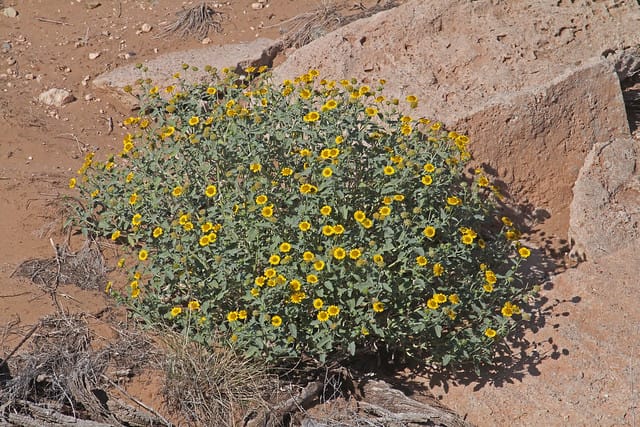 Photo: Jerry Oldenettel 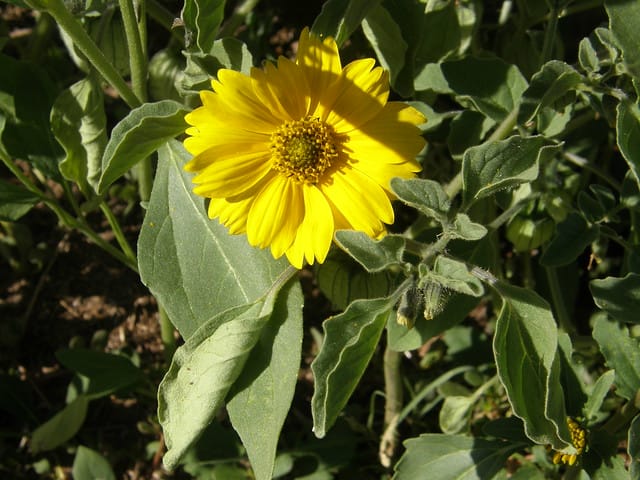 Photo: Chick Keller 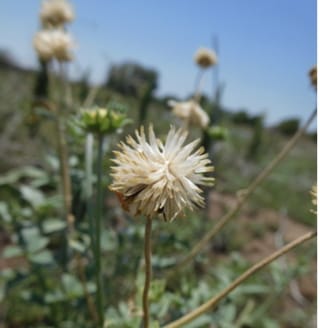 Photo: Ellen Hildebrandt | Golden Crownbeard, Cowpen Daisy, Butter DaisyVEEN (Verbesina encelioides)Family: Asteraceae (Daisies) Size: 10 - 50 in (25 - 127 cm) Growth: forb/herb; annual Blooms: Sep 10 - Oct 31 Flower: composite; from yellow to orange-yellow to brown; typically 12 broad yellow petals with two lengthwise grooves and notches at the tip; 80 to 150 tubular disc florets; usually singular flowerheads Leaf: dicot; large blue-green leaves; toothed edges and covered with short hairs; opposite arrangement on stem but alternate arrangement near base Fruit: brownish, narrow obovate achene or one-seeded fruit Status: native; common Habitat: disturbed soil --- open areas, sunny, dry conditions Typical location: White Rock Golden Crownbeard is often considered to be a weed but is an important medicinal plant. It has anti-inflammatory properties but is also one of the most potent allergens around. The plant is upright with many branched stems. It is commonly found on disturbed ground and can color miles of roadside. Info Photos Distribution |
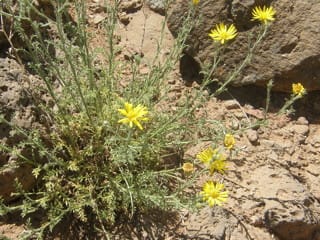 Photo: Chick Keller  Photo: Patrick Alexander 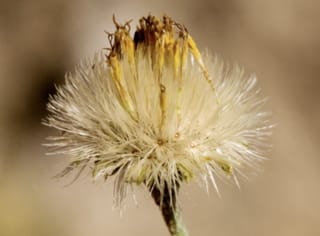 Photo: Patrick Alexander | Spiny Goldenweed, Lacy Tansyaster, Cutleaf Goldenweed, Lacy Sleepy Daisy, Wooly GoldenweedMAPI (Xanthisma spinulosum, Machaeranthera pinnatifida)Family: Asteraceae (Daisies) Size: 10 - 20 in (25 - 51 cm) Growth: forb/herb, subshrub; perennial Blooms: Jun 11 - Aug 02 Flower: composite; bright yellow; 16+ florets with numerous disc florets; flowerheads can be singular or in small clusters on the tips of stiff branches Leaf: dicot; silvery green; thin and deeply lobed with dense white hairs/spines Fruit: whitish tan, hairy, ovoid capsules Status: native; common Habitat: pinyon-juniper --- semi-desert, open areas, hillsides Typical location: Red Dot Trail Spiny Goldenweed is a highly variable plant. Last years’s flowers are often present until the new ones appear. It may be a small plant but it spreads rapids so that it can blanket large areas up to several acres in yellow flowers. Xanthisma spinulosum is an interesting scientifically as it is the species with the lowest number of chromosomes of any plant investigated so far, with only 4 chromosomes. Info Photos Distribution |
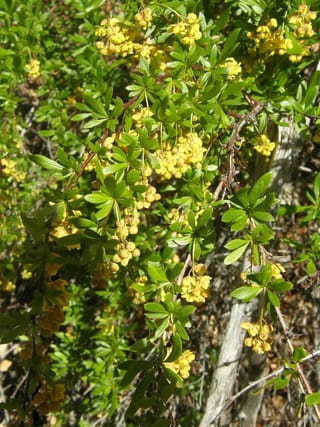 Photo: Chick Keller 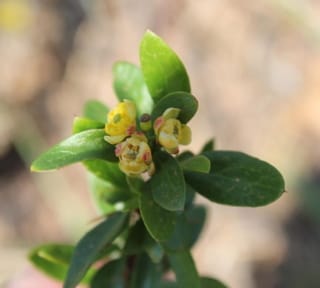 Photo: Terry Foxx | Fendler's Barberry, Colorado BarberryBEFE (Berberis fendleri)Family: Berberidaceae (Barberries) Size: 40 - 80 in (102 - 203 cm) Growth: shrub; perennial Blooms: May 19 - Jun 22 Flower: simple; yellow; grows in clusters with 15 flowers each Leaf: dicot; simple, green spoon-shaped leaves Fruit: red, juicy, oblong fruit Status: native; locally common Habitat: ponderosa --- slopes and canyon bottoms at lower elevations This shrub has spiny stems and grows in colonies. Like other barberries, the fruit is edible and has antibacterial properties, used for enteric infections. Info Photos Distribution |
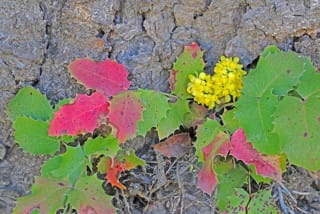 Photo: Jerry Oldenettel 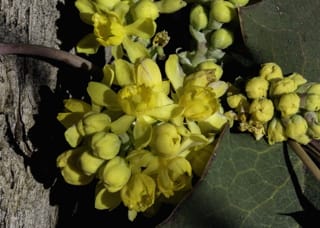 Photo: Craig Martin 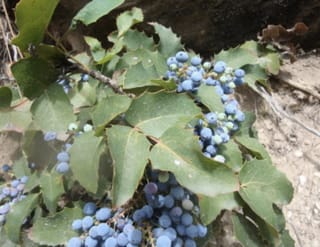 Photo: freejinn | Creeping Barberry, Creeping Oregon GrapeMARE11 (Mahonia repens)Family: Berberidaceae (Barberries) Size: 12 - 24 in (30 - 61 cm) Growth: shrub, subshrub; perennial Blooms: Mar 15 - May 30 Flower: simple; yellow; long clusters of up to 50 flowers; 6 petals Leaf: dicot; bluish green with some leaves in pinks and oranges Fruit: matte blue berries Status: native; common Habitat: ponderosa --- foothills, montane, subalpine, woodlands Typical location: Satch Cowan Trail A sprawling evergreen with small fragrant flowers. The berries attract birds. In the fall the leaves of this groundcover turn bronze. Info Photos Distribution |
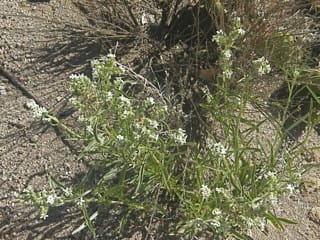 Photo: Chick Keller 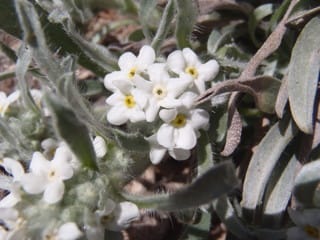 Photo: Craig Martin | James' Cryptantha, James' Hiddenflower, James' CatseyeCRCIJ (Cryptantha cinerea, Oreocarya suffruticosa)Family: Boraginaceae (Borages) Size: up to 4 in (10 cm) Growth: forb/herb, subshrub; perennial Blooms: Apr 15 - Sep 10 Flower: simple; white with yellow corolla tube; dozen of clusters per plant that elongate with age Leaf: dicot; narrow, linear leaves; sparse hairs Fruit: four identical smooth nutlets Status: native; uncommon Habitat: pinyon-juniper, ponderosa --- open areas, semi-desert Typical location: Anniversary Trail One of the most shrub-like of the genus with many branches and bristly hairs. Found in open areas below 8,000 ft (2,400 m). Info Photos Distribution |
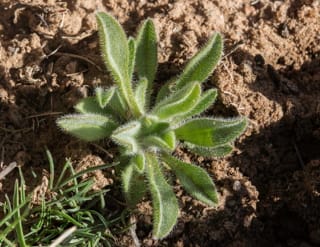 Photo: Craig Martin 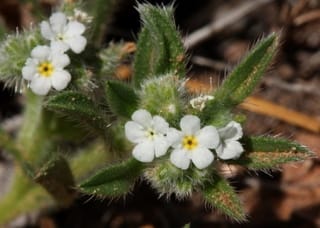 Photo: J.N. Stuart 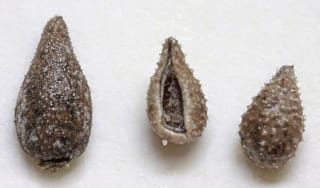 Photo: Andrey Zharkikh | Thicksepal Catseye, Thicksepal Cryptantha, Thicksepal HiddenflowerCRCR3 (Cryptantha crassisepala)Family: Boraginaceae (Borages) Size: up to 4 in (10 cm) Growth: forb/herb; annual Blooms: Apr 01 - May 31 Flower: simple; tiny; white with a little yellow; 5 petals Leaf: dicot; oblanceolate;hairy; form a rosette about an inch across Fruit: 4 nutlets, one taller than the others Status: native; common Habitat: scrubland --- sandy soils in semi-desert Used by Navajo as a lotion for itching and muscle fatigue. Info Photos Distribution |
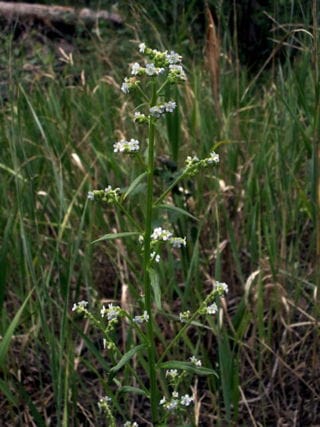 Photo: Chick Keller 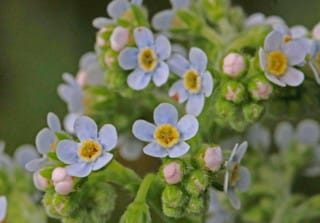 Photo: Jerry Oldenettel 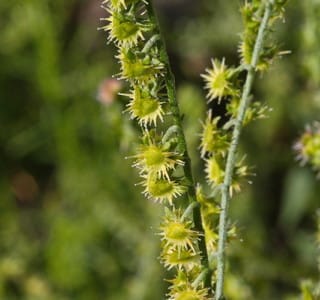 Photo: Craig Martin | Manyflower Stickseed, Many-Flower Stickseed, Manyflowered Stickseed, False Forget-Me-NotHAFL2 (Hackelia floribunda)Family: Boraginaceae (Borages) Size: 12 - 40 in (30 - 102 cm) Growth: forb/herb; biennial, perennial Blooms: Jul 14 - Sep 10 Flower: simple; blue with yellow center; tiny; funnel-shaped; 5 lobes around a central tube; clusters of flowers on branched stem Leaf: dicot; large, thin; alternate arrangement; lower leaves have stalks; upper ones do not Fruit: tiny, flattened nutlets, bristly along the edge Status: native; uncommon Habitat: mixed conifer --- open areas, montane Typical location: Valle Canyon Hackelia Floribunda is a lush herb with hairy stems that tend to grow at a 45 degree angle. The seeds are quite prickly contributing to the plant’s common name of Stickweed. The seeds tend to cling to pieces of clothing and potentially can cause some irritation. There have been reports of Native Americans using the plant for medicinal purposes. Info Photos Distribution Weed Guide |
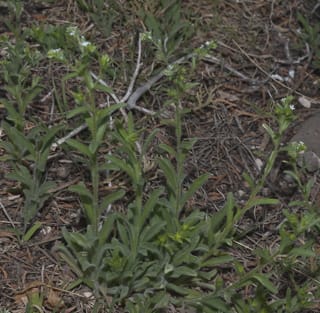 Photo: Marion Stelts 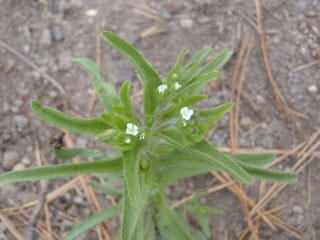 Photo: Craig Martin 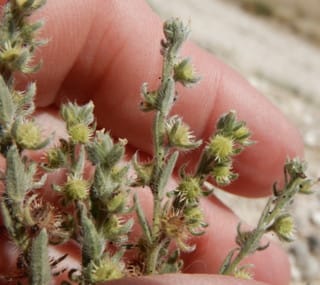 Photo: Ellen Hildebrandt | Flatspine Stickseed, Flatspine Sheepburr, Western SticktightLAOC3 (Lappula occidentalis)Family: Boraginaceae (Borages) Size: up to 32 in (81 cm) Growth: forb/herb; annual, biennial Blooms: Apr 15 - May 30 Flower: simple; light blue to white; small and hairy; radially symmetrical; 5 petals Leaf: dicot; lance-shaped with pointed end at the bottom; alternate arrangement; hairy Fruit: star-shaped nutlets Status: native; common Habitat: disturbed soil, ponderosa --- semi-desert, foothills, montane, open areas Typical location: Lower Pueblo Canyon The seedpods are easily carried away by animals and humans brushing against the plant. The Navajo used the plant in a poultice for insect bites and other skin irritations. Usually found below 8,500 ft (2,500 m). Info Photos Distribution |
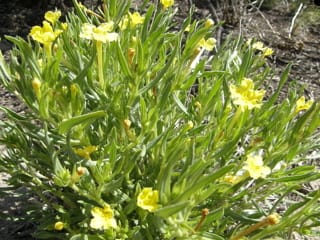 Photo: Chick Keller 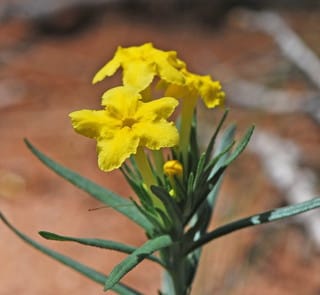 Photo: Jerry Oldenettel 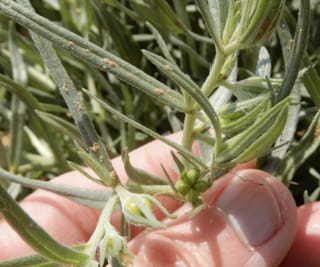 Photo: Ellen Hildebrandt | Narrowleaf Stoneseed, Fringed Puccoon, Fringed GromwellLIIN2 (Lithospermum incisum, Batschia linearifolia)Family: Boraginaceae (Borages) Size: up to 12 in (30 cm) Growth: forb/herb; perennial Blooms: Apr 19 - Jun 01 Flower: simple; yellow, 5 wavy petals; changes with the season: large and wide at first, then becoming trumpet-like with the large petals at the top Leaf: dicot; simple leaves with alternate arrangement Fruit: four small fruits, each which contains one seed Status: native; uncommon Habitat: pinyon-juniper --- semi-desert, foothills, canyons, shrublands, woodlands Begins to bloom as soon as the leaves first emerge and continues flowering as the plant grows. Roots, stems, and leaves were used medicinally by Native Americans for the treatment of things like swelling and intestinal problems. Info Photos Distribution |
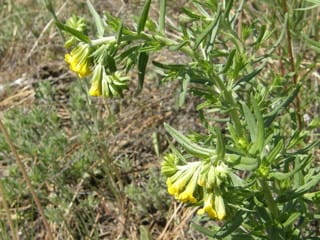 Photo: Chick Keller 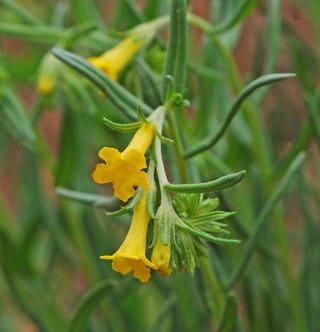 Photo: Jerry Oldenettel | Manyflowered Stoneseed, Yellow Puccoon, Manyflowered GroomwellLIMU3 (Lithospermum multiflorum)Family: Boraginaceae (Borages) Size: 12 - 24 in (30 - 61 cm) Growth: forb/herb; perennial Blooms: May 19 - Aug 02 Flower: simple; yellow; trumpet-shaped with 5 lobes Leaf: dicot; narrow; close together; slightly toothed; alternative arrangement Fruit: white, shiny nutlets Status: native; common Habitat: ponderosa --- montane, subalpine, woodlands, openings This plant grows in clumps. The upper half is branched with numerous flower clusters. The roots and seeds have been used by some Native American tribes. Info Photos Distribution |
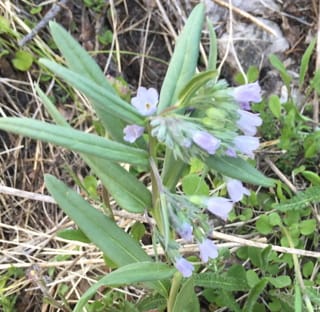 Photo: Meg Swan 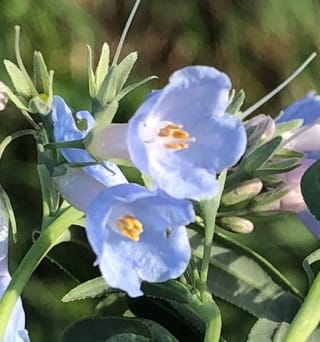 Photo: mckinseyyy | Prairie Bluebells, Narrowleaf Bluebells; ChimingbellsMELA3 (Mertensia lanceolata)Family: Boraginaceae (Borages) Size: 8 - 14 in (20 - 36 cm) Growth: forb/herb; perennial Blooms: May 10 - Jun 10 Flower: simple; from pale blue to dark purple; bell-shaped, formed of five fused petals; pointed downwards Leaf: dicot; lanceolate; broad with a prominent center vein; alternate spacing; covered with hair Fruit: 4 nutlets encased in a persistent calyx Status: native; uncommon Habitat: ponderosa --- foothills, montane, woodlands, meadows, openings Typical location: Above Skating Rink Fresh flowers are light blue and then become more purple as their nectar supply is consumed. Often confused with other short Mertensia species. Info Photos Distribution |
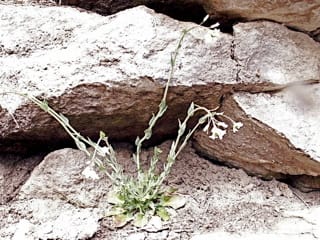 Photo: Chick Keller 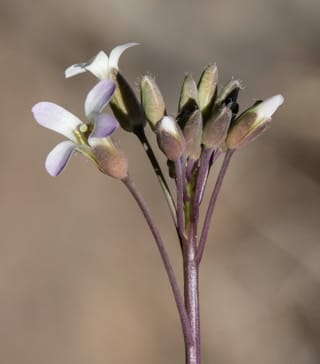 Photo: Craig Martin 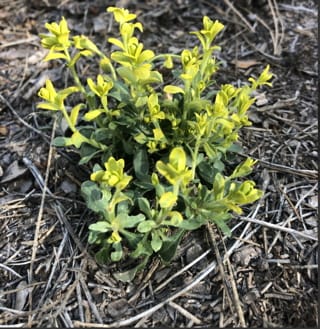 Photo: false flowers by Christina M. Selby | Fendler's RockcressARFEF (Boechera fendleri, Arabis fendleri)Family: Brassicaceae (Mustards) Size: up to 4 in (10 cm) Growth: forb/herb, subshrub; perennial Blooms: Mar 30 - May 27 Flower: simple; white, turning pink to purple with age; 4 petals Leaf: dicot; basal leaves broadly oblanceolate with forked hairs; upper leaves smooth Fruit: pedicels; horizontal or curving downward Status: native; common Habitat: ponderosa --- rocky slopes in pine forests, pinyon-juniper woodlands, scrub oak This is tall, slender plants that is often attacked by a rust fungus (see bottom photo). The fungal hyphae germinate and then parasitize nutrients from the host plant. The fungus causes the plant to produce both a scent and nectar to attract insects that then carry the fungus spores to another plant. Info Photos Distribution |
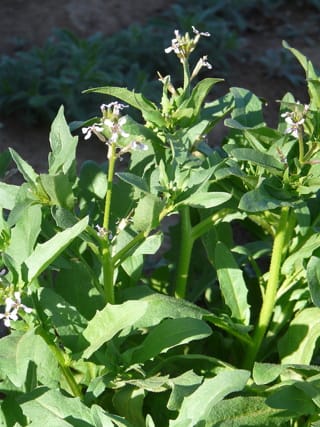 Photo: Rebecca Shankland 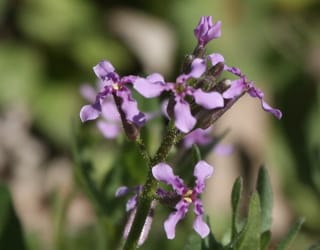 Photo: J.N. Stuart | Crossflower, Blue Mustard, Purple MustardCHTE2 (Chorispora tenella)Family: Brassicaceae (Mustards) Size: 6 - 24 in (15 - 61 cm) Growth: forb/herb; annual Blooms: Mar 24 - Jun 19 Flower: simple; blue to purple; 4 petals; borne on racemes Leaf: dicot; grey-green; wavy-edged with teeth Fruit: long pods that curve upward; reddish brown seeds Status: naturalized plant; locally common Habitat: disturbed soil --- semi-deserts, foothills, fields, woodlands Typical location: White Rock This plant originated in Europe and Asia but was introduced in the US long ago. It is classified as a noxious weed in many areas due to its ability to take over open fields in the early spring. Has a strong musky odor. Info Photos Distribution |
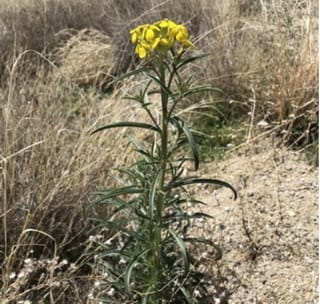 Photo: Mike Anderson 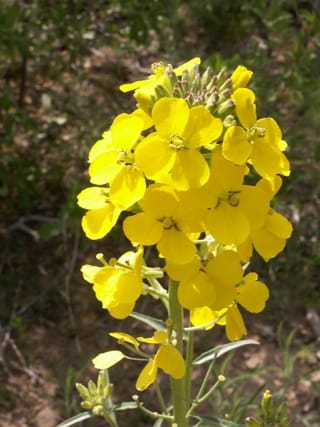 Photo: Chick Keller 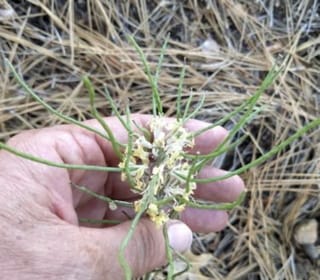 Photo: Dan Rideout | Sanddune Wallflower, Western Wallflower, Wallflower, Prairie RocketERCA14 (Erysimum capitatum)Family: Brassicaceae (Mustards) Size: 12 - 24 in (30 - 61 cm) Growth: forb/herb; biennial, perennial Blooms: Apr 15 - Jul 12 Flower: simple; yellow though may show as orange in some areas;4 flat petals; dense, rounded flower cluster on the top of the plant Leaf: dicot; long, thin leaves; rosette at the bottom of the plant; Fruit: narrow and nearly vertical seed pods Status: native; locally common Habitat: mixed conifer --- semi-desert to alpine, woodlands, meadows A highly variable species, often one of the first flowers in spring. The plant grows in a small group, often scattered over a large area. Info Photos Distribution |
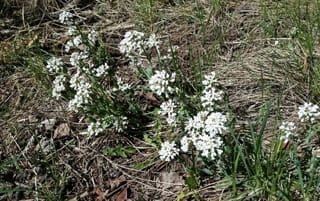 Photo: Craig Martin 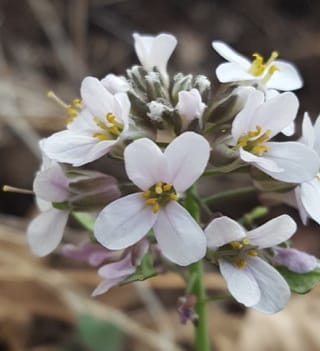 Photo: Alex Abair | Fendler's Pennycress, Alpine Pennycrest, Wild CandytuftNOMOF (Noccaea fendleri)Family: Brassicaceae (Mustards) Growth: forb/herb; perennial Blooms: Mar 15 - May 14 Flower: simple; white with a little pink; flowers grow in dense clusters Leaf: dicot; small, arrow-shaped leaves; evenly spaced and growing on the main stem of the plant Fruit: two fused carpels with two seeds in each half Status: native; uncommon Habitat: mixed conifer --- lower montane through alpine, woodlands, openings, meadows Typical location: Valle Canyon Grows in large patches with few other plants around. It starts to flower when still close to the ground but the continues to elongate as it grows. Info Photos Distribution |
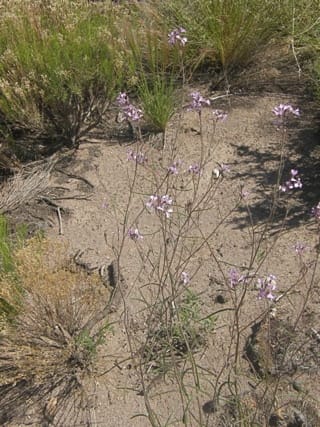 Photo: Chick Keller 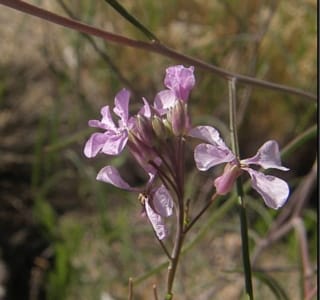 Photo: Chick Keller | Slimleaf Plainsmustard, Pink WindmillsSCLI12 (Schoenocrambe linearifolia, Hesperidanthus linearifolius )Family: Brassicaceae (Mustards) Size: 6 - 8 in (15 - 20 cm) Growth: forb/herb, subshrub; perennial Blooms: Jun 16 - Sep 20 Flower: simple; pink, purple and/or white; darker veins; located on tips of slender unbranched stems; 4 septals and 4 petals Leaf: dicot; simple, long; toothed edges; alternate orientation Fruit: straight, slightly tapered long capsules Status: native; common Habitat: pinyon-juniper, ponderosa --- dry slopes, open woodland, canyons, rocky ridges, roadsides Typical location: Bayo Bench Trail Tall, slender plant with a few flowers at the top. It has been used in ceremonies by Native Americans and as an eye medicine. Info Photos Distribution |
 Photo: Jerry Oldenettel 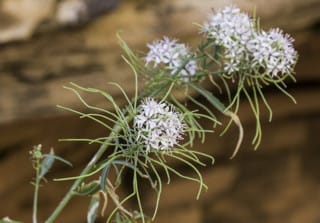 Photo: Craig Martin | Wright's ThelypodyTHWR (Thelypodium wrightii)Family: Brassicaceae (Mustards) Size: 24 - 40 in (61 - 102 cm) Growth: forb/herb; biennial, perennial Blooms: Jun 15 - Jul 31 Flower: simple; white, occasionally purple; petals shaped like thick fingers; rounded clusters on tips of branches Leaf: dicot; lanceolate, lacy leaflets on each side of stem; margins variable Fruit: long, thin capsules Status: native; common Habitat: pinyon-juniper, ponderosa --- rock crevices, pinyon-juniper communities, oak woodlands It has been said that if the flower heads of Wright's Thelypody were different colors that it would resemble a decorated Christmas tree with rounded balls at the end of its sprawling branches. This species of thelypody lives in the middle to upper elevations. It has been used as a dermatological aid and as an eye medic but the Native Americans. Info Photos Distribution |
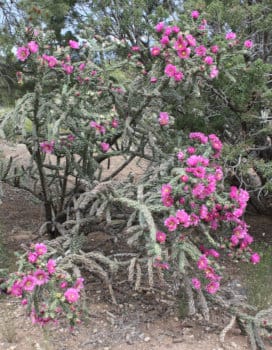 Photo: Akkana Peck 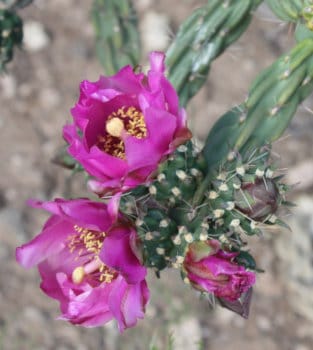 Photo: Akkana Peck | Tree Cholla, Walking Stick Cholla, Cane ChollaCYIM2 (Cylindropuntia imbricata)Family: Cactaceae (Cacti) Size: up to 120 in (305 cm) Growth: shrub, tree; perennial Blooms: Jun 01 - Jul 31 Flower: simple; pink; large and numerous; flowers are borne on a specific type of stem Leaf: dicot; leaves have been reduced to thick spines that numerous along the main branches Fruit: yellow and spineless; persists throughout winter Status: native; locally common Habitat: pinyon-juniper --- open areas, scrub Typical location: White Rock Canyon The plant’s woody skeleton is often used to make walking sticks, hence the common names. This attractive cactus does not flower every year, but can be spectacular when it does flower. The fruit is edible but is not commonly eaten. Info Photos Distribution |
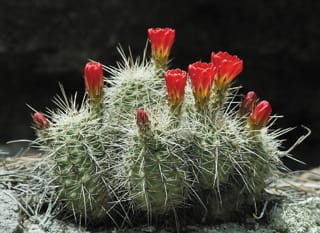 Photo: J. Howell 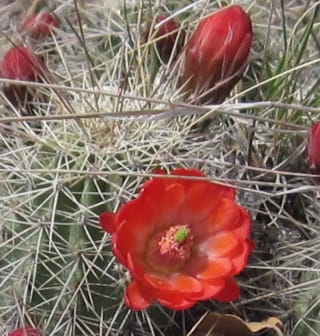 Photo: Akkana Peck | Scarlet Hedgehog Cactus, Claret Cup CactusECCOC (Echinocereus coccineus)Family: Cactaceae (Cacti) Size: up to 16 in (41 cm) Growth: shrub; perennial Blooms: Apr 20 - Jun 22 Flower: simple; red with green stigma; rounded petals Leaf: dicot; leaves replaced by spines Fruit: greenish or yellowish to pinkish Status: native; uncommon Habitat: pinyon-juniper --- semi-desert, woodlands, openings The plant grows in sprawling clusters (potentially up to 100 members) with low-to-medium spine cover and somewhat flabby stems. Info Photos Distribution |
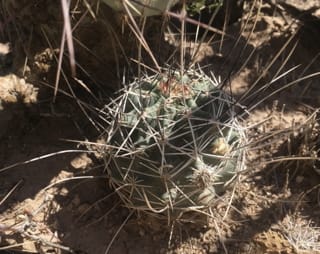 Photo: Peter Alexander 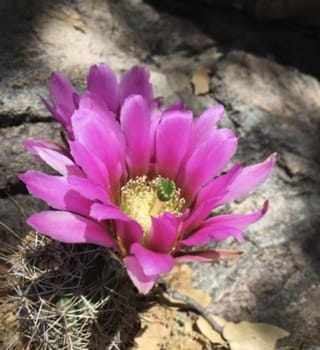 Photo: Peter Alexander | Pinkflower Hedgehog Cactus, Fendler's Hedgehog CactusECFE (Echinocereus fendleri)Family: Cactaceae (Cacti) Size: 4 - 12 in (10 - 30 cm) Growth: shrub; perennial Blooms: May 25 - Jun 15 Flower: simple; shades of pink with yellow anthers and green stigma; flowers are borne below the apex of the stem Leaf: dicot; white and black; one central spine and 4 to 10 radial spines Fruit: red, round and spiny; edible Status: native; uncommon Habitat: pinyon-juniper --- dry slopes and in rocky areas in semidesert areas Typical location: White Rock It is a low growing, scrubby cactus, that grows alone or in small clumps with 5 to 20 stems. It is relatively inconspicuous and easy to overlook until it blooms as its showy, short-lived flowers are hard to miss. Info Photos Distribution |
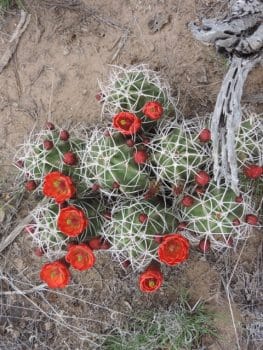 Photo: Chick Keller 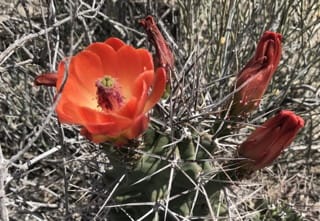 Photo: CK Kelly 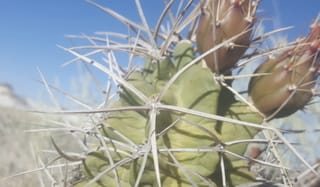 Photo: Alex Abair | Kingcup Cactus, Claret Cup, Mojave MoundECTR (Echinocereus triglochidiatus)Family: Cactaceae (Cacti) Size: 6 - 9 in (15 - 23 cm) Growth: shrub; perennial Blooms: May 15 - Jun 15 Flower: simple; red; funnel-shaped; grow at the top of stems, all at about the same height Leaf: dicot; densely spiny and somewhat woolly Fruit: exterior densely spiny and somewhat woolly with white pulp; juicy with spines; edible Status: native; uncommon Habitat: pinyon-juniper --- low desert to rocky slopes, scrub, mountain woodland Typical location: White Rock The Kingcup is a mounding cactus, forming rounded piles of a few to hundreds of spherical to cylindrical stems. It is related to the Scarlet Hedgehog but has much fewer spines. It is the most wide-spread of the Echiniocereus genius and the most variable in appearance. The flowers are pollinated by hummingbirds. Info Photos Distribution |
 Photo: Chick Keller 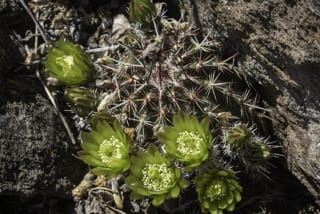 Photo: Craig Martin | Nylon Hedgehog Cactus, Green-Flowered Hedgehog, Small-Flowered Hedgehog, Green PitayaECVI2 (Echinocereus viridiflorus)Family: Cactaceae (Cacti) Size: up to 6 in (15 cm) Growth: shrub; perennial Blooms: Jun 01 - Jun 30 Flower: simple; yellowish green; tubular; may have maroon stripes; delicate petal tips Leaf: dicot; spines are variable in color; short and numerous Fruit: variably colored fruit with white pulp Status: native; uncommon Habitat: grassland, scrubland --- desert scrub, woodlands, dry grasslands Typical location: White Rock, White Rock Canyon The plant is relatively easy to overlook. It consists of short, most unbranched, cylinders that form small clusters with a dozen or so members. Info Photos Distribution |
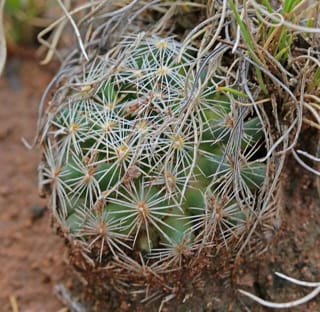 Photo: Jerry Oldenettel 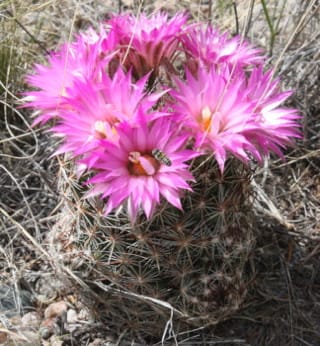 Photo: Akkana Peck | Spinystar, Pincushion Cactus, Beehive CactusESVI2 (Escobaria vivipara, Coryphantha vivapara)Family: Cactaceae (Cacti) Size: up to 6 in (15 cm) Growth: shrub; perennial Blooms: Apr 15 - Jun 15 Flower: simple; pink; arise from tubercles at the top of the plant; conspicuously fringed Leaf: dicot; up to 40 white radial spines and several darker, central spines pointing outwards at various angles Fruit: green, ovoid fruits that turn dull brownish red; juicy Status: native; uncommon Habitat: pinyon-juniper --- dry valleys, foothills, grasslands A favorite as an ornamental in nurseries, this cactus can be found at elevations up to 8,800 ft (2,700 m) as a single plant or small cluster of 20 or more stems. It was a common food source, roasted or boiled, for some Native American cultures. Info Photos Distribution |
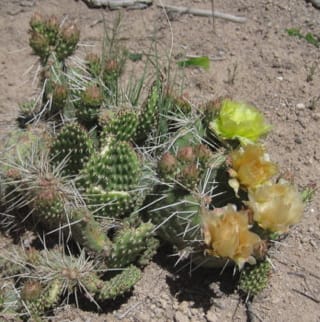 Photo: Akkana Peck 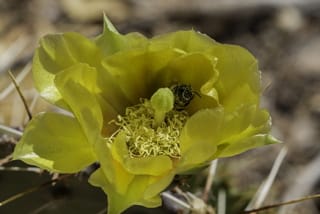 Photo: Craig Martin 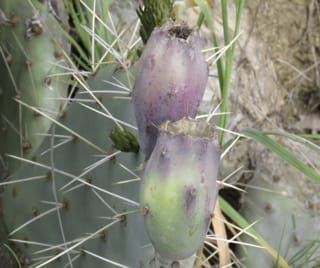 Photo: Matthew Salkiewicz | Tulip Prickly Pear Cactus, Desert Prickly Pear, Brown-spined Pricklypear, Dark-spined Prickly PearOPPH (Opuntia phaeacantha)Family: Cactaceae (Cacti) Size: 4 - 10 in (10 - 25 cm) Growth: shrub; perennial Blooms: May 20 - Aug 01 Flower: simple; yellow, orange, or pink; very large and open wide Leaf: dicot; clusters of 8 or fewer thick white or brown central spines; may have no spines on the base of the pads Fruit: reddish purple fruits with green flesh Status: native; common Habitat: disturbed soil, open area, scrubland --- grasslands, pine-juniper,scrub Typical location: Red Dot Trail Our most common species of prickly pear. It is highly variable and is prone to hybridize with other species. The fruit is edible and can sometimes be found in the markets. It is often used to flavor lemonade and margaritas. During dry periods the dark green pads may take on a purplish tinge. Info Photos Distribution |
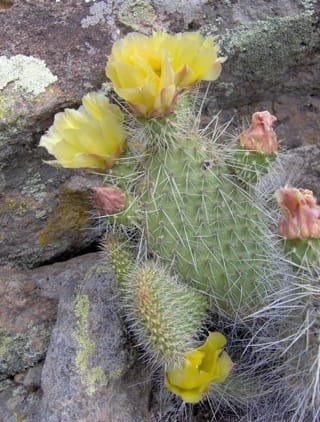 Photo: Barbara Calef 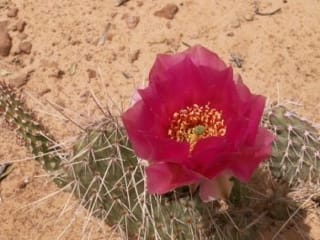 Photo: Yvonne Keller 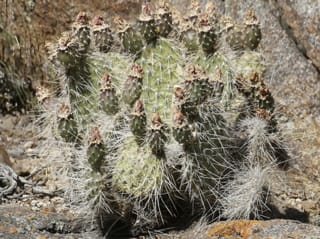 Photo: Donna Pomeroy | Plains Prickly Pear Cactus, Hairspine Pricklypear, Starvation Prickly PearOPPO (Opuntia polyacantha)Family: Cactaceae (Cacti) Size: 4 - 10 in (10 - 25 cm) Growth: shrub; perennial Blooms: May 25 - Jul 05 Flower: simple; yellow or orange, and sometimes pink; Leaf: dicot; closely spaced clusters of spines that vary in color but are usually short and dense Fruit: tan to brown; almost burr-like Status: native; common Habitat: pinyon-juniper --- semi-desert, foothills, open areas Typical location: Burnt Mesa Trail, Red Dot Trail The plant is grows very close to the ground forming a spreading mat that is often partially covered by soil or grass and leaves. It is common to see semi-circular chunks taken out of the pads caused by animals nibbling on them. Info Photos Distribution |
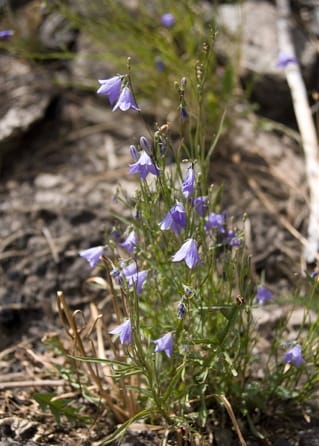 Photo: David Schiferl 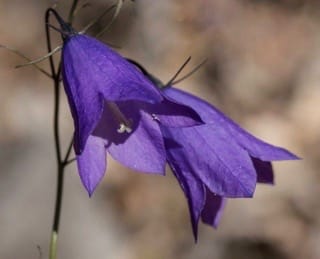 Photo: Craig Martin | Bluebell Bellflower, HarebellCARO2 (Campanula rotundifolia)Family: Campanulaceae (Bellflowers) Size: 4 - 15 in (10 - 38 cm) Growth: forb/herb; perennial Blooms: Jul 08 - Oct 20 Flower: simple; blue to purple; racemes with many flowers on slender pedicels; 5 petals fused in bell-shape Leaf: dicot; rounded to heart-shaped; usually slightly toothed with prominent pores Fruit: grows out of the flower into a nodding capsule; splits open when ripe Status: native; common Habitat: mixed conifer, ponderosa --- rocky slopes, meadows, woods, roadsides Typical location: Canada Bonita Common at a variety of elevations. They are usually found in small groups or larger colonies. Info Photos Distribution |
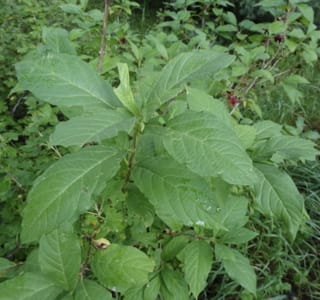 Photo: Russel Pfau 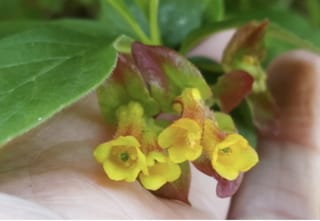 Photo: Alison Young 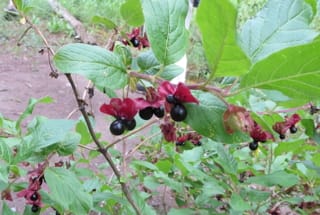 Photo: Barbara Calef | Twinberry Honeysuckle, Bush Honeysuckle, Inkberry, Black Twinberry, Bearberry Honeysuckle, Four-line HoneysuckleLOIN5 (Lonicera involucrata)Family: Caprifoliaceae (Honeysuckles) Size: 45 - 300 in (114 - 762 cm) Growth: shrub; perennial Blooms: May 01 - Jul 31 Flower: simple; yellow with red; tubular paired flowers; sweetly scented and nectar-producing Leaf: dicot; elliptic to lance-shaped; opposite orientation Fruit: dark, shiny, purplish berries; surrounded by green woolly bracts that turn deep red with time Status: native; common Habitat: garden, mountain meadow, stream --- moist areas at forest openings and meadow edges at high altitude --- 7,000-10,000 ft (2,000 to 3,000 m) Typical location: East Fork of Jemez River, Frijoles Canyon Like other honeysuckles, this plant is often used as a garden ornamental. Its flowers attract hummingbirds and birds feed on the fruits. The berries are juicy but intensely bitter and potentially toxic for human consumption. However, they have been used as a dye source. Info Photos Distribution |
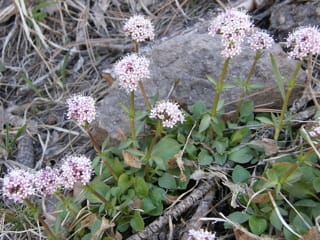 Photo: Chick Keller 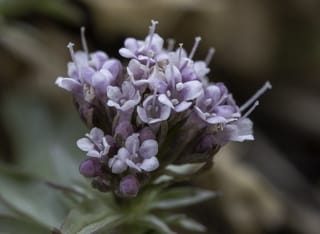 Photo: Craig Martin | Arizona Valerian, ValerianVAAR3 (Valeriana arizonica)Family: Caprifoliaceae (Honeysuckles) Size: 2 - 6 in (5 - 15 cm) Growth: forb/herb; perennial Blooms: Mar 19 - Jun 01 Flower: simple; pinkish white; tubular; arranged in a spherical cluster; 5 lobes Leaf: dicot; sparsely spaced leaves; opposite arrangement Fruit: achene-like with 1 seed Status: native; locally common Habitat: mixed conifer, ponderosa --- moist coniferous forests Typical location: Valle Canyon Found at upper elevations on north facing slopes. The plant is characterized by unbranched, stout but relatively short stems tapering to long stalks. Info Photos Distribution |
 Photo: Chick Keller 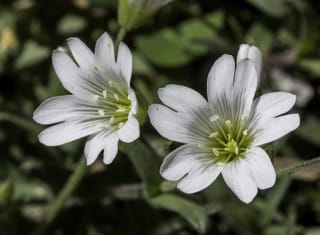 Photo: Craig Martin | Field Chickweed, Chickweed, Mouse-ear ChickweedCEAR4 (Cerastium arvense)Family: Caryophyllaceae (Pinks) Size: 12 - 16 in (30 - 41 cm) Growth: forb/herb; perennial Blooms: May 09 - Jul 12 Flower: simple; white; 5 petals, deeply notched into 2 lobes; open clusters Leaf: dicot; lance-linear; opposite; toothless Fruit: capsule; narrowly cylindrical and slightly curved Status: native; common Habitat: mixed conifer --- montane, subalpine, meadows Typical location: Valle Canyon A plant that grows from a taproot or systems of rhizomes. It can grow in various forms --- mat, clump, creeper or upright. Info Photos Distribution |
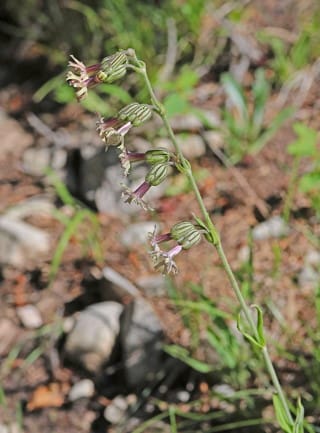 Photo: Jerry Oldenettel 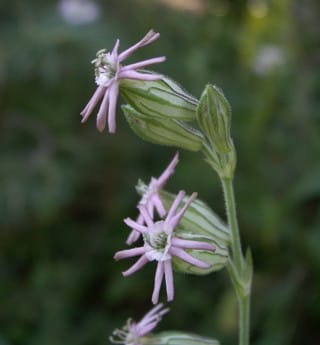 Photo: Chick Keller | Simple Champion, Scouler's CatchflySISC7 (Silene scouleri)Family: Caryophyllaceae (Pinks) Size: up to 32 in (81 cm) Growth: forb/herb; perennial Blooms: Aug 18 - Sep 11 Flower: simple; white with pink or purple; 2 to 4 lobes; inflorescence varies --- few or many flowers, dense or open cluster Leaf: dicot; grow at the bases and at paired intervals along the stem; covered in soft hairs Fruit: ovoid capsules with wrinkled seeds Status: native; uncommon Habitat: oak woodland --- bluffs, prairies, open woods Typical location: Ski Hill The low basal leaves of this plant are often overlooked until the tall flowering stalks appear. The stem is typically simple or unbranched, giving the plant its common name. The calyx is distinctive, lined with 10 greenish purple veins and often appearing inflated. Info Photos Distribution |
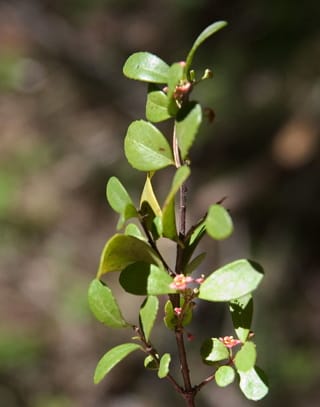 Photo: Mary Carole Williams 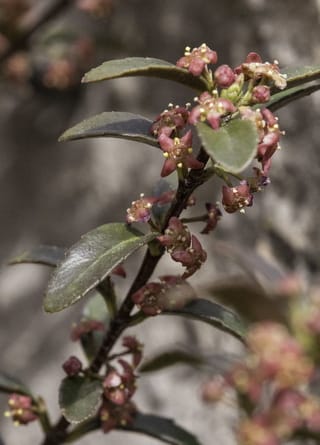 Photo: Craig Martin | Oregon Boxleaf, Mountain Lover, Myrtle BoxwoodPAMY (Paxistima myrsinites)Family: Celastraceae (Bittersweets) Size: 8 - 24 in (20 - 61 cm) Growth: shrub; perennial Blooms: Apr 18 - May 30 Flower: simple; red with yellow; cross-shaped; growing in a cluster around an axil; inconspicuous Leaf: dicot; evergreen leaves; toothed margins; opposite arrangement Fruit: cylindrical brown fruit capsules Status: native; common Habitat: mixed conifer, ponderosa --- foothills, montane, subalpine, woodlands. Typical location: Valle Canyon Oregon boxleaf is a low spreading shrub that looks like a miniature boxwood. It reproduces via seed, but it can also be propagated with cuttings. In the wild, it is a good source of food for a variety of animals. Info Photos Distribution |
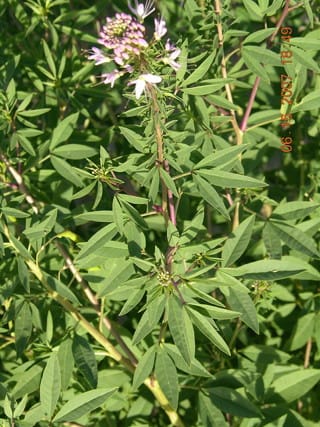 Photo: Jerry Oldenettel 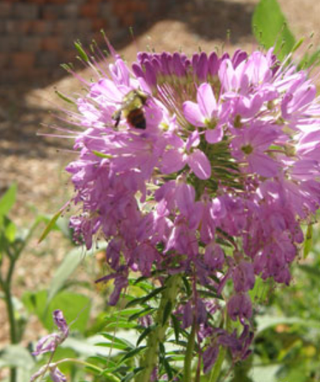 Photo: Yvonne Keller 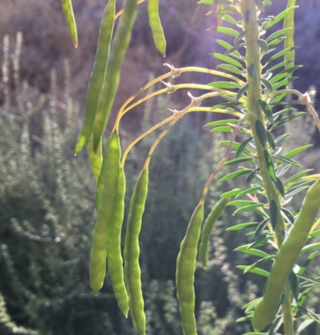 Photo: Sharon | Rocky Mountain Beeplant, Skunk Weed, Bee Spider FlowerCLSE (Cleome serrulata, Cleome serrulata)Family: Cleomaceae (Mustards) Size: 5 - 40 in (13 - 102 cm) Growth: forb/herb; annual Blooms: Jul 10 - Sep 22 Flower: simple; pink; each flower has 4 petals and sepals and 6 long, showy stamens; clustered in elongated racemes Leaf: dicot; trifoliate with small teeth; spirally arranged Fruit: distinctive podlike capsules; up to 4 inches(10 cm) long; droop down from elongated stems Status: native; uncommon Habitat: disturbed soil --- foothills, montane, woodlands Flowers produce large amounts of nectar. They form a showy cluster that continues to elongate during the season so that seed pods may be present at the same time as new blooms. The flowers attract a variety of pollinators. A black dye, used for paining pots, can be made by boiling down the whole plant. Info Photos Distribution |
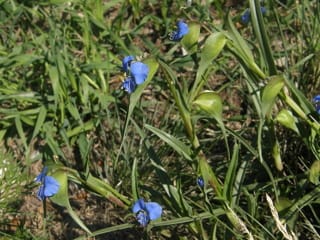 Photo: Chick Keller 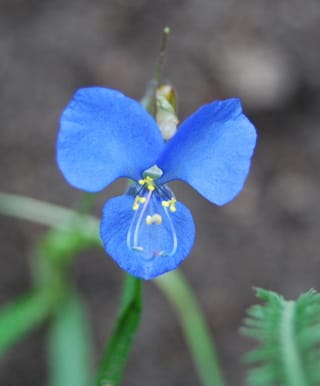 Photo: Jerry Oldenettel | Birdbill Dayflower, Bird-Bill DayflowerCODI4 (Commelina dianthifolia)Family: Commelinaceae (Spiderworts) Size: up to 18 in (46 cm) Growth: forb/herb; perennial Blooms: Aug 20 - Sep 10 Flower: simple; blue with a small amount of yellow; flowers are nestled in a green pouch from which each new flower emerges; 3 petals: 2 large and 1 small Leaf: monocot; bright-green, long and narrow; leaf blade contracted around the main stem Fruit: pointed capsule; seeds form within the bract Status: native; uncommon Habitat: ponderosa --- montane, rocky openings Typical location: Intersection of Pajarito Trail and Rendija Canyon The flowers open in the morning but wither by by mid-day. Like other Dayflowers, the petals absorb moisture from the atmosphere until they dissolve and turn too much. Typically one new flower opens each morning. An infusion of the plant has been used as a strengthener for weakened patients and as an aphrodisiac for livestock. Info Photos Distribution |
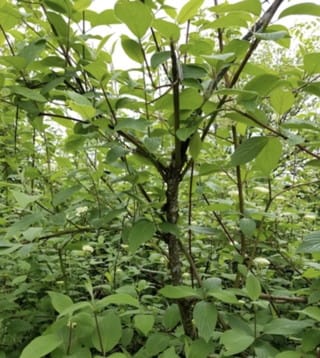 Photo: Rod 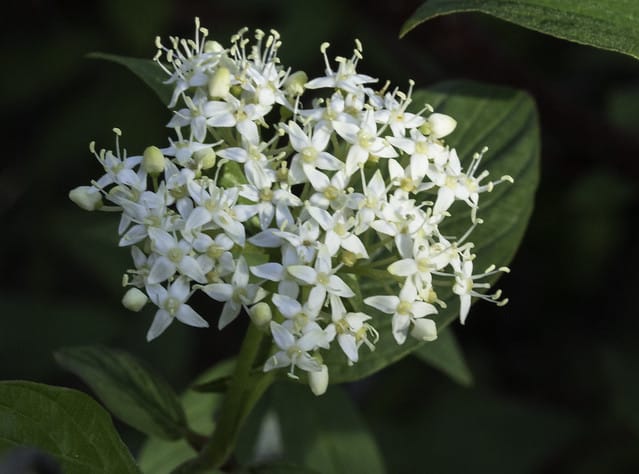 Photo: Craig Martin 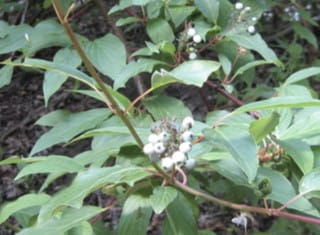 Photo: Ellen Hildebrandt | Red Osier Dogwood, Red Twig DogwoodCOSE16 (Cornus sericea)Family: Cornaceae (Dogwoods) Size: 36 - 120 in (91 - 305 cm) Growth: shrub, tree; perennial Blooms: May 20 - Jul 14 Flower: simple; white; arranged in flat-topped clusters; fragrant; 4 stamens and 4 petals Leaf: dicot; simple and oblong; opposite arrangement; lighter green underneath Fruit: white berries; may be tinged with blue Status: native; uncommon Habitat: riparian --- found in wet canyons not too far from a stream Typical location: Pajarito Canyon second crossing Red Osier Dogwood is a multi-stemmed shrub with branches radiating from the base. Smaller branches and twigs are dark red, though plants in shaded areas may lack this coloration. Butterflies and other pollinators are attracted to the flowers. Birds will consume the berries. Info Photos Distribution Tree Guide |
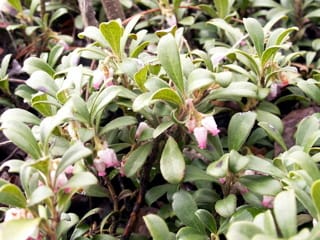 Photo: Chick Keller 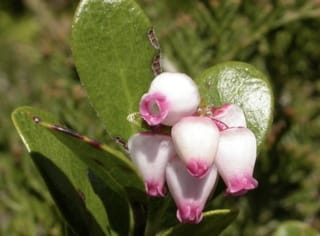 Photo: Lorraine Briddon 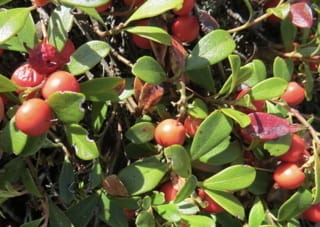 Photo: Don Sutherland | Kinnikinnick, BearberryARUV (Arctostaphylos uva-ursi)Family: Ericaceae (Heaths) Size: 2 - 12 in (5 - 30 cm) Growth: shrub; perennial Blooms: Mar 10 - May 08 Flower: simple; paink and white; urn-shaped on bright-red stems Leaf: dicot; shiny and small; thick, leathery, and paddle-shaped Fruit: drupes; bright red and glossy Status: native; locally common Habitat: ponderosa --- montane, alpine, woodlands Typical location: Kinnikinnick Park Its species name of uva-ursi means "grape of the bear” and indeed bears eats the fruit. Often forms very dense, pure stands of groundcover. Info Photos Distribution |
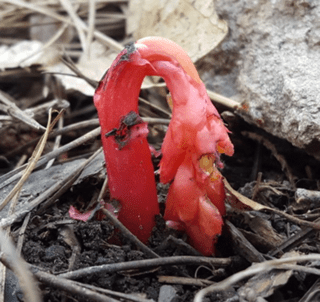 Photo: Alex Abair 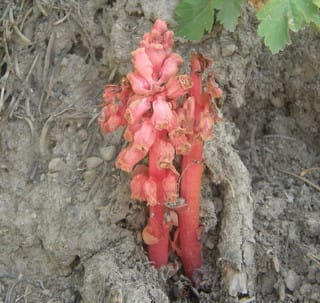 Photo: Chick Keller 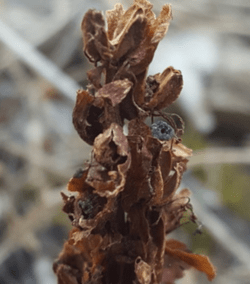 Photo: Alex Abair | Pinesap, Yellow Bird's Nest, Many-flower Indian-pipeMOHY3 (Monotropa hypopithys, Hypopitys americana)Family: Ericaceae (Heaths) Size: 3 - 10 in (8 - 25 cm) Growth: forb/herb; perennial Blooms: Aug 01 - Sep 10 Flower: simple; pink to red; vase-like, nodding flowers on same colored stem Leaf: dicot; stalkless, scale-like, elliptical; occurring along the flower stem Fruit: hairy, erect capsules that survive until the following summer Status: native; rare Habitat: mixed conifer --- mature, moist, shaded, temperate forests Pinesap does not contain chlorophyll and in many areas of the US the plant is pale yellows white in color. It get its food from photosynthesis but rather obtains nourishment from parasitizing fungi associated with roots, in particular those of oaks and pines. As such it is indirectly a parasite of the trees by taking the nutrients that the fungi obtain from them. Info Photos Distribution |
 Photo: Chick Keller 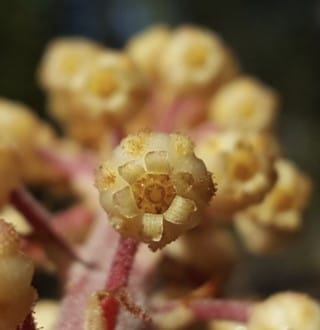 Photo: Alex Abair 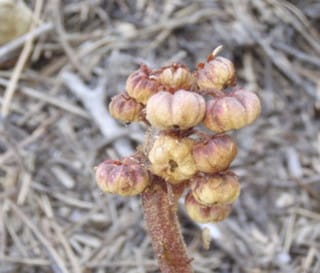 Photo: Christy King | Woodland Pinedrops, PinedropsPTAN2 (Pterospora andromedea)Family: Ericaceae (Heathers) Size: up to 24 in (61 cm) Growth: forb/herb; perennial Blooms: Jun 26 - Oct 31 Flower: simple; yellow with red; egg=shaped; hang in a long raceme Leaf: dicot; no true leaves; sometimes scales growing on the flower stalk Fruit: small rounded capsules; brown and dry at maturity; seeds escape through slits in the sides of the fruit Status: native; uncommon Habitat: ponderosa --- montane, confer woodlands Woodland Pinedrops have no chlorophyll, rather the plant is a parasite on mycorrhizal fungi which in turn parasitize conifer roots. Its stems which often form clusters are reddish-brown plant and covered with glandular hairs. Stems only grow for one year, but remain for several years as dried stalks. Info Photos Distribution |
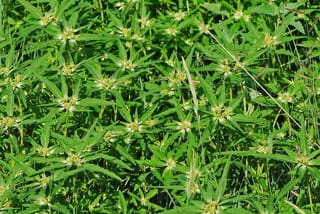 Photo: Jerry Oldenettel 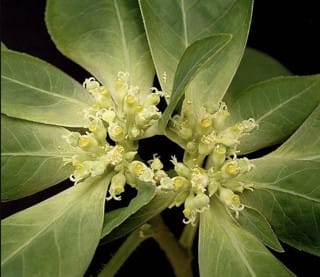 Photo: Frank Vincentz 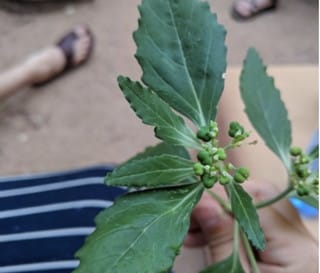 Photo: C Whiting | Toothed Spurge, Toothed Poinsettia, Green PoinsettiaEUDE4 (Euphorbia dentata)Family: Euphorbiaceae (Spurges) Size: up to 24 in (61 cm) Growth: forb/herb; annual Blooms: Jul 01 - Sep 30 Flower: simple; green with white; tiny, indistinct cluster at tip of stem; fringed margins Leaf: dicot; alternate orientation at bottom, opposite at top; elliptical-shaped; toothed; may have red spots Fruit: three lobed, stalked capsule; may turn reddish in sunlight; gray-brown seeds Status: native; common Habitat: disturbed soil --- White Rock road edges Typical location: White Rock Each cluster of Toothed Spurge flowers has several structures called cyathia, each with a mixture of inconspicuous flowers and immature fruits. The fruit develops rapidly from the center, initially hanging down, but becoming erect at maturity. The sap of the plant is irritating to the skin and eyes and can cause gastrointestinal tract problems in herbivores that browse on it. Therefore, it is considered a noxious weed in many parts of the US. The Toothed Spurge is in the same genus as the Christmas Poinsettia. Info Photos Distribution |
 Photo: Christina M. Selby 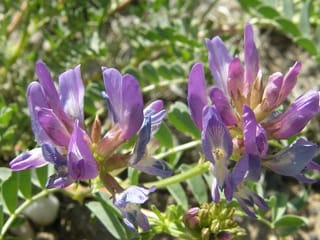 Photo: Chick Keller 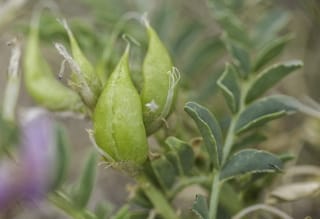 Photo: Craig Martin | Beaked Milkvetch, Freckled Milkvetch, Specklepod Milkfetch, Spotted LocoweedASLE8 (Astragalus lentiginosus)Family: Fabaceae (Peas) Size: up to 12 in (30 cm) Growth: forb/herb, subshrub; annual, biennial, perennial Blooms: May 08 - Jun 06 Flower: simple; purple or white; turned upward and growing in loose clusters of up to 30 Leaf: dicot; elliptical to oval; dark green; hairless Fruit: egg-shaped pod; beaked; inflated Status: native; uncommon Habitat: pinyon-juniper --- semi-desert, open areas Typical location: Anniversary Trail The plant grows in dense, large tufts with numerous arching leaflets. It typically has short, stiff hairs on the stems. Info Photos Distribution |
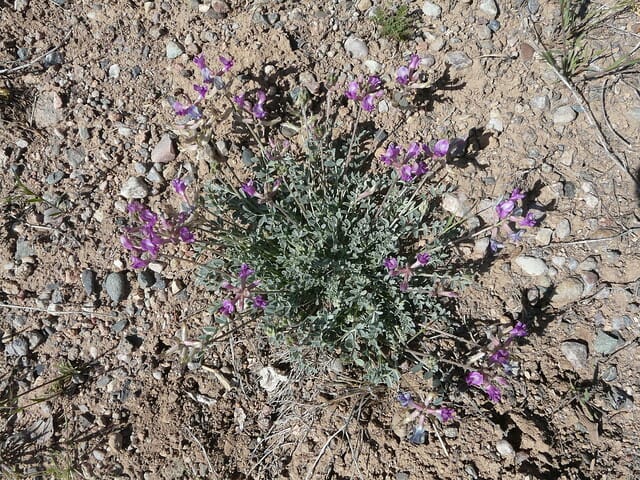 Photo: Rebecca Shankland 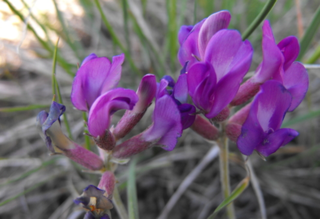 Photo: M. Weiss 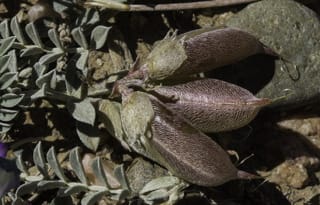 Photo: Craig Martin | Missouri MilkvetchASMI10 (Astragalus missouriensis)Family: Fabaceae (Peas) Size: 4 - 6 in (10 - 15 cm) Growth: forb/herb, subshrub; perennial Blooms: Apr 21 - May 19 Flower: simple; shades of purple and blue; short flower cluster on a thick stem with 3 to 10 stalked pea-shaped flowers Leaf: dicot; compound, elliptical leaves that a bend along the axis; covered with dense silvery-white to gray hairs Fruit: short, oblong seedpods with stiff hairs Status: native; common Habitat: pinyon-juniper --- semi-desert, woodlands, shrubs, openings Typical location: White Rock This plant has a wide range and is found in a band that ranges from Texas and New Mexico in the south up into Canada in the north. It can accumulate selenium, which makes it not very palatable to livestock but is not considered to be toxic like some of its close relatives. Info Photos Distribution |
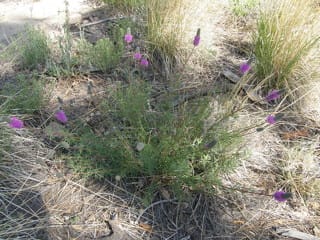 Photo: Chick Keller 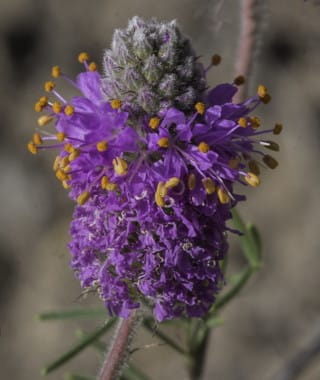 Photo: Craig Martin 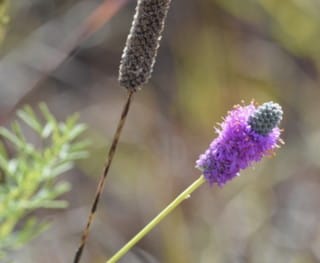 Photo: Mark Kluge | Purple Prairie-Clover, Violet Prairie loverDAPU5 (Dalea purpurea)Family: Fabaceae (Peas) Size: 8 - 30 in (20 - 76 cm) Growth: forb/herb, subshrub; perennial Blooms: Jun 24 - Sep 10 Flower: simple; pink or purple; long cone-like flower heads each on a long stem Leaf: dicot; pinnate arrangement with odd central leaflet; 3 to 5 narrow leaflets Fruit: tiny, egg-shaped pod containing 1 or 2 seeds Status: native; uncommon Habitat: pinyon-juniper, ponderosa --- open, rocky sites, prairies, open woodland, forest openings It is a nitrogen fixing plant and not a true clover in the genus Trifolium. The mature plant has a large taproot and woody stems which has allowed it to adapt to a habitat with periodic wildfires. It is nutritious plant and provides food from many animals and livestock. The leaves can be used to make a tea and the stems were used as brooms. Info Photos Distribution |
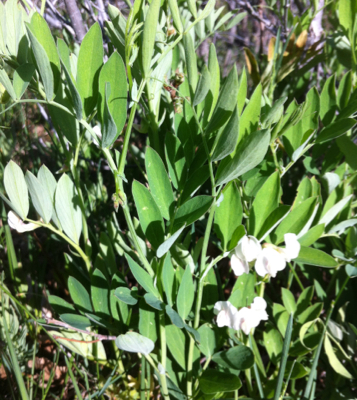 Photo: scottmo 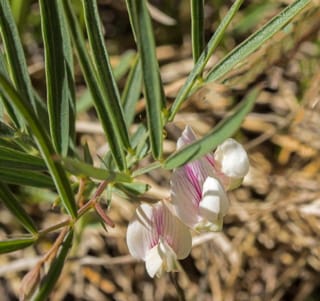 Photo: Craig Martin 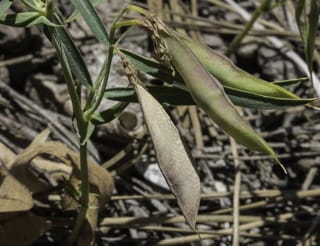 Photo: Craig Martin | Nevada Peavine, White Peavine, Arizona PeavineLALAL3 (Lathyrus lanszwertii var. leucanthus)Family: Fabaceae (Peas) Size: 12 - 24 in (30 - 61 cm) Growth: forb/herb, vine; perennial Blooms: May 30 - Oct 25 Flower: simple; white with a small mount of pink; grow in clusters from long flower stalks Leaf: dicot; two types of leaves: elliptical (higher elevation) versus narrow, linear (lower elevation) Fruit: boat-shaped pod Status: native; uncommon Habitat: ponderosa --- montane, subalpine, woodlands Typical location: Canada Bonita Trail, Valle Canyon Grows from 4,000 ft (1.2 km) to timberline with elevation influencing leaf shape. Like other legumes, fixes nitrogen. Info Photos Distribution |
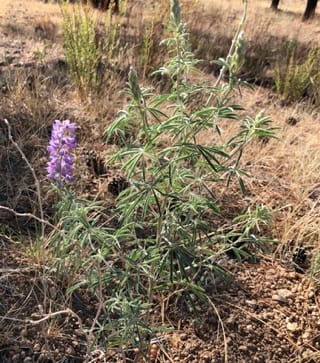 Photo: Christina M. Selby 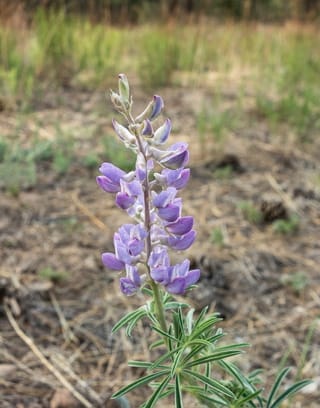 Photo: Chick Keller | Tailcup Lupine, Spurred LupineLUCA (Lupinus caudatus)Family: Fabaceae (Peas) Size: 8 - 24 in (20 - 61 cm) Growth: forb/herb; perennial Blooms: Jun 14 - Aug 18 Flower: simple; blue to purple; individual flowers are scattered on 2 to 6 ft (0.6 to 1.8 m) spikes Leaf: dicot; often silvery; palmately compound; silky hairs Fruit: pinkish-brown, silky pods Status: native; locally common Habitat: mixed conifer, ponderosa --- grassland, sagebrush, desert and mountain shrub, forest Typical location: Behind Guaje Pines Cemetery Seeds can be toxic to humans and animals. The flowers are of special value to bumble bees. Info Photos Distribution |
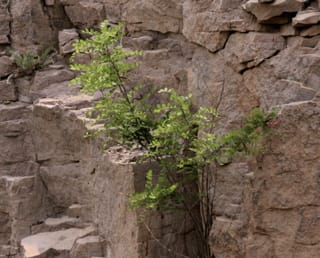 Photo: Patrick Alexander 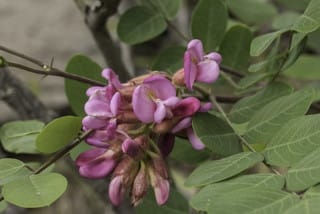 Photo: Craig Martin 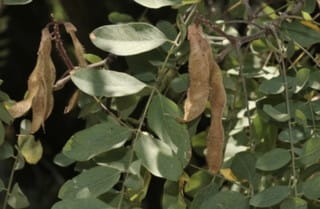 Photo: James Bailey | New Mexico Locust, Mescal BeanRONE (Robinia neomexicana)Family: Fabaceae (Peas) Size: up to 300 in (762 cm) Growth: shrub, tree; perennial Blooms: May 07 - Jul 22 Flower: simple; pink-to-purple; pea-shaped and fragrant; clusters hang from the branches near the ends Leaf: dicot; oblong leaflets arranged on either side of the stem with thorns at the base Fruit: hairy, bean-like pods; pods and seeds will persist for some time Status: native; common Habitat: ponderosa --- deserts, mesa, canyons, conifer forests This many-branched, thicket-forming shrub has reddish-purple branches. Although a true locust, it does not have the invasive characteristics of other species. The New Mexico is sometimes used as an ornamental. Pueblo Native Americans traditionally ate the raw flowers, while the foliage and seeds are eaten by wildlife. Info Photos Distribution Tree Guide |
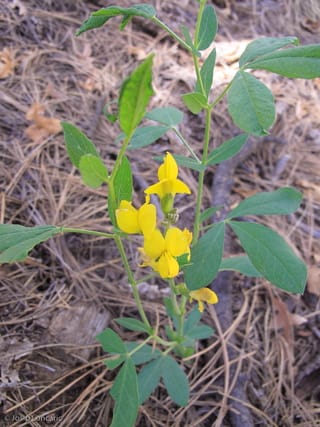 Photo: Josip Loncaric 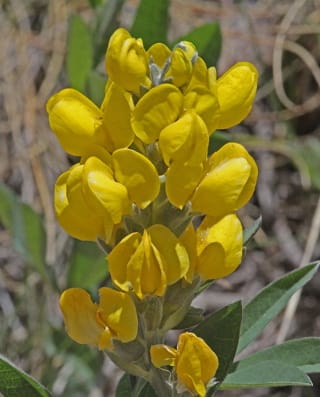 Photo: Jerry Oldenettel | Mountain Goldenbanner, Golden Pea, Montane Goldenbanner, BuckbeanTHMO6 (Thermopsis montana, Thermopsis rhombifolia)Family: Fabaceae (Peas) Size: 1 - 4 in (3 - 10 cm) Growth: forb/herb; perennial Blooms: Apr 14 - Jun 11 Flower: simple; yellow; held on a spike above leaves in elongated clusters Leaf: dicot; 3 long, oval leaflets arranged on a stem compound Fruit: long, brown upright pod which dries to black Status: native; common Habitat: ponderosa --- semi-desert, foothills, woodlands, meadows, open areas The plant has purplish stems with a white coating. The flowers which are particularly attractive to bumblebees have been used as a source of yellow dye. Info Photos Distribution |
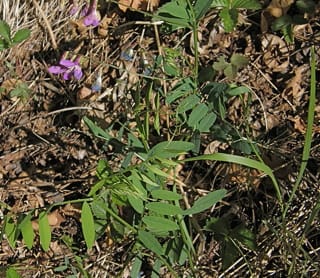 Photo: Chick Keller 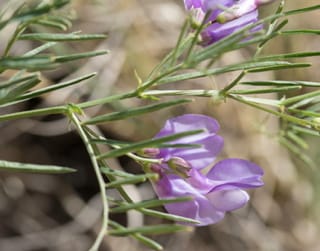 Photo: Craig Martin 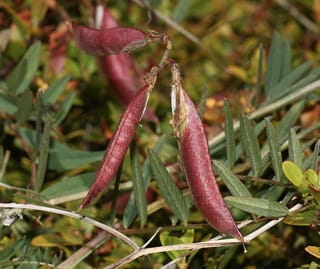 Photo: Walter Siegmund | American VetchVIAM (Vicia americana)Family: Fabaceae (Peas) Size: 6 - 30 in (15 - 76 cm) Growth: forb/herb, vine; perennial Blooms: May 27 - Sep 22 Flower: simple; purple; arranged in loose clusters Leaf: dicot; pinnate; alternate arrangement Fruit: oblong, flattened pod that hands down Status: native; common Habitat: ponderosa --- foothills, montane, subalpine, woodlands, meadows A slender, climbing plant with tendrils that can attach to other vegetation or structures. Nitrogen fixer. Info Photos Distribution |
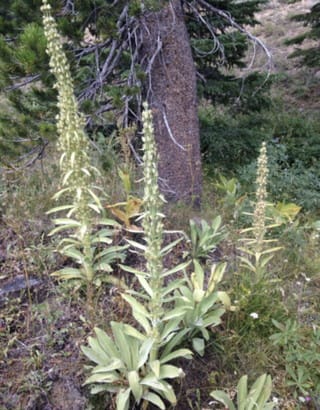 Photo: Damon Tighe 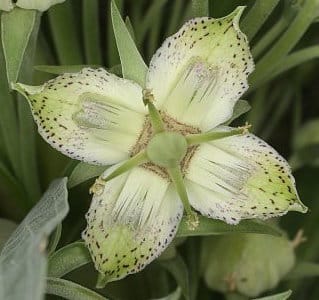 Photo: Bob Dryja 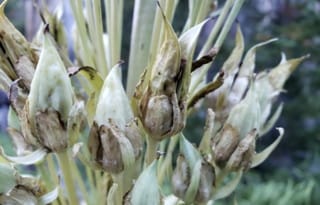 Photo: SM Mallory | Elkweed, Green Gentian, Monument PlantFRSP (Frasera speciosa, Swertia radiata)Family: Gentianacae (Gentians) Size: 24 - 72 in (61 - 183 cm) Growth: forb/herb; perennial Blooms: Jun 22 - Oct 31 Flower: simple; green and white streaked with purple; 4 lobes; grow along most of the stem; more dense at the top; Leaf: dicot; oblong to lance-shaped; whorl of 3 to 7 leaves; very long (up to 20 in or 50 cm); generally hairless Fruit: dark brown, flattened, seeds with a narrow wing Status: native; rare Habitat: mixed conifer --- foothills, montane, subalpine, alpine, meadows, open areas Typical location: Valle Canyon The plant grows for many years but only blooms once and then dies. A blooming plant can have hundreds of flowers. Flowering is synchronized among the plants in a particular area. Elkweed is one of the tallest non-shrublike flowering plants in the area. It has been used medicinally for digestive complaints. In addition, the ground roots mixed with oil is a parasiticide for killing lice. Info Photos Distribution |
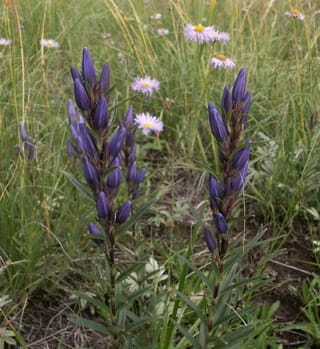 Photo: Chick Keller 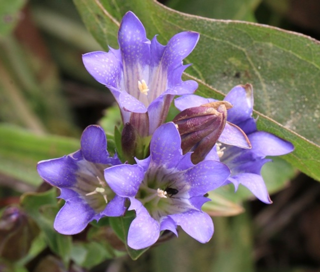 Photo: Morgan Stickrod | Pleated Gentian, Prairie Gentian, Rocky Mountain Bottle GentianGEAF (Gentiana affinis)Family: Gentianacae (Gentians) Size: 6 - 16 in (15 - 41 cm) Growth: forb/herb; perennial Blooms: Aug 21 - Oct 20 Flower: simple; purple with white; closely growing clusters of funnel-shaped flowers; 5 lobes; green center and dots Leaf: dicot; short, thin; growing between the flower heads Fruit: cylindrical capsules with short stripes; seeds winged Status: native; uncommon Habitat: mountain meadow, ponderosa --- wet meadows, montane, subalpine, alpine Typical location: Canada Bonita, Dot Grant Trail This plant is often overlooked as it frequently grows among grasses and other tall plants. However, there may be dozen of plants scattered widely over an open area. The plant is distinguished by it maroon colored stem. New plants will sprout from the roots of older plants. Info Photos Distribution |
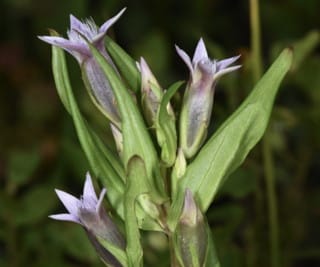 Photo: 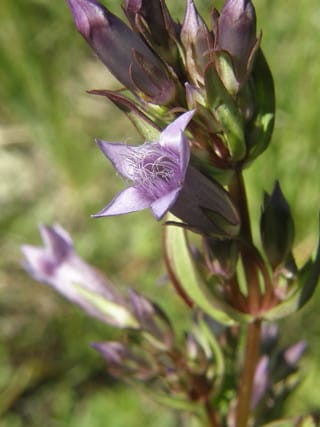 Photo: Chick Keller | Autumn Dwarf Gentian, Little GentianGEAM3 (Gentianella amarella)Family: Gentianaceae (Gentians) Size: up to 30 in (76 cm) Growth: forb/herb; annual, biennial Blooms: Aug 02 - Oct 20 Flower: simple; shades of purple and white; 5 lobes with 5 stamens; circular group of long white hairs; grows in small clusters at the tip of the stem Leaf: dicot; elliptical to lanceolate leaves with a purple tinge; hairless; opposite pairs with 5 veins Fruit: 2-part capsule; seeds smooth and slightly flattened Status: native; uncommon Habitat: montane, subalpine, woodlands, meadows, open areas Typical location: Canada Bonita Trail The Autumn Dwarf Gentian is found throughout the Western United States and across Canada to the East Coast. It is also native throughout Northern Europe. Gentianella amarella is one of the gentian species that is a source of medicinal gentian root. Gentian is a bitter herb used even today for the treatment of digestive disorders and general debility. In the past it was used to treat malaria. Info Photos Distribution |
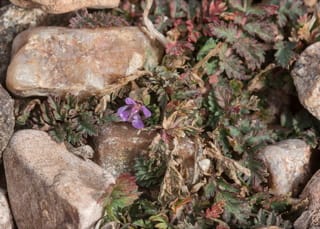 Photo: Craig Martin 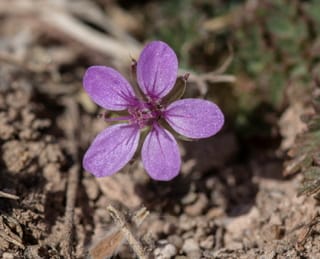 Photo: Craig Martin 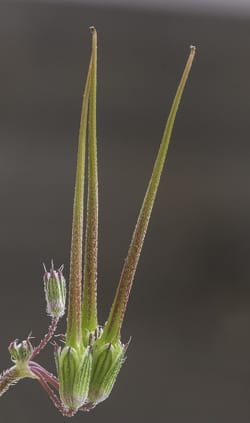 Photo: Craig Martin | Redstem Stork's Bill, Redstem Filaree, Pinweed, CranesbillERCI6 (Erodium cicutarium)Family: Geraniacea (Geraniums) Size: 6 - 12 in (15 - 30 cm) Growth: forb/herb; annual, biennial Blooms: Jan 02 - Dec 30 Flower: simple; pink, often with dark spots; arranged in loose clusters with 10 filaments Leaf: dicot; deeply cleft; fern-like Fruit: long, narrow, pointed seed pods Status: naturalized plant; common Habitat: disturbed soil --- desert scrub, grasslands, oak woodlands, semi-desert grassland, lawns, gardens; more common at lower elevations It was introduced into California from the Mediterranean Basin in the eighteenth century. The entire plant is edible and resembles a parsley when picked young. It is considered to be a weed in some areas. Info Photos Distribution Weed Guide |
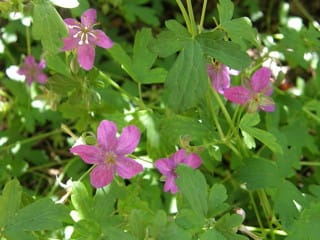 Photo: Chick Keller 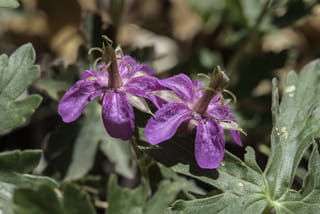 Photo: Craig Martin 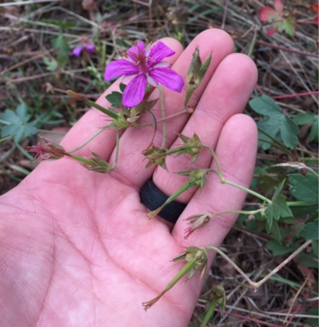 Photo: ajileong5 | Pineywoods Geranium, Purple GeraniumGECA3 (Geranium caespitosum)Family: Geraniaceae (Geraniums) Size: up to 18 in (46 cm) Growth: forb/herb, subshrub; perennial Blooms: Jun 01 - Oct 20 Flower: simple; pink or purple; 5 elliptic to obovate petals; dark veins Leaf: dicot; deep cuts and 5 to 7 rounded lobes; lined with large teeth Fruit: long thin capsule with 1 seed Status: native; common Habitat: ponderosa --- foothills, montane, subalpine, woodlands Typical location: Valle Canyon Each plant only has a few flowers and tends to lean and sprawl. Can be seen trailside hidden by grasses with its reddish, short-hairy stems. Parts of the plant have been used as an astringent and to treat sores. Info Photos Distribution |
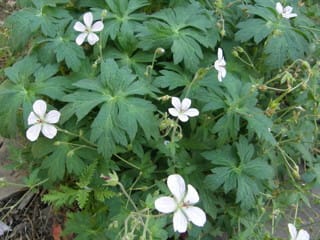 Photo: Chick Keller 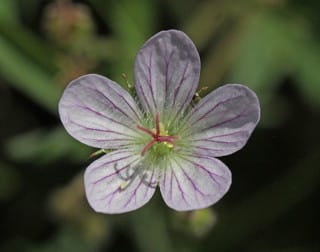 Photo: Jerry Oldenettel | Richardson's Geranium, White CranesbillGERI (Geranium richardsonii)Family: Geraniaceae (Geraniums) Size: 8 - 32 in (20 - 81 cm) Growth: forb/herb; perennial Blooms: Jun 01 - Oct 20 Flower: simple; white or purple with dark purple veins; 5 septals and 5 pointed petals Leaf: dicot; palmate-shaped with 5 segments Fruit: small, straight body with a short style Status: native; common Habitat: mixed conifer --- foothills, montane, subalpine, woodlands, meadows Typical location: Canada Bonita Trail This geranium is found just below tree line. Its size is sensitive to the amount of moisture it receives. It grows from a tough, woody taproot and will develop rhizomes as it ages. Info Photos Distribution |
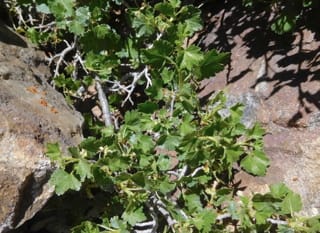 Photo: Ellen Hildebrandt 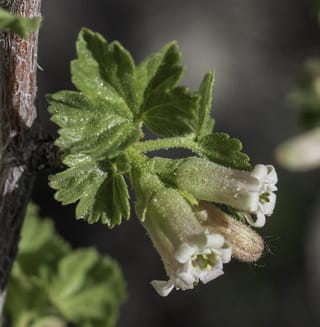 Photo: Craig Martin 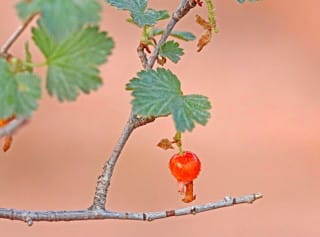 Photo: Jerry Oldenettel | Wax Currant, Western Red Currant, White Squaw CurrantRICE (Ribes cereum)Family: Grossulariaceae (Currants) Size: 8 - 80 in (20 - 203 cm) Growth: shrub; perennial Blooms: Apr 01 - May 30 Flower: simple; pink and white; bell-shaped; clusters with 2 to 9 flowers Leaf: dicot; light-green foliage; turns yellow in autumn Fruit: bright-red berries with dried flower remnant at the end Status: native; common Habitat: ponderosa --- grows in mountain forests, sagebrush, woodlands Compact, rounded shrub with cherry-like bark. The plant is aromatic, with a "spicy" scent. The berries are edible but considered to be fairly tasteless. Info Photos Distribution |
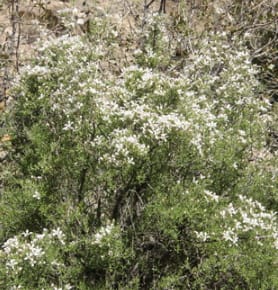 Photo: Chick Keller 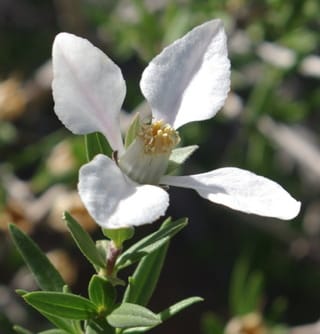 Photo: Jerry Friedman 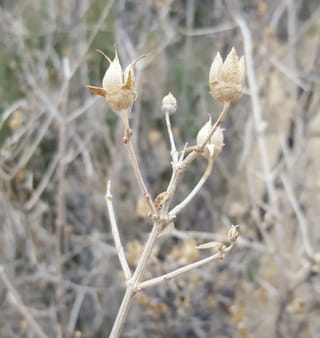 Photo: Alex Abair | Cliff Fendlerbush, False Mock OrangeFERU (Fendlera rupicola)Family: Hydrangeaceae (Hydrangeas) Size: 40 - 120 in (102 - 305 cm) Growth: shrub; perennial Blooms: May 07 - May 30 Flower: simple; pink buds opening up to white flowers; 4 petals with broad tips and narrow bases Leaf: dicot; oblong; thick and twisted; opposite arrangement Fruit: outer shell persistent Status: native; uncommon Habitat: pinyon-juniper --- dry, rocky mountain slopes, deserts, mesas Typical location: Overlook Park, Red Dot Trail Semi-evergreen, multi-branched shrub with showy flowers. The overall shape of the plant is vertical. It provides good browse for wildlife and domestic animals. Info Photos Distribution |
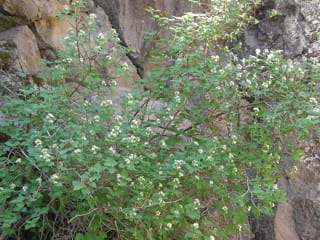 Photo: Chick Keller 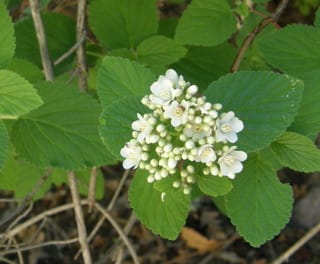 Photo: Chick Keller | Fivepetal Cliffbush, Five-petal Cliffbush, WaxflowerJAAM (Jamesia americana)Family: Hydrangeaceae (Hydrangeas) Size: 36 - 72 in (91 - 183 cm) Growth: shrub; perennial Blooms: Jun 11 - Jul 22 Flower: simple; white to pink; 4 or 5 petals; produced in erect branching clusters Leaf: dicot; broadly oval and coarsely-toothed; opposite arrangement Fruit: dry capsule with numerous small seeds Status: native; common Habitat: mixed conifer, ponderosa --- grows in mountainous areas in the range of 5400 - 9800 ft (1600 – 3000 m) Typical location: Kinnikinnick Park The genus Jamesia contains the last two species of shrubby plants in the hydrangea family surviving in the US. The genus is named for Edwin James who was the first non-native explorer to climb to the top of Pike’s Peak and described over a 100 new species. Jamesia americana is the more common of the two species and is noted for shreddy, gray to reddish-brown bark and numerous flowers. Info Photos Distribution |
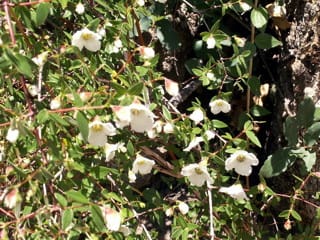 Photo: Chick Keller 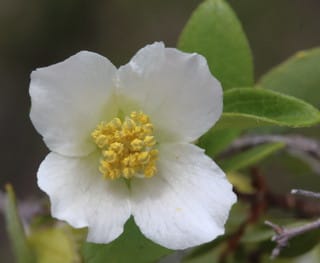 Photo: Craig Martin | Littleleaf Mock Orange, Littleleaf MockorangePHMI4 (Philadelphus microphyllus)Family: Hydrangeaceae (Hydrangeas) Size: 48 - 72 in (122 - 183 cm) Growth: shrub; perennial Blooms: Jun 24 - Aug 18 Flower: simple; white with yellow center; 4 petals and sepals; solitary flower or at most a cluster of 2 or 3; sweetly scented Leaf: dicot; small leaves, opposite orientation; lance-shaped with serrated margins Fruit: small capsule containing numerous tiny seeds Status: native; uncommon Habitat: ponderosa --- arid rocky slopes, cliffs, coniferous woods Littleleaf Mock Orange received its common in reference to its flowers which look similar to those of many citrus fruits and smell like orange flowers. Augustus Fendler was the first to find this plant in 1847 in the mountains above Santa Fe. The young branches of the plant are covered with stiff hairs while the older branches have grayish, shedding bark. This plant may be somewhat toxic to livestock. The leaves can be crushed and mixed with water to produce a soap. Info Photos Distribution |
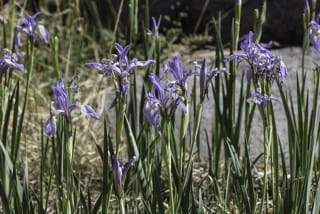 Photo: Craig Martin 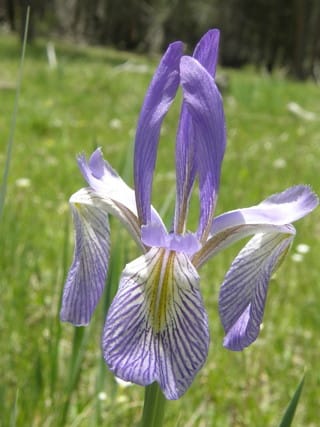 Photo: Chick Keller 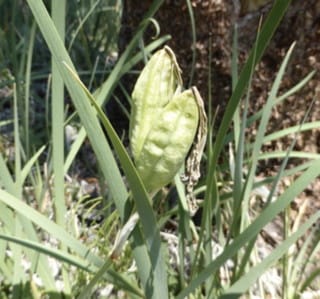 Photo: sea-kangaroo | Rocky Mountain Iris, Western Blue Flag Iris, Paria IrisIRMI (Iris missouriensis)Family: Iridaceae (Irises) Size: 12 - 36 in (30 - 91 cm) Growth: forb/herb; perennial Blooms: May 30 - Jul 19 Flower: simple; blue to purple, rarely white; deeply veined; petals upright and spread out; usually only 2 or 3 per plant Leaf: monocot; stiff, very long, light green leaves with some white at the base Fruit: seedpods upright, large and chunky Status: native; common Habitat: montane --- foothills, subalpine, wetlands, meadows, openings Typical location: Canada Bonita Often found in large patches in meadows and mountain foothills but grows as a solitary plant in woods. Considered a nuisance in pasture land due to its bitter taste and grazing only promotes further growth. The Zuni used the chewed root as a poultice for newborns. Info Photos Distribution |
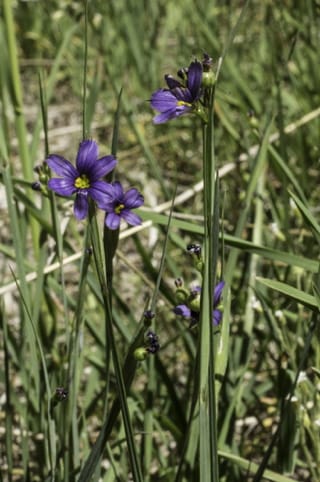 Photo: Craig Martin 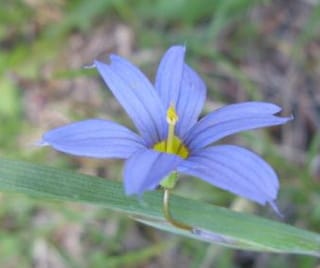 Photo: Janie O'Rourke | Strict Blue-eyed Grass, Mountain Blue-eyed GrassSIMO2 (Sisyrinchium montanum)Family: Iridaceae (Irises) Size: 5 - 20 in (13 - 51 cm) Growth: forb/herb; perennial Blooms: Jul 19 - Sep 10 Flower: simple; blue to purple; 6 petals with notched tips Leaf: monocot; long, narrow leaves growing from the plant base Fruit: round to oval capsule divided into 3 sections Status: native; uncommon Habitat: montane, meadows, openings Typical location: Canada Bonita This plant is not actually a grass. It grows in clumps but may be hard to find since it can be intertwined with true grasses. Info Photos Distribution |
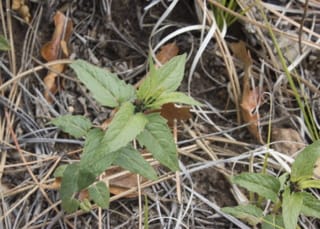 Photo: lysa 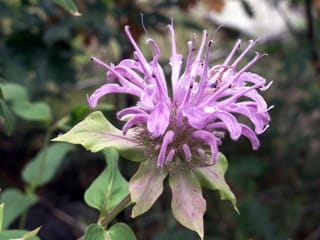 Photo: Chick Keller | Wild Bergamot, Mintleaf Beebalm, HorsemintMOFI (Monarda fistulosa)Family: Lamiaceae (Mints) Size: 30 - 36 in (76 - 91 cm) Growth: forb/herb, subshrub; perennial Blooms: Jul 02 - Aug 27 Flower: simple; pink, purple, or white; clusters of flowers that look like pompoms Leaf: dicot; gray-green; smell minty Fruit: very small oblong nutlet Status: native; common Habitat: mixed conifer --- dry open woods, fields, wet meadows and ditches Typical location: Pajarito Canyon Bergamot grows from slender creeping rhizomes. Can be used to make a mint tea. Info Photos Distribution |
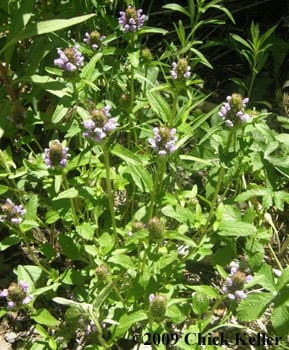 Photo: Chick Keller 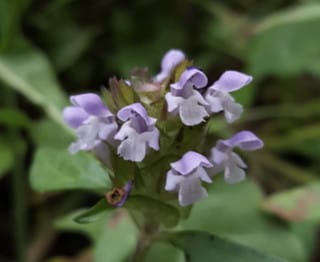 Photo: Alex Abair 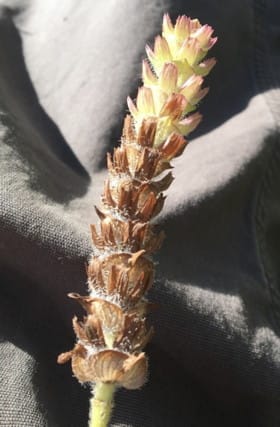 Photo: Mitch Manford | Common Selfheal, Heal-allPRVU (Prunella vulgaris)Family: Lamiaceae (Mints) Size: 2 - 12 in (5 - 30 cm) Growth: forb/herb; perennial Blooms: Jun 22 - Oct 20 Flower: simple; shades of purple, occasionally white; long, fused tube; 2 lips with lower lip toothed Leaf: dicot; opposite arrangement; oval to lance-shaped with a blunt tip; hairy and shallowly toothed Fruit: yellowish-brown with dark stripes; 4-sectioned capsule Status: native; uncommon Habitat: riparian --- montane, subalpine, woodlands, meadows Typical location: Canada Bonita This is a very small, slender mint that is often missed. The plant is known as “heal-all” due to its traditional use in healing several ailments such as wounds and throat infections. The leaves can be eaten either cooked or raw. A cold water infusion makes a refreshing drink. The plant propagates both by seed and by creeping stems that root at the nodes. It makes a good ground cover. Info Photos Distribution |
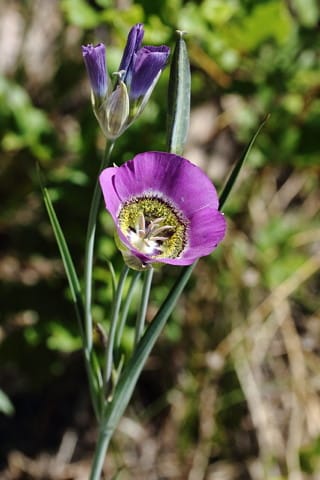 Photo: Craig Martin 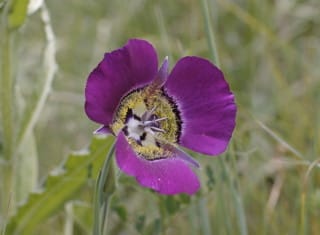 Photo: Chick Keller | Mariposa LilyCAGU (Calochortus gunnisonii)Family: Liliaceae (Lilies) Size: up to 18 in (46 cm) Growth: forb/herb; perennial Blooms: Jul 14, 2000 - Aug 27, 2000 Flower: simple; purple to white; dark purple markings; large, showy, and bell-shaped; sepals shorter than petals, filaments shorter than anthers Leaf: monocot; thin grass-like; hairless; basal leaves wither with the season Fruit: linear, erect capsule; seeds flat and inflated Status: native; common Habitat: foothills, montane, subalpine, meadows Typical location: Camp May The genus of the plant (Calochortus comes from the Greek for “beautiful” and “grass”, referring to its exotic flowers and thin leaves. The flower is distinguished by a broad band of yellow hairs above an elliptically-shaped structure on each petal. The plant sprouts from bulbs that are buried deep within the soil. The bulbs are edible. Info Photos Distribution |
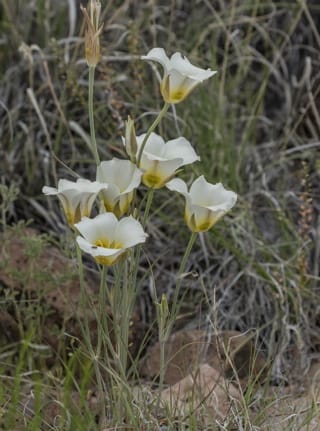 Photo: Craig Martin 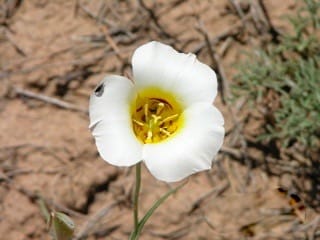 Photo: Jerry Oldenettel | Sego Lily, Nuttall's MariposaCANU3 (Calochortus nuttallii)Family: Liliaceae (Lilies) Size: 6 - 18 in (15 - 46 cm) Growth: forb/herb; perennial Blooms: May 15 - Jun 30 Flower: simple; white with yellow base and red ring; sometimes pink or tinged with pink; 1 to 3 showy tulip-like flowers Leaf: monocot; curved and grasslike; alternate arrangement Fruit: upright, lance-shaped capsules Status: native; common Habitat: canyon, grassland, scrubland --- sandy soils, hot dry areas at up to 8,000 ft (2,500 m) elevations Typical location: Red Dot Trail, Ancho Canyon The common name for this plant (Sego) comes from the Shoshonean word for “edible”. The bulbs can be dried for use in winter, eaten raw, or roasted. The flowers have been used ceremonially. Info Photos Distribution |
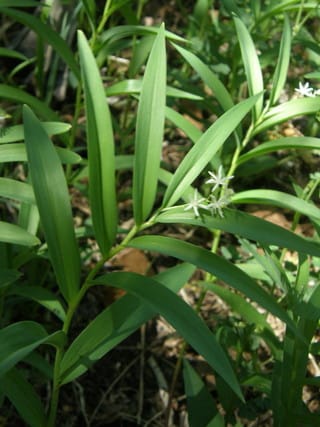 Photo: Chick Keller 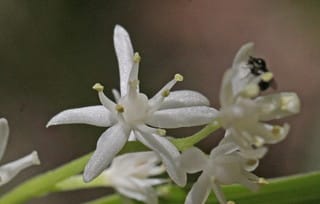 Photo: Jerry Oldenettel 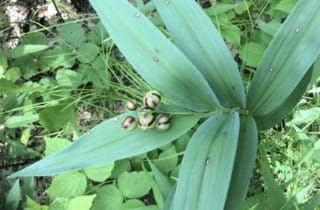 Photo: Sheri | Starry False Lily of the Valley, Starry False Solomon's SealMAST4 (Maianthemum stellatum, Smilacina stellata)Family: Liliaceae (Lilies) Size: 12 - 24 in (30 - 61 cm) Growth: forb/herb; perennial Blooms: Jun 01 - Jun 30 Flower: simple; white; tiny star-like;small clusters at the tip of the stem Leaf: monocot; lance-shaped with smooth edges; slightly folded inward; alternative spacing Fruit: seed capsules turning yellow and then red Status: native; locally common Habitat: mixed conifer --- montane, subalpine, woodlands Thrives in moist locations. Starry False Lilly of the Valley has lateral underground roots from which new plants can sprout leading to colonies of plants. The fruits and leaves are eaten by bears. Info Photos Distribution |
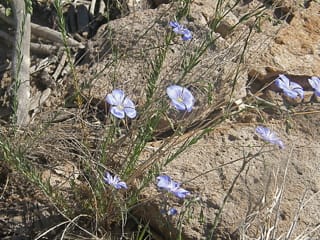 Photo: Chick Keller 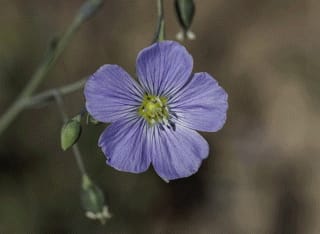 Photo: Craig Martin 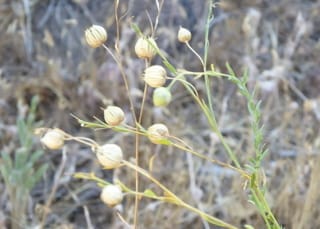 Photo: hikingsandiego | Western Blue Flax, Lewis Flax, Prairie FlaxLILE3 (Linum lewisii)Family: Linaceae (Flax) Size: 18 - 20 in (46 - 51 cm) Growth: forb/herb, subshrub; perennial Blooms: May 19 - Aug 18 Flower: simple; blue or purple; darker veins; 5 petals Leaf: dicot; narrow long leaves; bristle at top Fruit: sphericl to elliptical capsule; spits open on the top Status: native; uncommon Habitat: ponderosa --- foothills, montane, subalpine, woodlands, openings, meadows Typical location: Lower Quemazon Trail This flax has long slender stems that often bend over as buds develop. The buds will open at sunrise and stay open only part of the day. Info Photos Distribution |
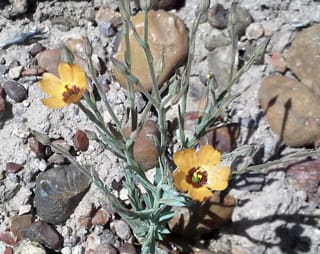 Photo: wingedchimera 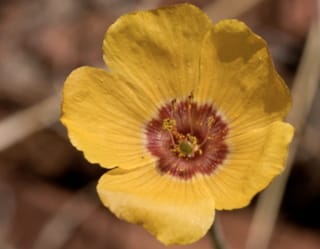 Photo: Peter Alexander | Plains FlaxLIPU4 (Linum puberulum, Cathartolinum puberulum)Family: Linaceae (Flax) Size: up to 2 in (5 cm) Growth: forb/herb; annual Blooms: Apr 14 - May 14 Flower: simple; orange with red center; open flower with five petals Leaf: dicot; greenish-gray; very narrow, almost grasslike Fruit: ovoid capsule that splits into 5 parts on maturation Status: native; uncommon Habitat: ponderosa --- semi-desert, foothills, openings, meadows Typical location: Overlook Park, White Rock Canyon Plant most often seen along canyon rims, often growing is sparse patches. The flower petals are so loosely attached that the least amount of movement can cause them to fall off. Native Americans have used the plant to treat eye inflammation. Info Photos Distribution |
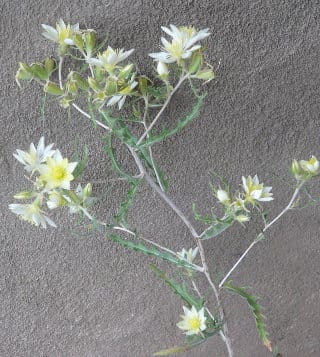 Photo: Becky Shankland 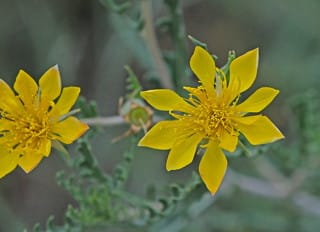 Photo: Jerry Oldenettel 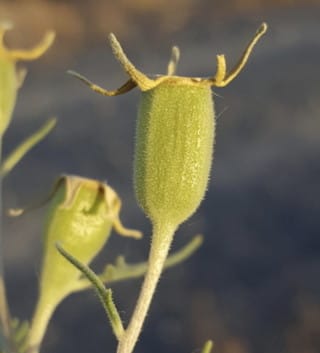 Photo: Alex Abair | Adonis Blazingstar, Stickleaf, Manyflowered BlazingstarMEMU3 (Mentzelia multiflora)Family: Loasaceae (Blazingstar/Stickleaf) Size: 24 - 30 in (61 - 76 cm) Growth: forb/herb; biennial, perennial Blooms: Jun 01 - Aug 31 Flower: simple; yellow or white with yellow center; 5 petals and 5 septa’s; long, outer rows of stamens resembling petals Leaf: dicot; bright green; long, narrow and lobed; covered in short, hooked hairs; sticky Fruit: greenish cup-shaped capsules; seeds oval with wing Status: native; uncommon Habitat: disturbed soil The Adonis Bazingstar has several distinctive features that make it relatively easy to recognize. It tall with whitish, multi branched stems. The lower surface of the leaves adheres tightly to clothing. The flowers open in the afternoon and are closed during the following morning. Info Photos Distribution |
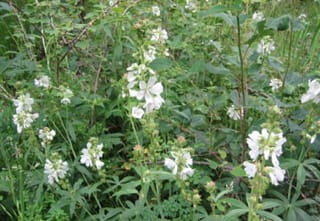 Photo: Corry Clinton 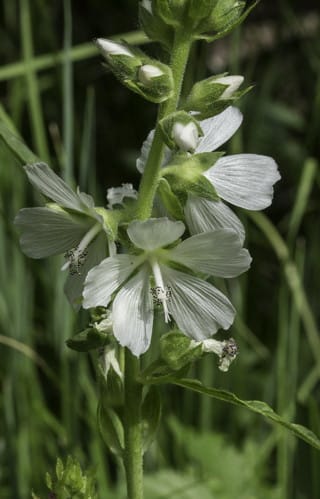 Photo: Craig Martin 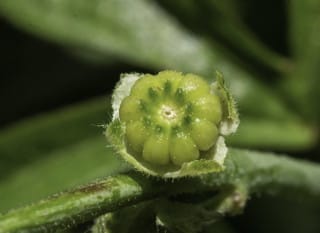 Photo: Craig Martin | White Checkermallow, White CheckerBloom, Wild HollyhockSICA3 (Sidalcea candida)Family: Malvaceae (Mallows) Size: up to 36 in (91 cm) Growth: forb/herb; perennial Blooms: Jul 22 - Sep 11 Flower: simple; white; paper-thin; 5 petals; large flowers held on upright stems to form spikes Leaf: dicot; glossy, roundish basal leaves; lobed upper leaves Fruit: large five-sided capsule that splits open Status: native; uncommon Habitat: riparian --- montane, subalpine, streamsides, wetlands Sidalcea candida was named by Asa Gray from specimens collected by Augustus Fendler in 1847 near a creek in Santa Fe. The plant grows straight, slim, and tall with large flowers at its tips. It is rhizomatous and commonly found in loose clusters or even dense patches. Info Photos Distribution |
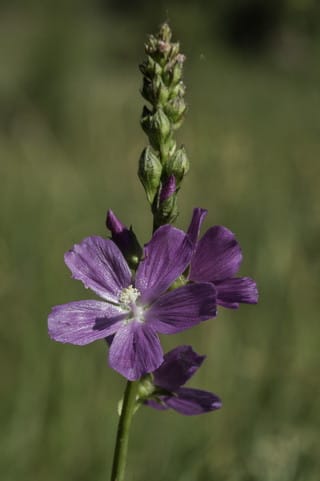 Photo: Craig Martin 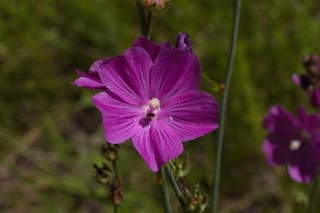 Photo: Craig Martin | New Mexico Checkermallow, Rocky Mountain Checkerbloom, Salt Spring CheckerbloomSINE3 (Sidalcea neomexicana)Family: Malvaceae (Mallows) Size: up to 36 in (91 cm) Growth: forb/herb; perennial Blooms: Jul 22 - Sep 11 Flower: simple; pink to purple; 5 petals; large flowers held on upright stems to form spikes Leaf: dicot; circular, lobed basal leaves; more deeply incised mid-plant; deeply incised at top Fruit: large five-sided capsule that splits open Status: native; common Habitat: riparian --- montane, subalpine, streamsides, wetlands Sidalcea neomexicana was named by Asa Gray from specimens collected by Augustus Fendler in 1847 near a moist meadow in Santa Fe. Like others in the same genus, this plant likes to have its feet wet. It grows straight, slim, and tall with large flowers at its tips. An infusion from plant has been made and used for treatment of internal injuries. Info Photos Distribution |
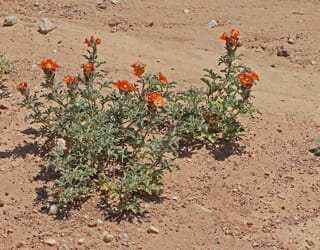 Photo: Jerry Oldenettel 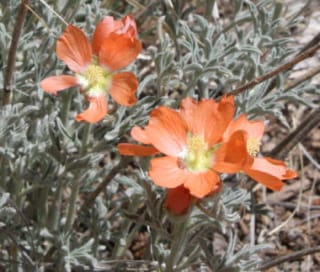 Photo: Akkana Peck | Scarlet Globemallow, Caliche Globemallow, Cowboy's DelightSPCO (Sphaeralcea coccinea)Family: Malvaceae (Mallows) Size: 4 - 16 in (10 - 41 cm) Growth: forb/herb, subshrub; biennial, perennial Blooms: Apr 22 - Oct 15 Flower: simple; red to orange; overall saucer-shaped; 5 notched, broad petals in a terminal cluster Leaf: dicot; palm-like leaves covered in a soft, velvet layer of hair Fruit: schizocarp with up to 14 single-seeded carpels Status: native; common Habitat: pinyon-juniper --- semi-desert, foothills, disturbed areas, woodlands Typical location: Red Dot Trail The Scarlet Globemallow spreads by rhizomes and may lean over or stay close to the ground since its stems are not sturdy. It is covered in dense hairs. Deer and other wildlife will graze on the plant, while birds and small animals eat the fruit. Info Photos Distribution |
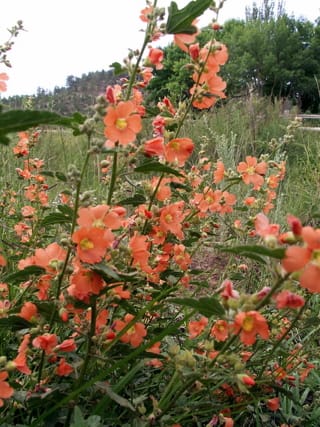 Photo: Chick Keller 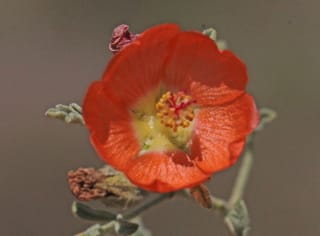 Photo: Jerry Oldenettel | Fendler's Globemallow, Desert Globemallow, Thicket GlobemallowSPFEE (Sphaeralcea fendleri)Family: Malvaceae (Mallows) Size: 36 - 48 in (91 - 122 cm) Growth: forb/herb, subshrub; perennial Blooms: Jul 14 - Oct 31 Flower: simple; various shades of orange with yellow center; hibiscus-like with 5 petals and 5 septas that are fully opened Leaf: dicot; gray-green with fine star-shaped hairs; alternate arrangement; lobed or veined with scalloped margins Fruit: spherical, dehiscent, pie-shaped capsule that splits into segments Status: native; common Habitat: pinyon-juniper, ponderosa --- desert, upper elevation foothill canyons, mountain Sphaeralcea fendleri can be distinguished from other Globemallows by the fact that it does not display distinctive cup-shaped flowers but rather fully opened petals that do not overlap or touch. This plant is an important food source for Bighorn Sheep and it is likely that its large seeds are eaten rodents. Like others Globemallows, Fendler’s produces a mucilaginous compound that can soothe skin irritations and insect bites. Info Photos Distribution |
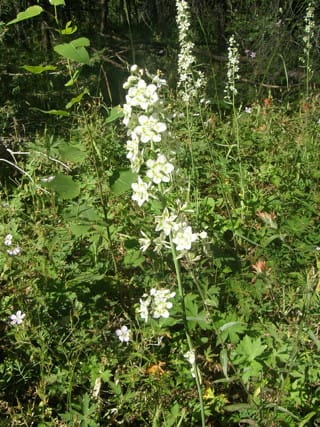 Photo: Chick Keller 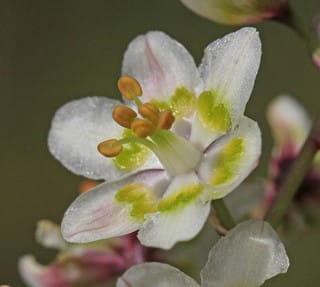 Photo: Jerry Oldenettel  Photo: Eric Howe | Mountain Deathcamas, Elegant Camas, Alkali GrassZIEL2 (Zigadenus elegans, Anticlea elegans)Family: Melanthiaceae (Death Camus) Size: 6 - 30 in (15 - 76 cm) Growth: forb/herb; perennial Blooms: Jul 09 - Sep 10 Flower: simple; white with green; lily-like flowers with two-pronged, greenish glands on each petal; 3 petals and 3 sepals, identical in appearance (tepals); dense clusters along upper portion of stems Leaf: monocot; long, thin leaves; mostly basal with faint parallel line and a midrib Fruit: 3-parted, oval shaped cone Status: native; uncommon Habitat: mixed conifer --- subalpine, meadows Typical location: Canada Bonita Trail The Mountain Deathcamas is not a grass even though its leaves are grass-like. It has received its common name from the fact that all parts of the plant are highly poisonous. It was responsible for the deaths of many early setters due to the fact that it is similar in some ways to certain edible species like onion. Stout stems grow out of a large, black-coated bulb. It has also been the cause of death for livestock. Meriweather Lewis collected a specimen near the Blackfoot River during the 1806 expedition. Info Photos Distribution |
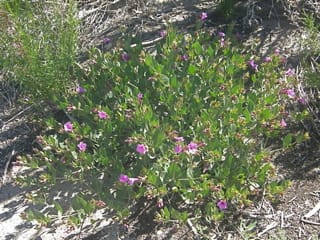 Photo: Chick Keller 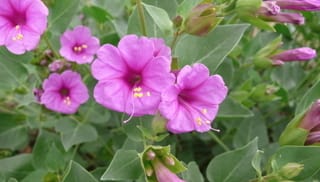 Photo: Jerry Oldenettel | Colorado Four O'clockMIMU (Mirabilis multiflora, Mirabilis glandulosa)Family: Nyctaginaceae (Four O'Clocks) Size: 15 - 18 in (38 - 46 cm) Growth: forb/herb, subshrub; perennial Blooms: Jun 16 - Sep 10 Flower: simple; pink or purple; tubular with 5 lobes Leaf: dicot; thick, shiny, and cordate; opposite arrangement Fruit: dark; shaped like miniature hand-grenades Status: native; common Habitat: pinyon-juniper --- grows on mesas, not canyons Typical location: Anniversary Trail Erect plant with hemispherical bushy growth. Flowers open in late afternoon. Info Photos Distribution |
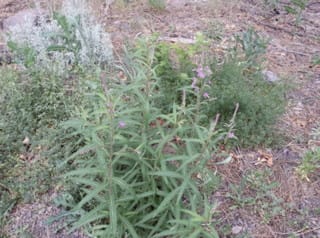 Photo: Craig Martin 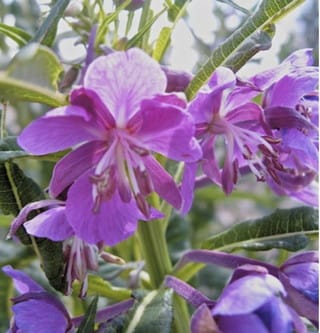 Photo: David  Photo: M Feaver | Fireweed, Willow Herb, Great Willow HerbCHAN9 (Chamerion angustifolium, Epilobium angustifolium)Family: Onagraceae (Evening Primroses) Size: 48 - 72 in (122 - 183 cm) Growth: forb/herb; perennial Blooms: Jul 01 - Sep 23 Flower: simple; pink to purple and white; many flowers in an elongated cluster; 4 sepals with 4 larger petals for each individual flower; curling white stamens, topped by brownish-red anthers Leaf: dicot; long, narrow lanceolate; grow on lower half of stem; point slightly upwards; 2 outermost veins form a ring Fruit: slender, elongated capsule with tufts of hair Status: native; locally common Habitat: mixed conifer --- forest openings and edges, grasslands, tundra edges, moist meadow Typical location: Nail Trail, Pajarito Canyon The common name of Fireweed is derived from the abundance of this plant as a colonizer on burnt sites after forest fires. The flowers are visited by a variety of insects. Many butterflies and moths use it as the host plant for laying their eggs. Several different Native American tribes use the plant as a food source. It has also been used medicinally to treat boils and cuts. Info Photos Distribution |
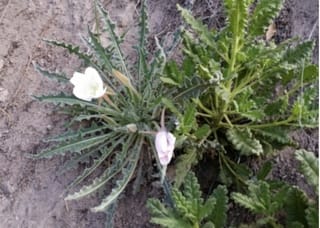 Photo: Craig Martin 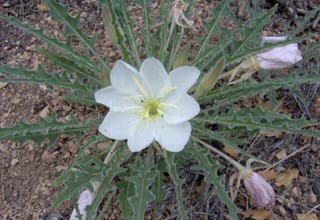 Photo: Barbara Calef | Tufted Evening Primrose, Fragarent Evening Primrose, Gumbo Evening PrimroseOECA10 (Oenothera caespitosa)Family: Onagraceae (Evening Primroses) Size: up to 8 in (20 cm) Growth: forb/herb, subshrub; perennial Blooms: Mar 27 - Jul 17 Flower: simple; white; 4 petals that are deeply notched at tip; flowers become pink as they age Leaf: dicot; long, thin, lobed leaves; irregularly lobed or toothed Fruit: rough seedpods; inconspicuous Status: native; uncommon Habitat: pinyon-juniper --- foothills, montane, woodlands, openings Typical location: Anniversary Trail Spreads by underground roots and often forms large colonies. Flowers open with the evening and wither to pink by the next afternoon. Dependent on hawkmoths for pollination. Info Photos Distribution |
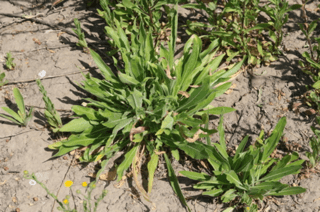 Photo: James Bailey 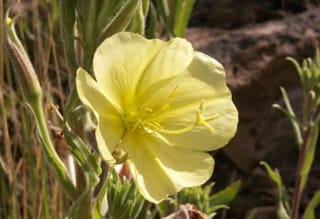 Photo: Chick Keller 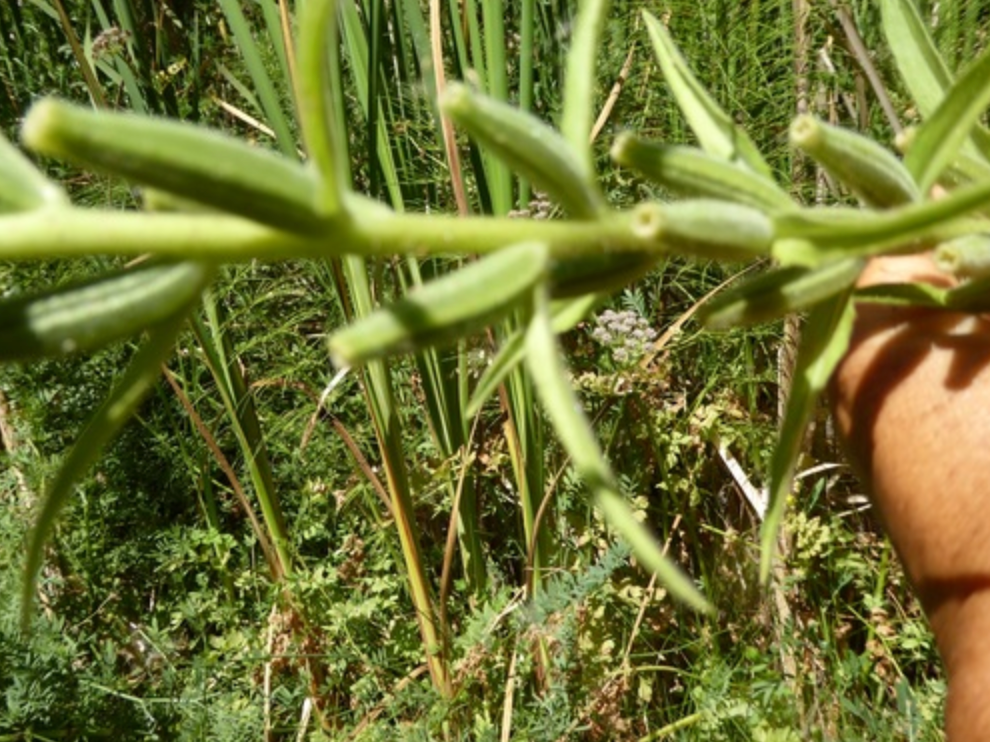 Photo: hikingsandiego | Hooker's Evening Primrose, Western Evening Primose, Hooker's Evening-PrimroseOEEL (Oenothera elata)Family: Onagraceae (Evening Primroses) Size: up to 36 in (91 cm) Growth: forb/herb; biennial, perennial Blooms: Jun 26 - Oct 31 Flower: simple; yellow, turning orange when wilted the morning after opening; 4 heart-shaped petals with protruding stamens; borne atop long stems Leaf: dicot; grey-green; white veins; sparse hairs; form a basal rosette Fruit: narrow, long capsules that taper upward; reddish-brown seeds Status: native; common Habitat: disturbed soil, ponderosa --- foothills, montane, wet meadows, roadsides Typical location: Los Alamos This is one of the largest and showiest of the evening primroses. The flowers are fragrant and attract many moths and butterflies. The plant produces a large number of seeds which in turn attract a large variety of seed-eating birds. The Zuni people used a poultice of the powdered flower to treat swellings. In addition, various parts of the plant have been used for the treatment of colds. Info Photos Distribution |
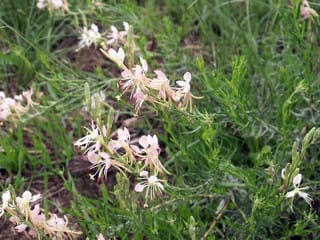 Photo: Chick Keller 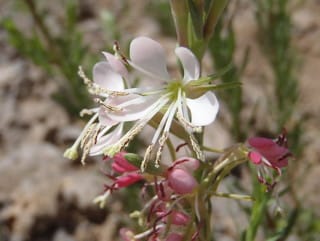 Photo: Craig martin 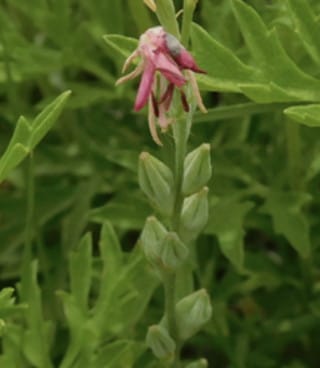 Photo: Ellen Hildebrandt | Scarlet Beeblossom, Scarlet Gaura, Scarlet EveningprimroseGACO5 (Oenothera suffrutescens)Family: Onagraceae (Evening Primroses) Size: up to 12 in (30 cm) Growth: forb/herb, subshrub; perennial Blooms: Jul 14 - Oct 20 Flower: simple; white to pink; four spoon-shaped petals that start out as white and turn pink with ages; four long, stiff sepals which open and fall outward; spike inflorescence Leaf: dicot; long, linear; margins wavey; alternate arrangement Fruit: short, woody ice-cream cone-shaped capsule Status: native; uncommon Habitat: pinyon-juniper --- dry prairies, roadsides, disturbed sites Colony forming plant with several stems branched near the base. The color change in the flowers can occur as quickly as over a single day. This plant is found across much of North America, in particular the western and central regions. Info Photos Distribution |
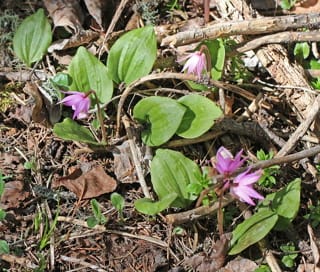 Photo: Jerry Oldenettel 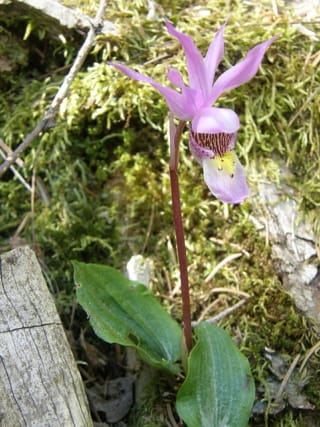 Photo: Chick Keller 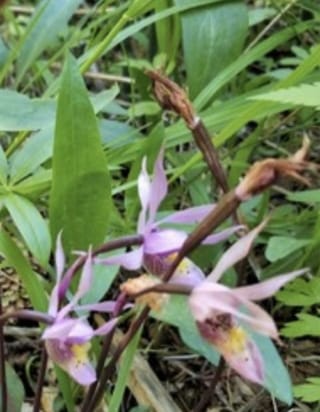 Photo: Josh B | Fairy Slipper, Fairy Slipper Orchid, Calypso OrchidCABU (Calypso bulbosa)Family: Orchidaceae (Orchids) Size: 2 - 8 in (5 - 20 cm) Growth: forb/herb; perennial Blooms: May 30 - Jun 17 Flower: simple; pink or purple with a white lip; may have dark spotting on lip; yellow beard Leaf: monocot; simple oval leaves; a simple basal leave for each flower stalk Fruit: upright elliptical capsules Status: native; rare Habitat: mixed conifer --- ground litter and mossy areas in cool, damp, mainly coniferous woods Typical location: Canada Bonita Trail This orchid often grows singly and close to the ground among other plants. The range of this species is circumpolar from the US and Canada around through Europe and into Asia. It is very susceptible to disturbance and is considered threatened in several US states and parts of Scandinavia. Although the plant makes most of it own food, it utilizes at least one fungus for the intake of some carbon. Info Photos Distribution |
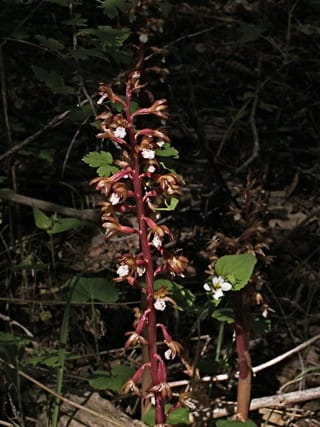 Photo: Chick Keller 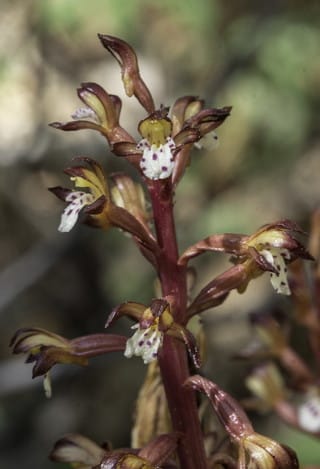 Photo: Craig Martin | Summer Coralroot, Spotted Coralroot, Spotted Coral RootCOMA25 (Corallorhiza maculata)Family: Orchidaceae (Orchids) Size: 8 - 20 in (20 - 51 cm) Growth: forb/herb; perennial Blooms: Jun 16 - Jul 19 Flower: simple; variable color, typically reddish to purple; 3 sepals and 2 slightly curved lateral petals; white lip often with reddish-purple spots Leaf: monocot; small and grow regularly all around stem Fruit: ellipsoid capsules that hand down Status: native; uncommon Habitat: mixed conifer --- montane woodlands Typically the stalks of this orchid are red but occasional albino plant with yellow stems are seen. It gets its name from the fact that the rhizome and lower stem are often knotted in such a way as to be reminiscent of coral. This plant is myco-heterotropic, meaning that it primarily does not use photosynthesis to get energy but rather obtains its nutrients by parasitizing the mycelium of certain fungi. It is capable of self-pollination but can be pollinated by insects. Info Photos Distribution |
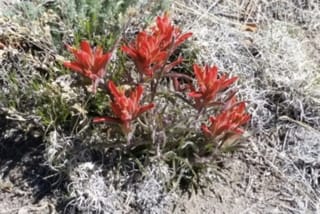 Photo: Craig Martin 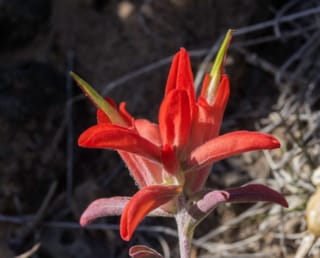 Photo: Craig Martin | Wholeleaf Indian Paintbrush, Squawfleather, Southwestern Indian Paintbrush, Cola de BorrejoCAIN14 (Castilleja integra)Family: Orobanchaceae (Broomrapes) Size: up to 16 in (41 cm) Growth: forb/herb, subshrub; perennial Blooms: Apr 18 - Oct 20 Flower: simple; Red or orange specialized leaves or bracts form on spikes; flowers are a small green tubes protruding above the bracts Leaf: dicot; Narrow, unlobed, undivided; tinges of light purple on some Fruit: capsule filled with numerous seed Status: native; common Habitat: pinyon-juniper --- foothills, montane, shrublands, woodlands Typical location: Canyon Rim Trail paved section, Quemazon Trail The common name "wholeleaf" refers to the lack of lobes on the leaves and bracts. The plant’s roots will grow and penetrate those of other plants in order to obtain nutrients. The stems of the plant have white hairs. The Zuni used to mix the roots with minerals to make a black dye. Info Photos Distribution |
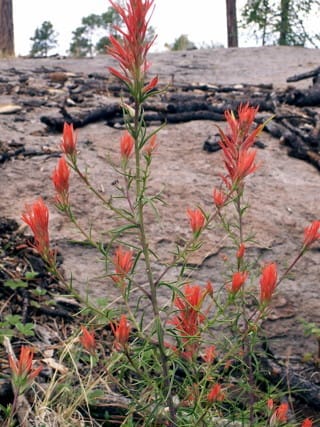 Photo: Chick Keller 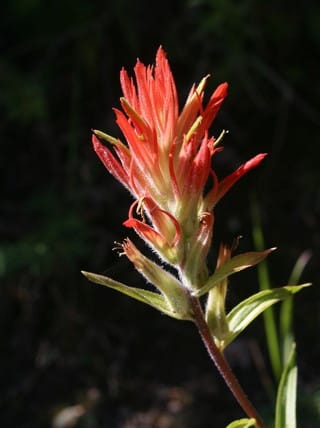 Photo: Terry Foxx | Wyoming Indian Paintbrush, Wyoming PaintbrushCALI4 (Castilleja linariifolia)Family: Orobanchaceae (Broomrapes) Size: up to 40 in (102 cm) Growth: forb/herb, subshrub; perennial Blooms: Jun 26 - Oct 20 Flower: simple; red bracts cut deeply on one side; yellow-green flower tubes, often hidden except for the tip; torch-like spikes Leaf: dicot; narrow and unlobed; edges folded upward Fruit: ovoid capsule with many tiny seeds Status: native; uncommon Habitat: ponderosa --- foothills, montane, shrublands, woodlands Typical location: Middle Quemazon Trail on north side This species of paintbrush is distinguished from other paintbrushes by preferring a lower elevation and having narrower leaves. It is the state flower of Wyoming and grows across most of the west. Its roots grow until they touch the roots of other plants. Then the paintbrush’s roots will penetrate the roots of the other plants, taking nutrients from the host plant. Info Photos Distribution |
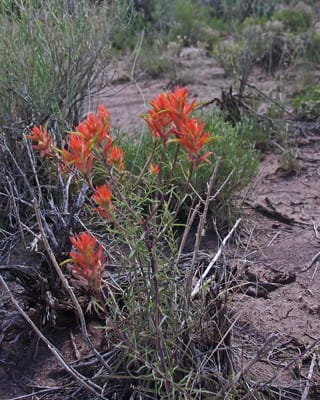 Photo: PEEC 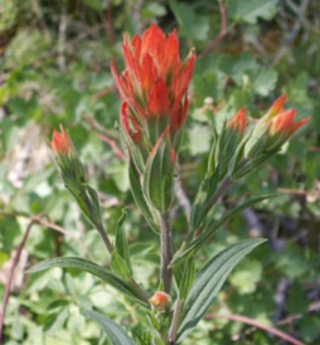 Photo: Chick Keller 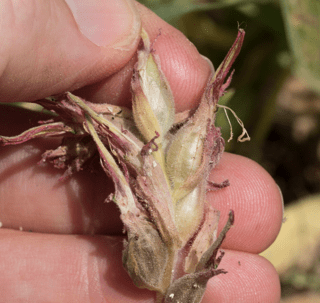 Photo: twr61 | Giant Red Indian Paintbrush, Scarlet Indian Paintbrush, Meadow PaintbrushCAMI12 (Castilleja miniata)Family: Orobanchaceae (Broomrapes) Size: up to 20 in (51 cm) Growth: forb/herb, subshrub; perennial Blooms: Jun 26 - Oct 20 Flower: simple; green with red bracts; large red structures along the top part of the tall stems are modified leaves; flower is small tubes at the top Leaf: dicot; fairly wide; pointed; 3 veins Fruit: oblong capsule with numerous seeds; splits lengthwise to expose seeds Status: native; common Habitat: mixed conifer --- montane, subalpine, meadows Typical location: Canada Bonita Trail The plant is one of the most common species of this large genus. The plant is usually unbranched and the upper red bracts are often cut into three segments. Though the upper bracts are mostly red, they can be seen in pink or orange. Info Photos Distribution |
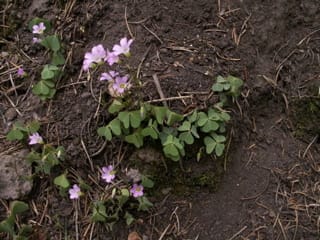 Photo: Chick Keller 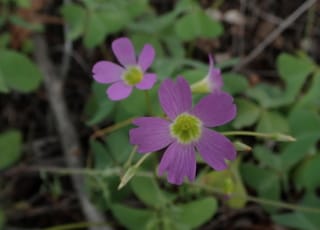 Photo: Donna Pomeroy | Alpine WoodsorrelOXAL2 (Oxalis alpina)Family: Oxalidaceae (Wood Sorrels) Size: up to 8 in (20 cm) Growth: forb/herb; perennial Blooms: Jul 14 - Sep 22 Flower: simple; pink or purple; 5 petals; narrow stalklike base Leaf: dicot; 3 palmate leaflets that droop at night or in the cold Fruit: ellipsoid capsules Status: native; uncommon Habitat: mixed conifer --- rocky places in deciduous, pine-oak, or coniferous forests Typical location: Canada Bonita Trail The plant grows from a bulb-like tuber. Typically found at higher elevations. Contains oxalic acid in the leaves and stems. Info Photos Distribution |
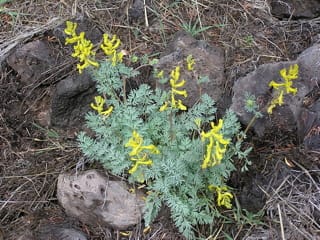 Photo: Rebecca Shankland 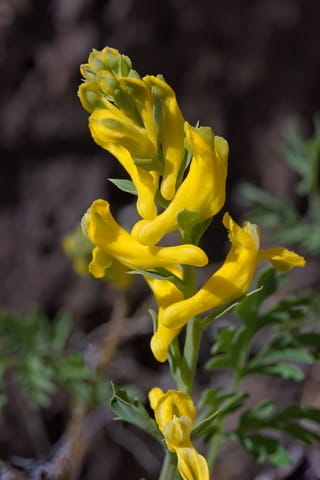 Photo: Craig Martin 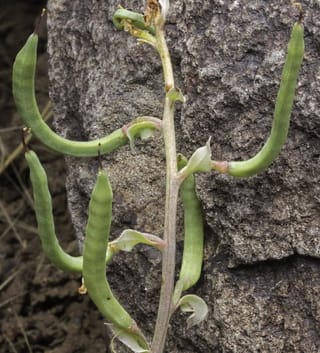 Photo: Craig Martin | Scrambled Eggs, Golden Smoke, Golden CorydalisCOAU2 (Corydalis aurea)Family: Papaveraceae (Poppies) Size: up to 18 in (46 cm) Growth: forb/herb; annual, biennial Blooms: Apr 01 - Aug 18 Flower: simple; yellow; spur at the back of each flower; form tightly packed clusters with up to 30 flowers Leaf: dicot; blue-green leaves divided into leaflets with oval or diamond lobes Fruit: cylindrical capsules; curve upward Status: native; common Habitat: mixed conifer, pinyon-juniper, ponderosa --- montane, subalpine, woodlands Typical location: Valle Canyon Often mistaken for a pea rather than a poppy. The stems are weak and are often supported by vegetation or rocks. Info Photos Distribution |
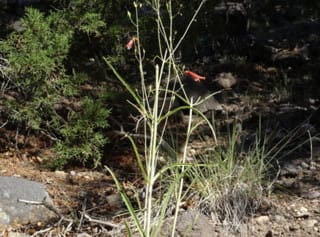 Photo: Russell Pfau 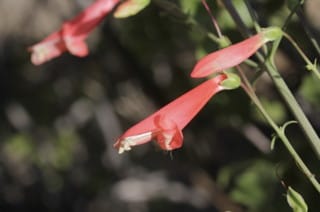 Photo: Nathan Taylor | Beardlip Penstemon, Red Beardtongue, Scarlet BuglerPEBA2 (Penstemon barbatus)Family: Plantaginaceae (Speedwells) Size: 24 - 36 in (61 - 91 cm) Growth: forb/herb; perennial Blooms: Jun 08 - Oct 31 Flower: simple; red; tubular flowers with two lips; lower lip divided into 3 lobes and bent backwards; flowers dropped slightly; arranged in pairs Leaf: dicot; slender, long linear to oval; less frequent on the upper stems Fruit: capsules that split open longitudinally to release several brown seeds Status: native; common Habitat: ponderosa --- open, rocky soil in mixed conifer forests Typical location: Dot Grant Trail Penstemon barbatus is one of the few red flowered penstemons. It gets its species name from ‘barbatus’ meaning bearded which is an allusion to the hairs into the throat of the flower. The leaves and stems may have a pale whitish covering. The plant has been used ceremonially, as a decoration, and for treatment of a variety of issues. Info Photos Distribution |
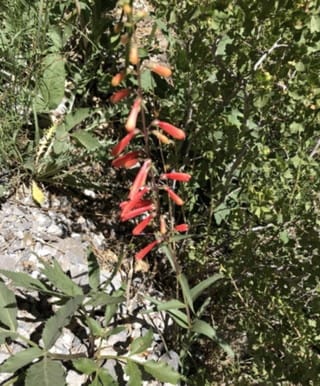 Photo: Lonny Holmes 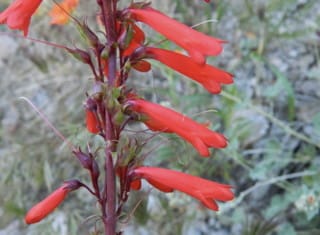 Photo: M Hays | Firecracker Penstemon, Eaton's Penstemom, Eaton's FirecrackerPEEA (Penstemon eatonii)Family: Plantaginaceae (Speedwells) Size: 15 - 39 in (38 - 99 cm) Growth: forb/herb; perennial Blooms: Apr 30 - Jun 30 Flower: simple; red; showy tubular flowers that do not spread much at the mouth; 2-lipped; flowers grow along spikes Leaf: dicot; thick, smooth and without teeth; basal leaves are oval; stalk leaves are lance-shaped; Fruit: greenish capsule Status: native; common Habitat: scrub, pinyon/juniper woodland, pine forest Firecracker Penstemons are most commonly seen in opening between Pinyon Pines. It thrives in drought conditions and high heat. The flowers are a rich source of nectar and therefore attract numerous hummingbirds. The birds will often defend a territory over a patch of these plants. Info Photos Distribution |
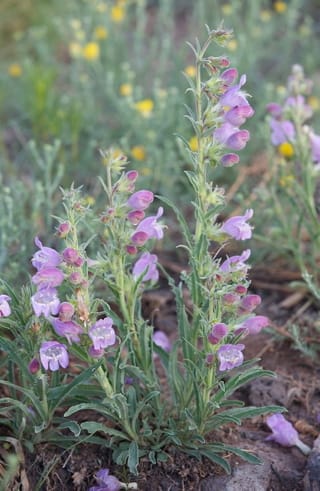 Photo: Stephen Shankland 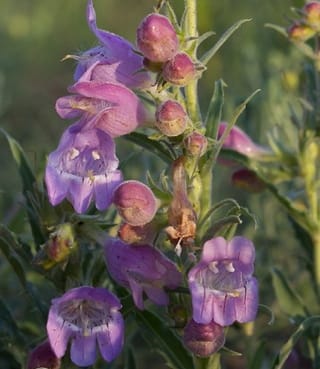 Photo: Stephen Shankland | James' Penstemon, James' BeardtonguePEJA (Penstemon jamesii)Family: Plantaginaceae (Speedwells) Size: 4 - 20 in (10 - 51 cm) Growth: forb/herb, subshrub; perennial Blooms: May 20 - Jun 18 Flower: simple; pink to purple; growing down one side of the stem; broad throat with prominent streaks Leaf: dicot; bluish-green; lance-shaped; may have toothed edges Fruit: brown capsule that split open to reveal black seeds Status: native; uncommon Habitat: pinyon-juniper, ponderosa --- mesas, limestone hills, pinyon-juniper and ponderosa pine forests Typical location: White Rock This plant is very drought tolerant and can be propagated by seed or by cuttings taken in early summer. It attracts bees. Info Photos Distribution |
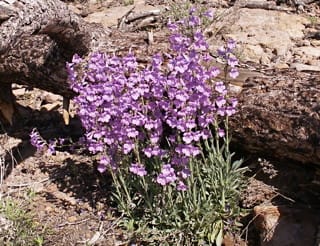 Photo: Chick Keller 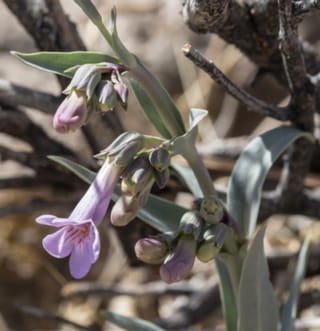 Photo: Craig Martin | Sidebells Penstemon, One-sided Penstemon, Sidebells BeardtonguePESE11 (Penstemon secundiflorus)Family: Plantaginaceae (Speedwells) Size: 12 - 18 in (30 - 46 cm) Growth: forb/herb; perennial Blooms: May 04 - Jun 18 Flower: simple; pink to purple with white throat; occasionally all white; lower lip bearded; long spikes of flowers located on one side of stem. Leaf: dicot; blue-green; lance-shaped; hairless Fruit: oval capsule Status: native; locally common Habitat: mixed conifer --- plains, foothills, montane Typical location: Quemazon Trail The plant is distinguished by a rosette of leaves at its base and erect leaves on the stem. Hummingbirds are attracted to the flowers. Info Photos Distribution |
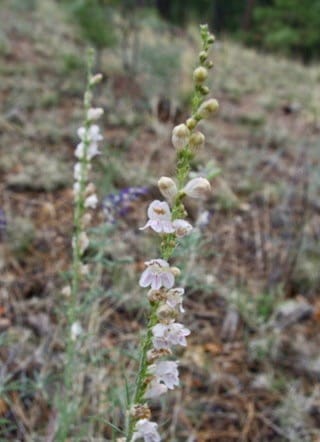 Photo: Jerry Friedman 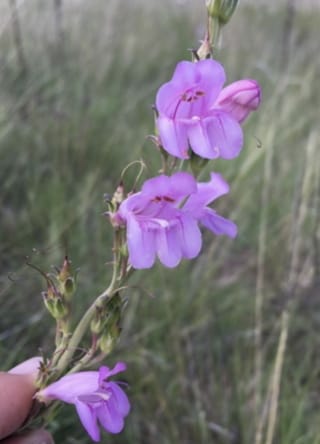 Photo: Patrick Alexander | Upright Blue Beardtongue, Upright Blue Penstemon, Wandbloom PenstemonPEVI4 (Penstemon virgatus)Family: Plantaginaceae (Speedwells) Size: 8 - 24 in (20 - 61 cm) Growth: forb/herb; perennial Blooms: Jun 01 - Jul 31 Flower: simple; purple and/or white; 5-lobed corolla; throat streaked with dark purple guidelines Leaf: dicot; thin and long; occasionally bent upwards on either side Fruit: capsules that release short, dark brown seeds when split open Status: native; locally common Habitat: ponderosa --- pine forests, mountain meadows Typical location: Dot Grant Trail, Guaje Pines Cemetery Upright Blue Beardtongue is exclusively found in the wild at elevations above 5,000 ft (1,500 m). Its genus comes from “peane” (Latin) and “stamen” (Greek), meaning almost thread and alluding to the single sterile stamen in each flower. The roots have been used ceremonially by Navajo. The plant is of special value to native bees. Info Photos Distribution |
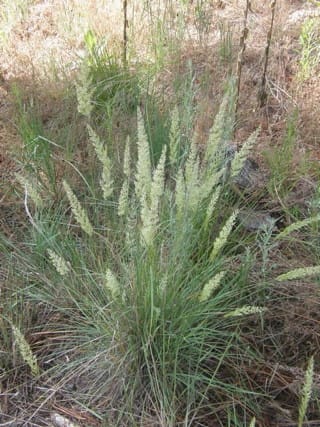 Photo: Chick Keller 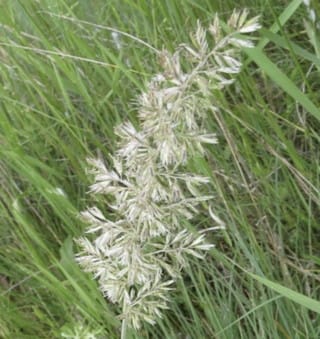 Photo: Howard Bruner 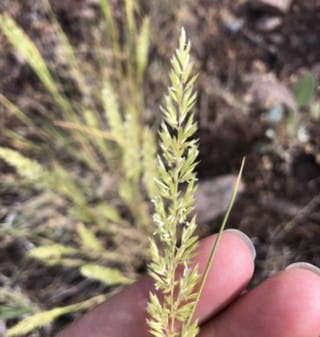 Photo: JD McCoy | June Grass, Prairie Junegrass, Prairie Koeler's GrassKOMA (Koeleria macrantha)Family: Poaceae (Grasses) Size: up to 24 in (61 cm) Growth: graminoid; perennial Blooms: Jul 02 - Aug 18 Flower: simple; light green to silver-green as matures; long tapered, spike-like inflorescence rising above the basal foliage Leaf: dicot; grayish-blue; flat but may be slightly rolled inward; usually hairless; alternate arrangement Fruit: silver-gray seed heads; slightly flattened, ellipsoid grains that are light colored Status: native; common Habitat: ponderosa --- prairie, fields, open areas June Grass is a cool season, tufted, perennial bunch grass. It usually does not form dense colonies but rather grows clusters. It is one of the most noticeable plants in the area due to the sunlight streaming through these fronds makes this one of the most noticeable plants in the woods. Although it is a good food source for many grazing animals. It is also a food plant for many species of grasshopper. However, it is a severe allergen for humans who are sensitive to grasses. It is used as a low-maintenance lawn and turf grass, used in the roughs at some golf courses. Info Photos Distribution |
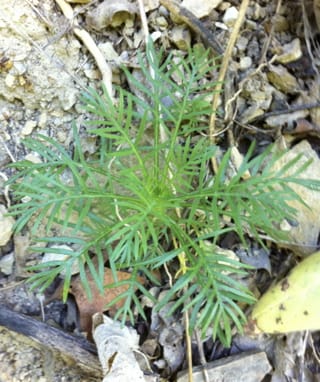 Photo: scottmo 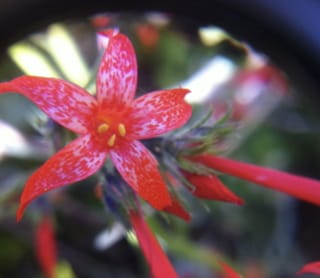 Photo: scottmo 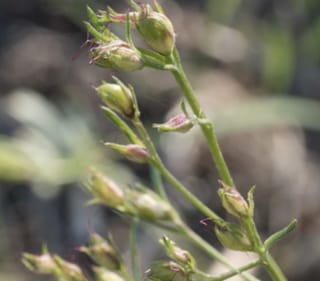 Photo: twr61 | Scarlet Gilia, Skyrocket Gilia, SkunkflowerIPAG (Ipomopsis aggregata)Family: Polemoniaceae (Phlox) Size: up to 12 in (30 cm) Growth: forb/herb; biennial, perennial Blooms: Jun 27 - Oct 31 Flower: simple; red; long, trumpet-shaped and thin; corolla opens out with 5 pinted lobes, forming a star shape Leaf: dicot; silver with fine hairs; deeply lobed and concentrated around the base Fruit: capsules with 5 to 10 sees per locule Status: native; common Habitat: ponderosa --- semi-desert, foothills, montane, woodlands, meadows, openings Typical location: Valle Canyon Pronounced “JILL-ee-uh”. Occurs at a range of elevations. It is pollinated most commonly by long-tongued moths and hummingbirds. Its common name of “skyrocket” relates to the fact that the lobes of the flowers curve back as if blown by rocketing through the air. Info Photos Distribution |
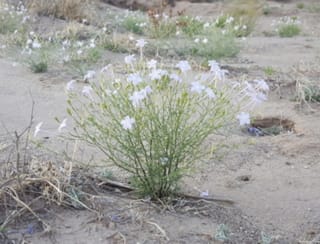 Photo: Alex Abair 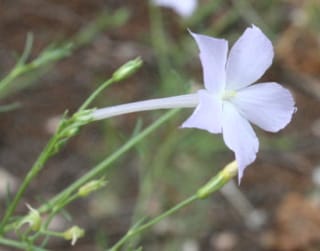 Photo: Akkana Peck 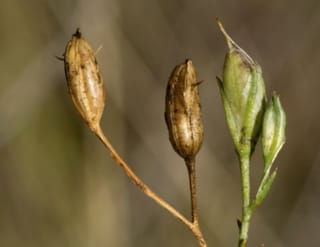 Photo: Patrick Alexander | Flaxflowered Ipomopsis, Flaxflowered GiliaIPLO2 (Ipomopsis longiflora)Family: Polemoniaceae (Phlox) Size: 10 - 40 in (25 - 102 cm) Growth: forb/herb; annual, biennial Blooms: Jul 15 - Nov 15 Flower: simple; blue, purple, and/or white; long, slender corolla tube with 5 petals each ending in a point Leaf: dicot; grow at intervals along the branches; finely divided; covered with very short hairs Fruit: oval capsules with multiple seeds Status: native; common Habitat: pinyon-juniper --- dry plains, mesas Typical location: Water Canyon Moths are attracted to the flowers at night. When not in flower The plant is often difficult to identify when not in flower as its whisky stems and leaves merge with the grass and other undergrowth. Info Photos Distribution |
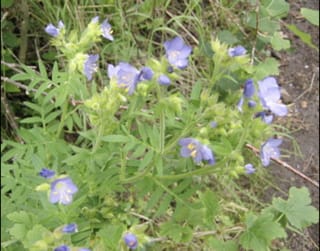 Photo: Corry Clinton  Photo: Chick Keller | Jacob's Ladder, Leafy Polemonium, Towering Jacob's LadderPOFO (Polemonium foliosissimum)Family: Polemoniaceae (Phlox) Size: up to 6 in (15 cm) Growth: forb/herb; perennial Blooms: Jul 02 - Aug 27 Flower: simple; blue/purple with white stamens and styles; bell-shaped and divided into 5 segments; clusters at the top Leaf: dicot; pinnately compound leaves at the base and at intervals further up; slightly hairy Fruit: small capsule with 3 to 5 seeds per cavity Status: native; uncommon Habitat: mixed conifer --- montane, subalpine, meadows The plant can often be found in colonies in mountain meadows. It has an overall open, airy look to it. Its genus name, foliosissum is Greek for “very leafy”. Like other species in the Polemonium genus, it is used as a food plant by the larvae of some butterfly species. In addition, the plant will exude a strong, skunk-like odor when touched. Info Photos Distribution |
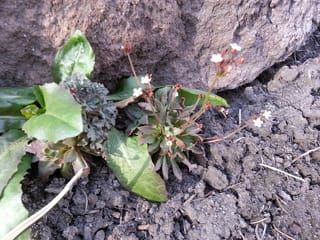 Photo: Craig Martin 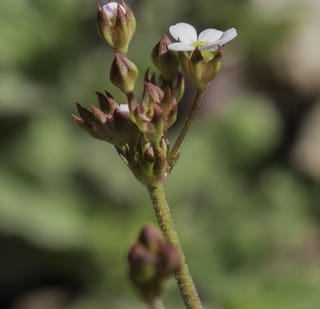 Photo: Craig Martin 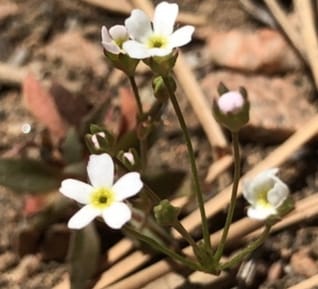 Photo: Christina M. Selby | Pygmyflower Rockjasmine, Rock Jasmine, RockJasmine, Northern Fairy CandelabraANSE4 (Androsace septentrionalis)Family: Primulaceae (Primroses) Size: 6 - 10 in (15 - 25 cm) Growth: forb/herb; annual, perennial Blooms: Mar 19 - Sep 01 Flower: simple; white with yellow center; enclosed by a green or reddish calyx; 5 petals Leaf: dicot; simple leaves formed in a rosette Fruit: small, smooth, round capsule containing about 20 seeds Status: native; common Habitat: mixed conifer, ponderosa --- foothills, montane, subalpine, meadows, open woods Tiny plant often obscured by others. It turns shades of red shortly after finishing blooming. Can be found up to 11,000 ft (3,400 m). Info Photos Distribution |
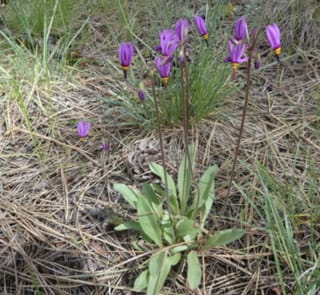 Photo: John D Reynolds 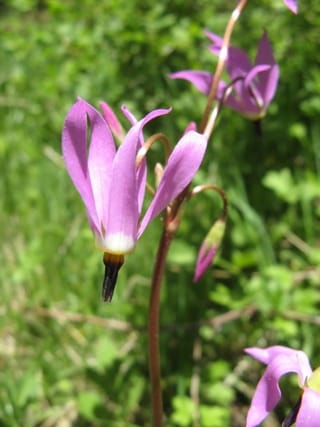 Photo: Janie O'Rourke 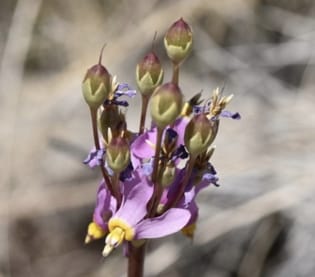 Photo: Johnny Holmes | Darkthroat Shootingstar, Shooting StarDOPU (Dodecatheon pulchellum)Family: Primulaceae (Primroses) Size: 6 - 20 in (15 - 51 cm) Growth: forb/herb; perennial Blooms: Jun 15 - Aug 02 Flower: simple; purple with white and yellow near base; flares back behind the corolla; arranged on long stems usually hanging downward Leaf: dicot; oval-shaped, hairless capsules with many seeds Fruit: The plant has a distinctive flower with a magenta, white and yellow corolla that flares back behind the stamen Status: native; rare Habitat: riparian --- montane, streamsides, wetlands Typical location: Upper Frijoles Canyon The Darkthroat Shootingstar has a rather exotic looking flower. During the height of the flowering season, each plant will have many flowers will open at the same time and there may be potential hundreds of plants in a single area. Infusions of the the roots and leaves have been used for the treatment of sore eyes. Info Photos Distribution |
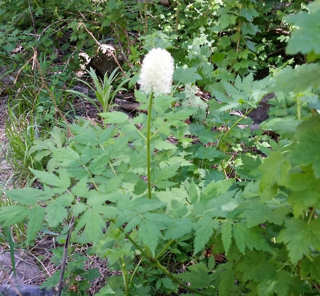 Photo: Craig Martin 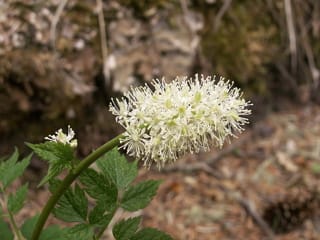 Photo: Chick Keller 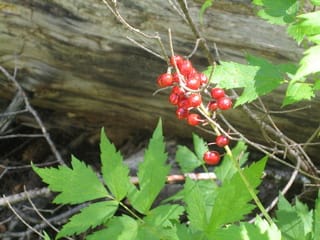 Photo: Corrie Clinton | Red Baneberry, SnakeberryACRU2 (Actaea rubra)Family: Ranunculaceae (Buttercups) Size: up to 36 in (91 cm) Growth: forb/herb; perennial Blooms: May 24 - Jun 30 Flower: simple; small and white; occur in dense, globular clusters Leaf: dicot; large, highly divided leaves; deeply saw-toothed Fruit: bright, red round berries Status: native; common Habitat: mixed conifer --- rich, moist, deciduous and coniferous woods, thickets Typical location: Valle Canyon Large bushy plant. Berries are poisonous to humans but not to birds. Info Photos Distribution |
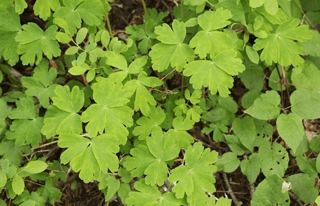 Photo: Dan Nydick 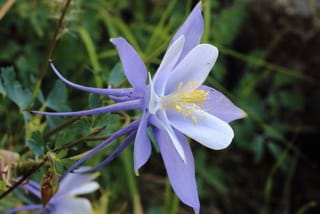 Photo: Craig Martin | Colorado Blue Columbine, Rocky Mountain ColumbineAQCO (Aquilegia coerulea)Family: Ranunculaceae (Buttercups) Size: 12 - 24 in (30 - 61 cm) Growth: forb/herb; perennial Blooms: Jun 23 - Oct 31 Flower: simple; usually purplish blue and white; sometime pure white; large, upright, and having long spurs; 5 petals Leaf: dicot; light green; deeply cut Fruit: green follicles; several united at the base with top spread apart Status: native; rare Habitat: mixed conifer --- alpine, subalpine, montane, meadows, woodlands, rocks Typical location: Ski Hill Found at elevations of 6,900 to 12,100 ft (2,100 to 3,700 m). The long flower spurs contain nectar that are only accessible by hawkmoths. Info Photos Distribution |
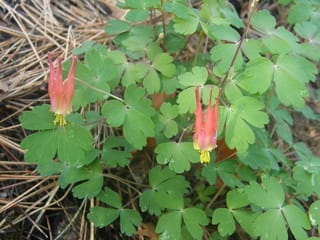 Photo: Yvonne Keller 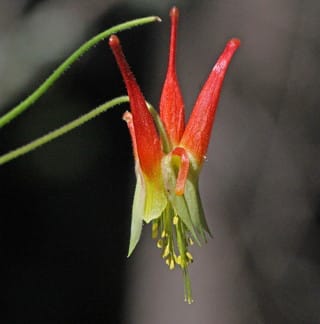 Photo: Jerry Oldenettel | Western Red Columbine, Rocky Mountain Red ColumbineAQEL (Aquilegia elegantula)Family: Ranunculaceae (Buttercups) Size: 6 - 12 in (15 - 30 cm) Growth: forb/herb; perennial Blooms: May 07 - Jul 14 Flower: simple; red and yellow; 5 long petals ending in spurs; often drooping Leaf: dicot; divided into three leaflets on long, slender stems Fruit: follicles with long, slender beaks Status: native; common Habitat: mixed conifer --- limestone outcroppings and ledges This plant can be seen at high elevations on rocky slopes. The red flowers attract hummingbirds. Info Photos Distribution |
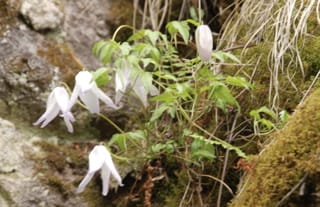 Photo: Damian Tighe 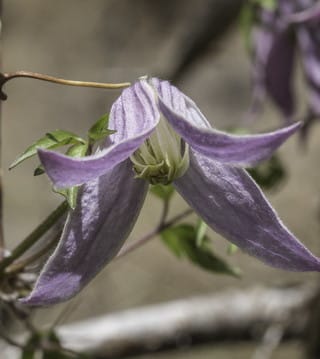 Photo: Craig Martin 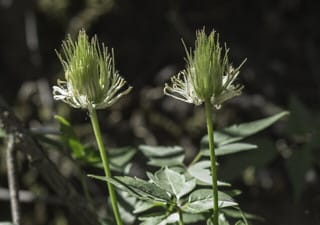 Photo: Craig Martin | Rock Clematis, Spring ClematisCLCO2 (Clematis columbiana)Family: Ranunculaceae (Buttercups) Size: 5 - 7 in (13 - 18 cm) Growth: vine; perennial Blooms: Apr 05 - May 22 Flower: simple; purple to white; hairy with prominent veins and pointed sepals; flowers often point downward Leaf: dicot; oval to heart-shaped; trifolate Fruit: plumed seed heads Status: native; uncommon Habitat: mixed conifer, ponderosa --- foothills, montane, woodlands Typical location: Pajarito Trail This is a spring-blooming vine that is usually not noticeable from the trail, preferring deep forest shade. The stems climb along the ground and up over low bushes and tree trunks. Info Photos Distribution |
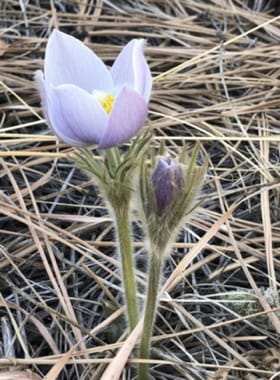 Photo: Christina M. Selby 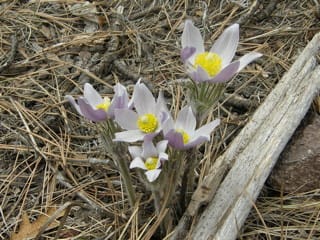 Photo: Chick Keller 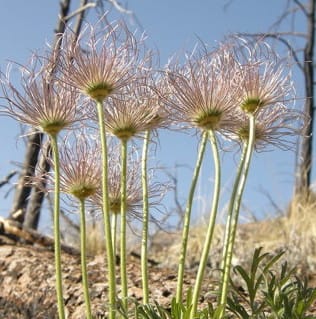 Photo: Chick Keller | Eastern Pasqueflower, American PasqueflowerPUPA5 (Pulsatilla patens, Anemone patens)Family: Ranunculaceae (Buttercups) Size: 3 - 18 in (8 - 46 cm) Growth: forb/herb; perennial Blooms: Mar 16 - Jun 19 Flower: simple; blue, purple and/or white; single cup-shaped flower on each stalk; 6 petals Leaf: dicot; deeply cut basal leaves; 3 unstalked leaves with linear segments surround each flower Fruit: feathery, silky fruiting head Status: native; common Habitat: ponderosa --- dry, open, and rocky low to high montane forests and meadows Typical location: Pajarito Trail, Perimeter Trail, Rendija Canyon Plants often occur in large colonies. They elongate as they mature. Although the plant was used by Native Americans as a medicine it is highly toxic. Info Photos Distribution |
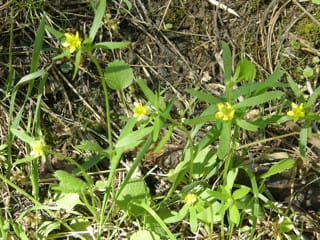 Photo: Chick Keller 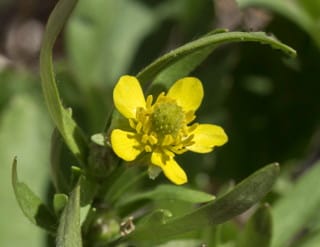 Photo: Craig Martin 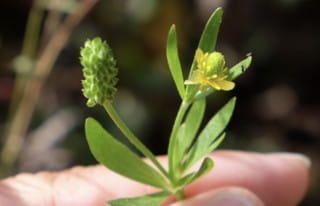 Photo: faerthen | Graceful Buttercup, Plain ButtercupRAIN (Ranunculus inamoenus)Family: Ranunculaceae (Buttercups) Size: up to 12 in (30 cm) Growth: forb/herb; perennial Blooms: May 09 - Aug 27 Flower: simple; yellow; 5 petals; yellow stamens surrounding by greenish pistils; 3 to 7 flowers on a stem Leaf: dicot; ovate with 3 lobes; potential notch on the outer pair Fruit: long cylindrical heads with multiple one-seeded bumps; short hairs; tiny beak Status: native; uncommon Habitat: mixed conifer --- montane, subalpine, woodlands, meadows Typical location: Water Canyon This is a small, inconspicuous, and dainty plant with a species name that means "not attractive" or "drab". The plant is only indirectly pollinated by bees. The bees leave a large amount of pollen on the petals which is then washed down onto the stigmas by dew and rain. Info Photos Distribution |
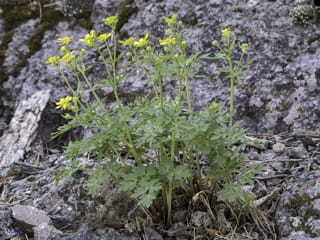 Photo: Craig Martin 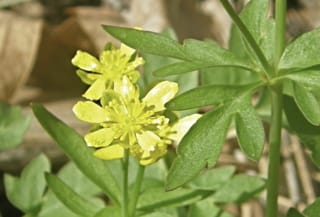 Photo: Chick Keller | Tadpole Buttercup, Los Alamos ButtercupRARA (Ranunculus ranunculinus)Family: Ranunculaceae (Buttercups) Size: 3 - 6 in (8 - 15 cm) Growth: forb/herb; perennial Blooms: Apr 21 - Jun 01 Flower: simple; yellow; starlike; 5 or 6 petals; sepals spreading from the base Leaf: dicot; basal leaves oval to semi-circular; leaflets lobed with smooth margins Fruit: heads of small or one-seeded fruits (achenes) Status: native; locally common Habitat: ponderosa --- montane, open rocky slopes, sage Typical location: Los Alamos Common on north-facing canyon slopes in restricted areas in a few states. Appears soon after snow-melt. Info Photos Distribution |
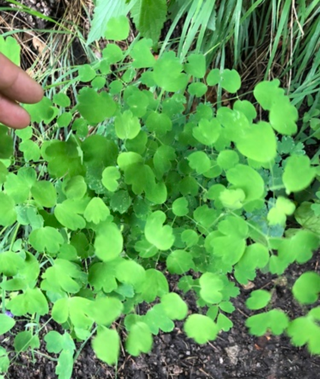 Photo: Christina M. Selby 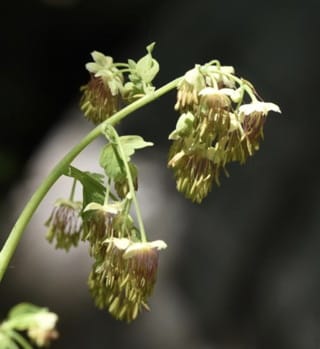 Photo: male flower by Lonny Holmes 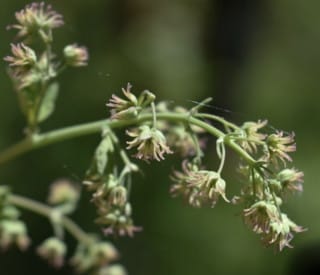 Photo: female flower by Gail | Fendler's Meadow Rue , MeadowrueTHFE (Thalictrum fendleri)Family: Ranunculaceae (Buttercups) Size: 36 - 72 in (91 - 183 cm) Growth: forb/herb; perennial Blooms: Jun 11 - Aug 02 Flower: simple; separate male and female flowers; tassel-like stamens without petals in green to yellow (male), spiky flowers becoming pink as they mature (female); arching branched cluster of flowers Leaf: dicot; compound blades divided into segments of varying shapes, often with 3 lobes Fruit: female flowers have clusters of immature fruits that develop into hard, black stubs Status: native; common Habitat: mixed conifer --- foothills, montane, subalpine, woodlands, meadows Typical location: Canada Bonita Trail Fendler's Meadow Rue is very delicate and often overlooked. The stems are hairless and green to purple in color. The leaves unfold in swirls from a small globe. The male and female flowers of the plant are usually located on separate plants. The flowers are pollinated by wind. Info Photos Distribution |
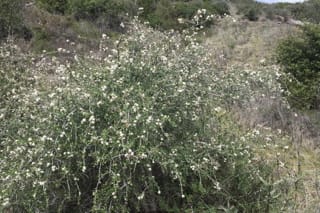 Photo: 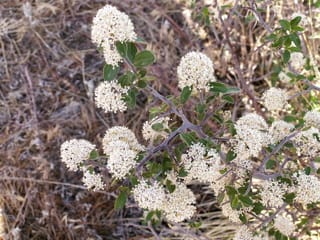 Photo: Chick Keller 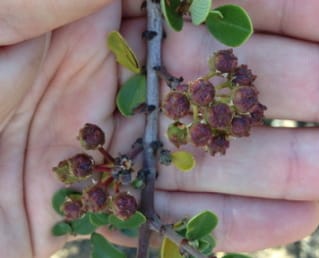 Photo: Ken -ichi Ueda | Fendler's Ceanothus, Buckbrush, Fendler's WhitethornCEFE (Ceanothus fendleri)Family: Rhamnaceae (Buckthorns) Size: up to 36 in (91 cm) Growth: shrub; perennial Blooms: May 19 - Jul 17 Flower: simple; white; form clusters at the end of the stems; all flowers bloom at once Leaf: dicot; narrow dark green leaves; alternate arrangement Fruit: three-celled capsules; pink and glossy; forming a rounded triangle Status: native; common Habitat: ponderosa --- open coniferous forest Thorny shrub that can be either upright or low and sprawling. There are usually several plants found together in the same place. Info Photos Distribution |
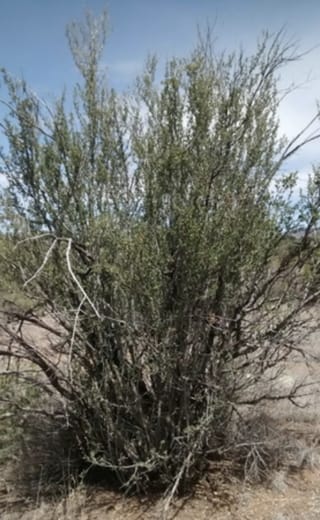 Photo: Jess Demoss 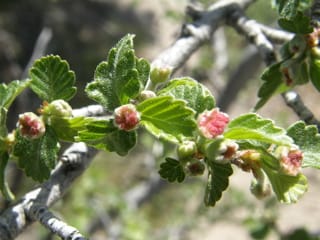 Photo: Chick Keller 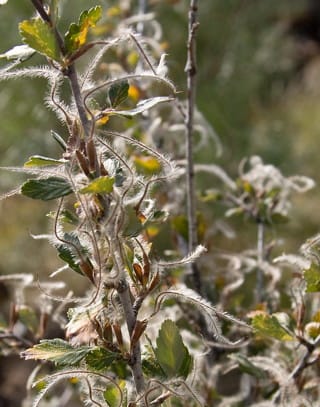 Photo: Mary Carol Williams | Alderleaf Mountain Mahogany, Silverleaf, Mountain MahoganyCEMO2 (Cercocarpus montanus)Family: Rosaceae (Roses) Size: 78 - 156 in (198 - 396 cm) Growth: shrub, tree; perennial Blooms: Apr 15 - May 19 Flower: simple; red and yellow; non-showy; trumpet-shaped Leaf: dicot; leaves almost evergreen in nature; dark on top and fuzzy on the bottom Fruit: feathery, silvery-white fruits Status: native; common Habitat: pinyon-juniper --- rocky hillsides, cliffs, open woods, mesas The plant fixes nitrogen and is good for revegetation and erosion control. The foliage is a favorite of deer. In the wild, the plant generally remains as a shrub and does not obtain a tree-like form. Info Photos Distribution Tree Guide |
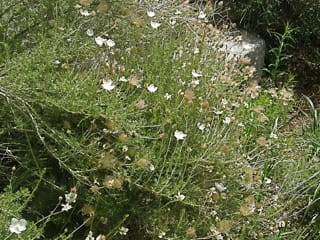 Photo: Chick Keller 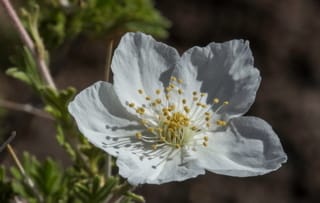 Photo: Craig Martin 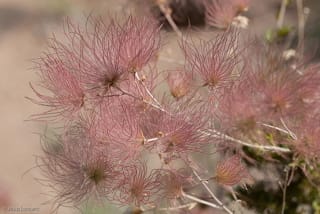 Photo: Josip Loncaric | Apache Plume, PonilFAPA (Fallugia paradoxa)Family: Rosaceae (Roses) Size: 24 - 72 in (61 - 183 cm) Growth: shrub; perennial Blooms: Jun 06 - Oct 31 Flower: simple; white flowers on the tips of very dense, intertangle branches; 5 petals Leaf: dicot; dark green with silver underneath Fruit: persistent, pink, feathery plumes said to resemble an Apache headdress Status: native; common Habitat: pinyon-juniper, ponderosa --- dry, rocky slopes, open woods, dry washes This multi-branched shrub is deciduous to semi-evergreen with a slender and upright habit. Info Photos Distribution |
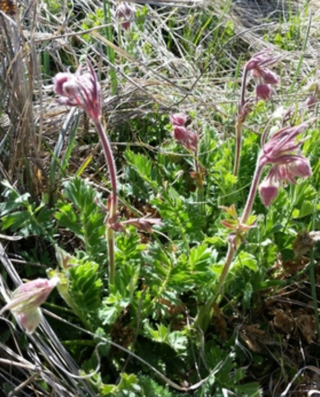 Photo: Craig Martin 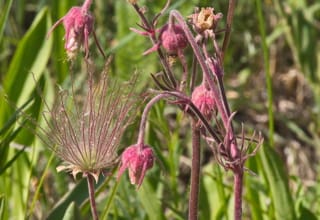 Photo: Craig Martin 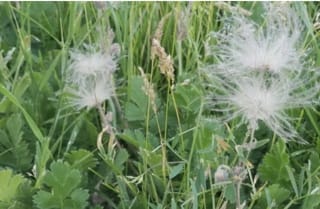 Photo: morel hunter | Old Man's Whiskers, Prairie Smoke, Purple AvensGETR (Geum triflorum)Family: Rosaceae (Roses) Size: 6 - 15 in (15 - 38 cm) Growth: forb/herb; perennial Blooms: May 24 - Jul 03 Flower: simple; white petals with pink and mostly covered with pink sepals; arranged in clusters of 3 to 5 flowers; nod downwards and mostly closed and bud-like Leaf: dicot; divided leaves with 7 to 17 primary leaflets; may have secondary leaflets in between Fruit: feathery seed pods Status: native; uncommon Habitat: montane --- subalpine, meadows Typical location: Canada Bonita Old Man's Whiskers is semi-evergreen with some of the basal leaves turning purplish and remaining over winter. The flowers attract bees with both nectar and pollen, the later is dislodged by using a sound technique known as buzz-pollinating. Info Photos Distribution |
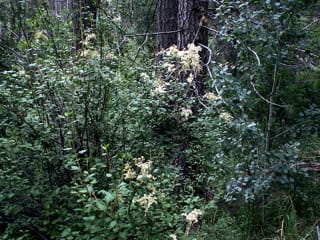 Photo: Chick Keller 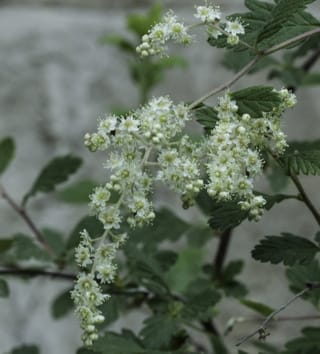 Photo: Craig Martin | Rockspiraea, Mountain Spray, Glandular OceansprayHODU (Holodiscus dumosus, Holodiscus discolor)Family: Rosaceae (Roses) Size: 2 - 8 in (5 - 20 cm) Growth: shrub; perennial Blooms: Aug 01 - Sep 10 Flower: simple; pink to white; multi-branched, feathery cluster of small blooms Leaf: dicot; dark green; lobes along top edge; occurring mainly on spur branches Fruit: tiny, dry capsules each bearing 1 seed Status: native; uncommon Habitat: mixed conifer --- dry, rocky cliffs and hillsides in ashy soil Typical location: Valle Canyon This intricately branched, spreading shrub has reddish twigs and aromatic, deciduous foliage. The branches originate from the root crown and spread outward. Info Photos Distribution |
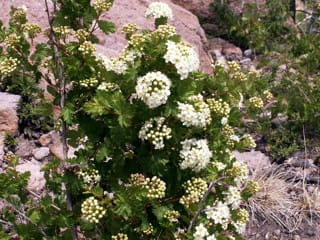 Photo: Chick Keller 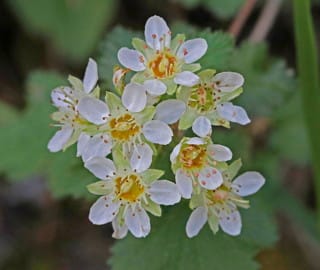 Photo: Jerry Oldenettel 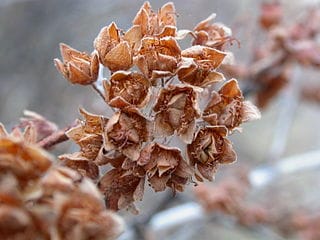 Photo: Matt Lavin | Mountain NinebarkPHMO4 (Physocarpus monogynus)Family: Rosaceae (Roses) Size: 72 - 84 in (183 - 213 cm) Growth: shrub; perennial Blooms: May 19 - Jul 17 Flower: simple; white tinged with pink; 5 petals arranged in a cup-like structure; overall appear in rounded clusters Leaf: dicot; simple, palmately lobed; alternate arrangement; turn red in the fall Fruit: pointed follicles arranged in upright hemispherical clusters; initially red and then turning reddish brown Status: native; common Habitat: mixed conifer, ponderosa --- rocky, dry hillsides Typical location: Rendija Canyon Plants in the genus Phtsocarpus are known as “ninebark” due to its distinguishing feature of ragged peeling bark revealing several layers and colors. Mountain Ninebark is found at elevations between 5,500 and 10,000 ft (1,700 and 3,000 m). The roots have been used by Native Americans in a pain-relieving poultice, while the twigs are food for wildlife. Info Photos Distribution |
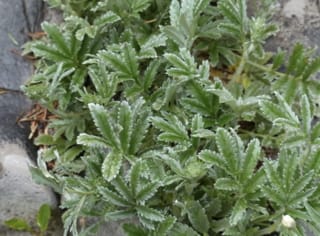 Photo: 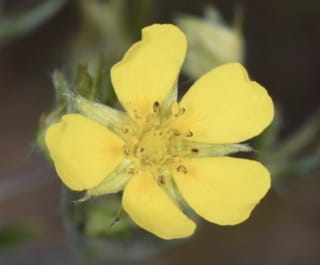 Photo: Don Loarie | Woolly CinquefoilPOHI6 (Potentilla hippiana)Family: Rosaceae (Roses) Size: 2 - 20 in (5 - 51 cm) Growth: forb/herb; perennial Blooms: Jun 13 - Sep 10 Flower: simple; yellow; 5 non-overlapping petals departed by hairy sepals; borne in small clusters Leaf: dicot; green one top and silvery on bottom; toothed edge; hairy; folds up at edges; multiple leaflets with single terminal Fruit: many tiny greenish yellow capsules Status: native; common Habitat: mixed conifer, ponderosa --- montane, meadows, woodlands Typical location: Water Canyon Woolly Cinquefoil grows from about 4,300 ft (1,220 m) to as high as 12,000 ft (3,660 m). It grows quickly in disturbed sites and in warms areas. It has high seed production potential. The genus name of Pontentilla means “powerful” related to the plant’s medical uses for expediting childbirth and soothing burns and sores. Info Photos Distribution |
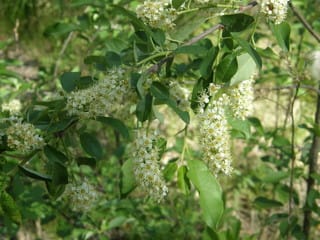 Photo: Chick Keller 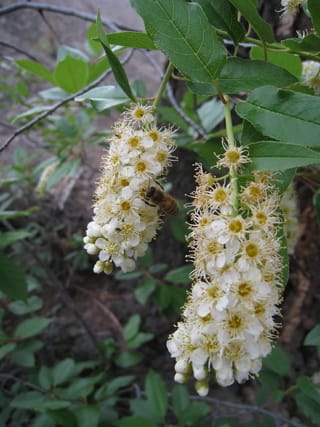 Photo: Jennifer Macke 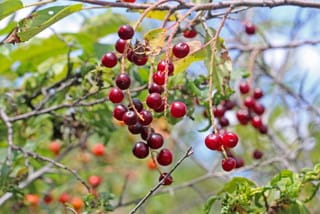 Photo: Jerry Oldenettel | Chokecherry, Bitterberry, Western ChokecherryPRVI (Prunus virginiana)Family: Rosaceae (Roses) Size: 72 - 240 in (183 - 610 cm) Growth: shrub, tree; perennial Blooms: May 07 - Jun 19 Flower: simple; white with yellow centers; arranged in dense clusters Leaf: dicot; dark-green above and gray-green beneath; elliptic to obovate with sharply toothed margins Fruit: red berries ripening to dark purple Status: native; common Habitat: mixed conifer --- fields, mountains, along fresh water Typical location: Valle Canyon Chokecherries form dense thickets and are important as a wildlife food plant as well as providing protected habitat. The chokecherry is very tart raw but cooking it allows it to be made into a good jelly. Info Photos Distribution Tree Guide |
 Photo: Chick Keller  Photo: Craig Martin  Photo: John Brew | Prairie Rose, Wild Rose, Arkansas RoseROAR3 (Rosa arkansana)Family: Rosaceae (Roses) Size: 6 - 40 in (15 - 102 cm) Growth: subshrub; perennial Blooms: Jun 06 - Jul 28 Flower: simple; pink and white; 5 petals; 1 to 4 flowers typically form at and of new shoots; buds deeper pink than open flowers Leaf: dicot; dark green, hairy, and with serrated edges; compound with 9 to 11 elliptical leaflets Fruit: round berry-like fruit known as a rose hip with light brown seeds inside; clusters of rose hips remain on the plant throughout fall and winter Status: native; common Habitat: ponderosa --- prairies, roadsides, ditches Typical location: Above Los Alamos Individual Prairie Rose flowers only last a few day but are fragrant. The flowers only provide pollen, no nectar, to visiting insects. Insects and some mammals feed on the foliage; while some birds like the prairie chicken and quail feed on the rose hips. The plant which is covered with thorns, generally dies back to near the base each year due to freezing. Info Photos Distribution |
 Photo: Yvonne Keller  Photo: Craig Martin  Photo: tw61 | ThimbleberryRUPA (Rubus parviflorus)Family: Rosaceae (Roses) Size: up to 72 in (183 cm) Growth: subshrub; perennial Blooms: Jun 02 - Jul 17 Flower: simple; white with yellow center; large with 5 petals; terminal cluster with 3 to 7 flowers Leaf: dicot; large, lobed like a maple leaf; fuzzy on both sides; turn gold to brown in fall Fruit: red, hairy drupelet or aggregate fruit; looks similar to a raspberry Status: native; locally common Habitat: mixed conifer --- wooded hillsides, stream banks, canyons Typical location: Valle Canyon A thimbleberry is hollow, like a raspberry, so that one can fit it on the tip of a finger like a thimble, potential given the plant its common name. The fruit can be eaten fresh and makes a flavorful jelly but is rarely cultivated commercially as it is delicate. The young shoots of the plant can be eaten raw, and the leaves can be made into a tea for a wound treatment. Thimbleberry provides an important food source for ungulates, small mammals, and birds. The seeds are dispersed by animals. Info Photos Distribution |
 Photo: Craig Martin  Photo: Colin Barrows  Photo: Patrick Alexnder | Wright's Bird's Beak, BirdbeakCOWR2 (Cordylanthus wrightii)Family: Scrophulariaceae (Snapdragons) Size: up to 18 in (46 cm) Growth: forb/herb; annual Blooms: Aug 01 - Sep 30 Flower: simple; pink, purple, or white; beak-shaped; bilaterally arranged at branch ends Leaf: dicot; pale yellow-green with 3 to 5 finger-like divisions; alternate arrangement Fruit: short, oblong capsule Status: native; common Habitat: grassland, mountain meadow, pinyon-juniper --- White Rock yards and woodlands, or Bandelier mesatops. Typical location: Burnt Mesa Trail, White Rock A weedy, scraggly plant. Tends to bloom late in the season when most other flowers have finished. Info Photos Distribution |
 Photo: nmcoyote  Photo: Alex Abair  Photo: Becky Shankland | Fendler's Groundcherry, Ivy-leaved GroundcherryPHHEF (Physalis hederifolia var. fendleri)Family: Solanaceae (Potato) Size: up to 6 in (15 cm) Blooms: Jun 01 - Aug 30 Flower: simple; yellow with 5 purplish brown spots; bell-shaped to flat Leaf: dicot; gray-green; oval; coarsely-toothed Fruit: calyx enlarges as fruit matures and becomes inflated and papery looking like a Chinese lantern; round, green fruit inside Habitat: disturbed soil, pinyon-juniper --- Prefers shade. Also common on road edges. The plant has many hairy, branching stems and is related to the tomatillo. The fruit can be boiled and crushed to be used as a condiment. One of its common names, Ivy-leaved Groundcherry, comes from its species name, hederifolia which in Latin means "ivy-leaved". Info Photos Distribution |
 Photo: Rebecca Shankland  Photo: Jerry Oldenettel | Dakota Mock Vervain, Dakota Verbena, Prairie VerbenaGLBI2 (Glandularia bipinnatifida)Family: Verbenaceae (Verbenas) Size: 9 - 12 in (23 - 30 cm) Growth: forb/herb; annual, perennial Blooms: Mar 10 - Jun 01 and Sep 15 - Oct 15 Flower: simple; pink to purple; grow in rounded clusters Leaf: dicot; finely dissected, into segments; opposite arrangement Fruit: 4 nutlets enclosed in a calyx Status: native; locally common Habitat: pinyon-juniper --- semi-desert, open areas Typical location: Red Dot Trail, White Rock Canyon There plants can often can be seen along the trail or in old lava flows. The leaves tend to lean outward from the center as the plant grows and the stems are reddish. Info Photos Distribution |
 Photo: annagypsy  Photo: Craig Martin | Davis Mountain Mock Vervain, Desert Verbena, Wright's VerbenaGLWR (Glandularia wrightii)Family: Verbenaceae (Verbena) Size: 6 - 12 in (15 - 30 cm) Growth: forb/herb; annual, perennial Blooms: Mar 01 - Sep 30 Flower: simple; light to dark pink; narrow tube that opens abruptly into 5 notched lobes with 2 close together Leaf: dicot; deeply lobed leaves at opposite intervals Fruit: acorn-shaped seed Status: native; common Habitat: montane, mountain meadow --- semi-desert, foothills, woodlands Typical location: Red Dot Trail Plant has greenish-red stems that are covered in short hairs and square in cross-section. Stems are erect, though may lean at an angle when flowering. Flowers form round clusters. Info Photos Distribution |
 Photo: Becky Shankland  Photo: Alex Abair  Photo: Ellen Hildebrand | Bigbract Verbena, Prostrate Vervain, Carpet VerbenaVEBR (Verbena bracteata)Family: Verbenaceae (Verbenas) Size: up to 12 in (30 cm) Growth: forb/herb; perennial Blooms: Jul 01 - Oct 12 Flower: simple; blue to purple; small tubular flowers; flowers in spikes or on branching tips Leaf: dicot; oblanceolate; coarsely serrated; not lobed Fruit: oval and hairy; splits open when ripe Status: native; common Habitat: disturbed soil --- Typically seen on road edges. Typical location: White Rock A low, spreading plant with small flowers that are hard to see. Used as a dermatological aid by southwestern American indigenous peoples. Info Photos Distribution |
 Photo: Krissa Klein  Photo: Craig Martin | Hookedspur Violet, Blue Violet, Hook Violet; Dog VioletVIAD (Viola adunca)Family: Violaceae (Violets) Size: up to 12 in (30 cm) Growth: forb/herb; perennial Blooms: Apr 05 - Jul 12 Flower: simple; blue to purple; single flowers growing on long, thin stems; 5 petals; top 2 may have spurs Leaf: dicot; heart-shaped; wavy margins Fruit: hanging ovoid capsule with dark brown seeds Status: native; common Habitat: mixed conifer --- woodlands, montane, subalpine, alpine Scores of flowering plants commonly cover large areas. Often hidden among taller grasses and plants. Info Photos Distribution |
 Photo: Craig Martin  Photo: Craig Martin | Canadian White Violet, Canada VioletVICA4 (Viola canadensis)Family: Violaceae (Violets) Size: 8 - 16 in (20 - 41 cm) Growth: forb/herb; perennial Blooms: May 07 - Jul 12 Flower: simple; white and yellow, potentially streaked with other colors; bilaterally symmetrical; back of the petals may be more highly colored than front Leaf: dicot; deep green; heart-shaped with rounded teeth Fruit: oval capsule; initially green but turning brown when ripe Status: native; common Habitat: mixed conifer --- foothills, montane, woodlands Often grows in clumps. The flowers are edible and can be used in a salad or tea. In contrast, other parts of the plant are poisonous. Info Photos Distribution |
